Home > Namibia > Namibia Blog Itinerary

Namibia Itinerary and Travel Blog: 14-Days, 4,274km, 1 Big Problem
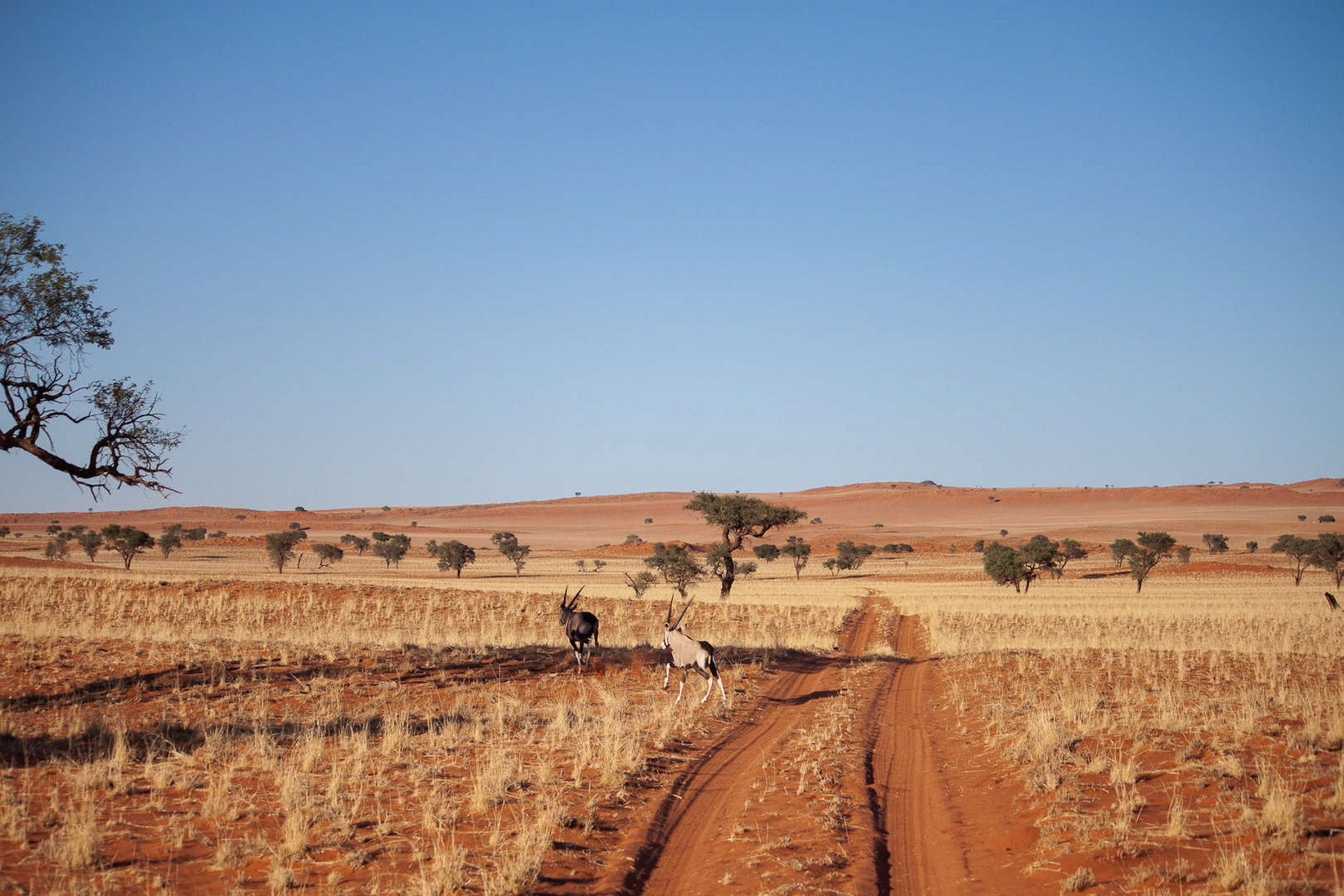
14 Days, 72 Hours Driving, 4,274 Kilometers, and Only 1 Big Complaint
This Namibia blog shares the highlights, lowlights, and honest insights of our two-week itinerary. See our Namibia Travel Tips , Cape Town to Namibia Guide , and Is Namibia Worth Visiting? for more trip-planning info.
There's only one thing that could've made our Namibia road trip itinerary better.
Other than it, our itinerary was fantastic and we have no real regrets. Given our limited time and budget, we discovered as much of Namibia as we could have hoped. We saw more than our share of dunes, animals, cool plants, and unusual landscapes.
This one thing— our one BIG complaint—was the roads . They're miserable, torturous, wretched, and evil.
Maybe by the time you read this the Namibian government will have gotten their act together and graded them. Either that or hovercrafts will have become affordable to rent.
The latter's probably more likely.
Whatever the case, use this travel blog of our Namibian itinerary to plan yours as perfectly as possible.

Namibia Itinerary Outline
Skip Day 1 if you're not coming from Cape Town like we did.
- Day 1: Cape Town to Vredendal (Day Rating: 7/10)
- Day 2: Orange River (6.5/10)
- Day 3: Fish River Canyon and Aus (8/10)
- Day 4: Namibrand (7.5/10)
- Day 5: Sossusvlei (6/10)
- Day 6: Camp Gecko (7.5/10)
- Day 7: Moon Landscape (5/10)
- Day 8: Swakopmund (6/10)
- Day 9: Spitzkoppe (7/10)
- Day 10: Kamanjab (5/10)
- Day 11: Etosha (the Good Day) (7.5/10)
- Day 12: Etosha (the Bad Day) (5/10)
- Day 13: Windhoek (5/10)
- Day 14: Departure (3/10)
Namibia Blog Day 1: Cape Town to Vredendal
369 km in 5 hours.
So Naive, So Innocent
How sweetly naive we were when we complained that the dirt roads into and out of Lamberts Bay were rough.
By the end of our trip, we would've given our left thumbs for all the roads in Namibia to have been so good.

Fryers Cove
Our biggest highlight of the day was Fryers Cove , "the world's only vineyard this close to the Atlantic Ocean." The tasting room, on a fishing pier beside a lighthouse and an abalone farm, seemed better suited for a fish and chips restaurant, which made it so special.
So special that it easily made our list of the 10 Most Unique and Unforgettable Wine Tastings in South Africa .
Lambert's Bay
Tasting at Teubes Family Wines' at Lambert's Bay surprised us in a couple ways too. First, the lady who led the tasting is studying to be a sommelier but… she doesn't even drink! Second, Lambert's Bay seemed like a funky, fun town with plenty of good restaurants—notably seaside Muisbosskerm.
If we return to Cape Town, we'll come for a weekend.
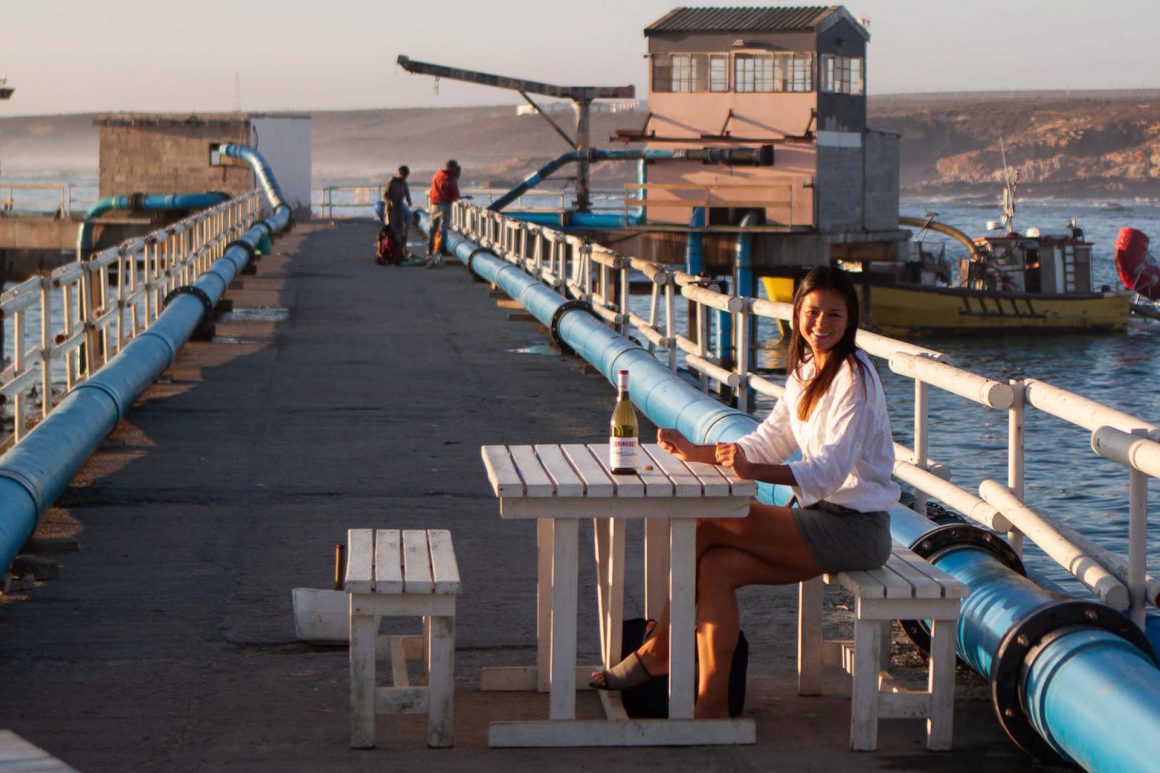
Fast Forward:
- Highlights: Wine tasting at Friar’s Cove.
- Lowlights: Losing precious wine tasting time waiting for the rental car company to get our paperwork in order.
- Best Food: Chef Keith Burger for me and hake for Kim at Thi Art in Vredendal, which looks like a strip-mall restaurant but doesn't act like it.
- Where We Stayed: Super friendly Airbnb in Vredendal
- Road Quality: About 150km of good-quality dirt road. The rest was paved.
- Day Rating: 7. If only we could've hit the road sooner.
Quick Tip: Load up on wine during this day if you're doing your Namibia road trip from Cape Town because selection decreases and prices increase as soon as you cross the border.
Bonus Ideas if Coming from South Africa
We skipped a ton of huge highlights north of Cape Town because we'd done them previously and wanted to try new things. Strongly consider adding these to your itinerary:
- Darling for its brewery, sweet shop, wine farms, and, especially Pieter-Dirk Uys ' satirical Evita Se Perron performances
- Cederberg , especially around the Sanddrif Resort , where there's an awesome swimming hole, some fun hikes (Wolfberg cracks was much more of an adventure and challenge than we expected), and where they produce excellent wine and beer that's perfect for late-day refreshments.
- West Coast National Park . Worth it for the wildlife, flamingos viewed from lagoon bird hides, easily-accessed hilltop viewpoints, and colorful lagoon.
- Paternoster . A few quirky shops, a nice beach, and a very famous restaurant, Wolfgat .
And definitely read our tips specifically for Cape Town to Namibia road trips.
Namibia Itinerary Day 2: Orange River
426 km in 4.5 hours.
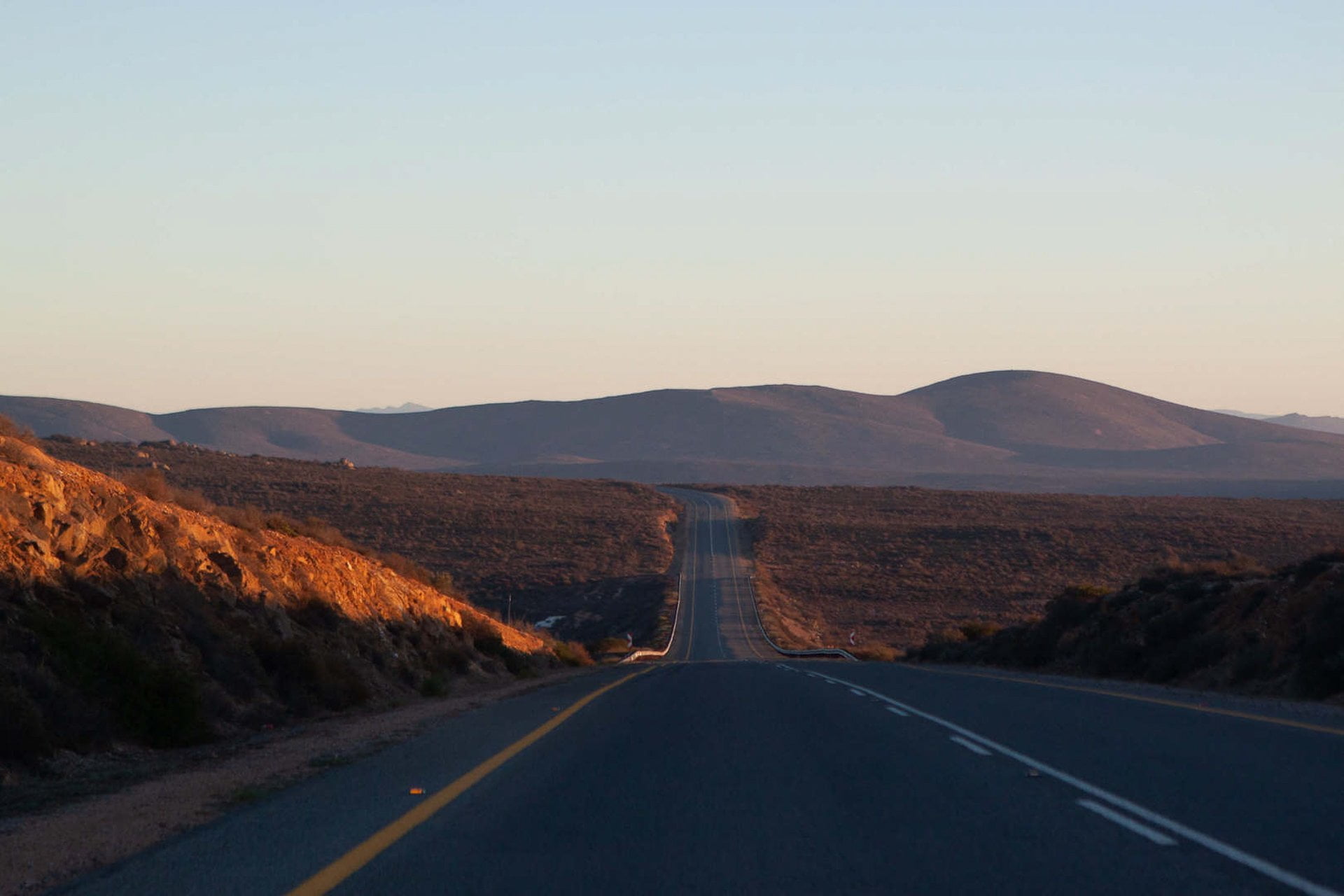
Goodbye South Africa
We felt nostalgic on this last day of our six "hectic" months in South Africa.
And it ended with a whimper.
There wasn't much to see on the long highway between Vredendal and Springbok.
But the scenery stepped it up a notch and gave a glimpse of what was to come as we approached the South Africa-Namibia border at Noordoewer, which we crossed with surprisingly little fuss.

Orange River Kayaking and Chilling
After a quick check in at Felix Unite, change, and sunscreen lather, we followed our guide Beaumaris on a 3-kilometer paddle down the Orange River. There were a couple of rapids but nothing strong enough to flip our boat, even though we hit pretty much every rock along the way.
A van picked us up at Amanzi Trails, which had nicer campsites than Felix Unite but none of the amenities, and drove us back, where we chilled by the river and the pool, played some pool, enjoyed a sunset drink, and had a fairly-priced meal at the restaurant.

- Highlights: Kayaking on the Orange River. It didn't live up to all the praise our friends had given it but was definitely a nice way to spend a couple of active hours.
- Lowlights: The lack of attractions on the long road between Vredendal and the South Africa-Namibia border. Unable to find an interesting restaurant, we resorted eating take-out supermarket lasagna at a highway-side rest stop.
- Best Food: Kim's chicken caesar salad at Felix Unite. I had the "famous" peri-peri chicken, which wasn't worth the extra wait.
- Where We Stayed: A bungalow at the Felix Unite Provenance Camp , whose pool, restaurant, bar, and riverside location were perfect for rinsing off and fueling up for the dusty deserts of Namibia.
- Road Quality: 100% paved roads.
- Day Rating: 6.5. Relaxing, almost too much so for our tastes.
Quick Tip: Fill up on gas on the Namibian side of the border, where the price per liter is quite a bit cheaper.
Namibia Blog Day 3: Fish River Canyon to Aus
513 km in 6.5 hours
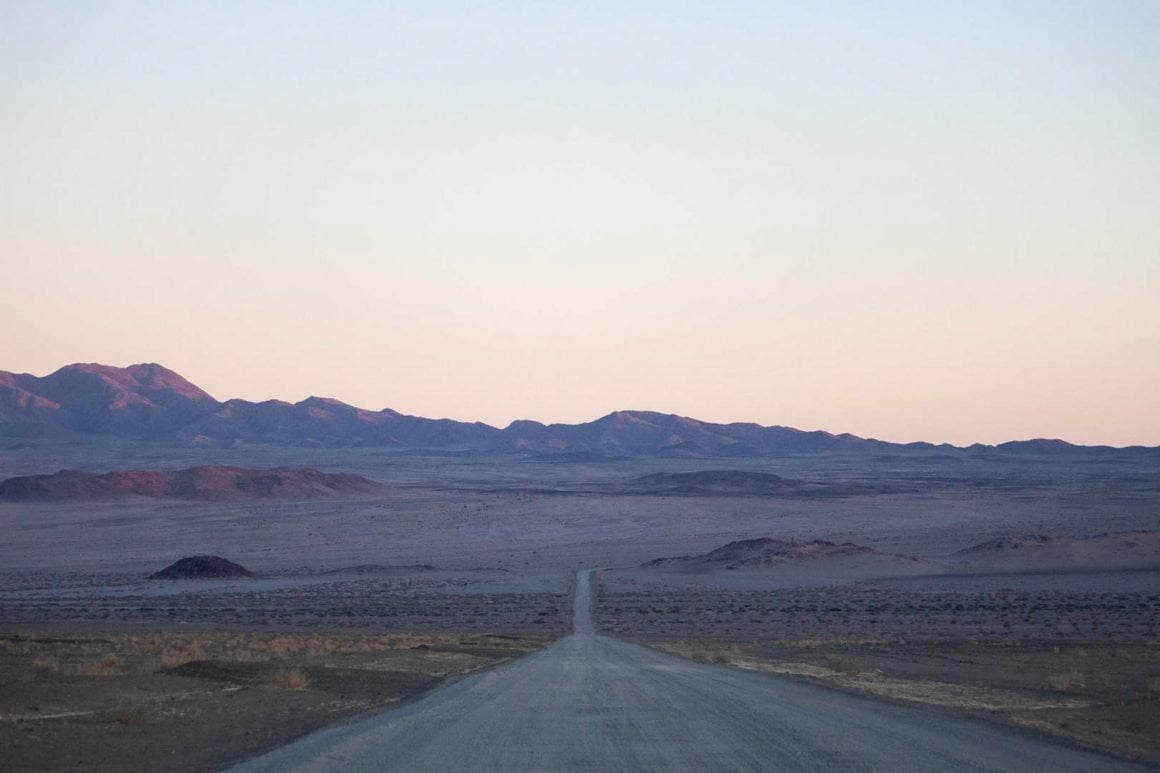
A Great Start
Enhancing our eager anticipation as we ventured into Namibia's desert for the first time was the fact that we couldn't see anything but stars in the pitch-black early morning.
As we passed the gas-station-less settlement of Aussenkehr, the sun broke the horizon and we had to turn off our audiobook to fully embrace the awe-inspiring scenery that we had all to ourselves. Optimistically, we thought this was just the beginning and expected the rest of our Namibia road trip to get better and better.
This section of road ended up being the most pleasant of our entire trip , largely because we were all alone and the roads weren't trashed by a steady stream of tourists in camper trucks.
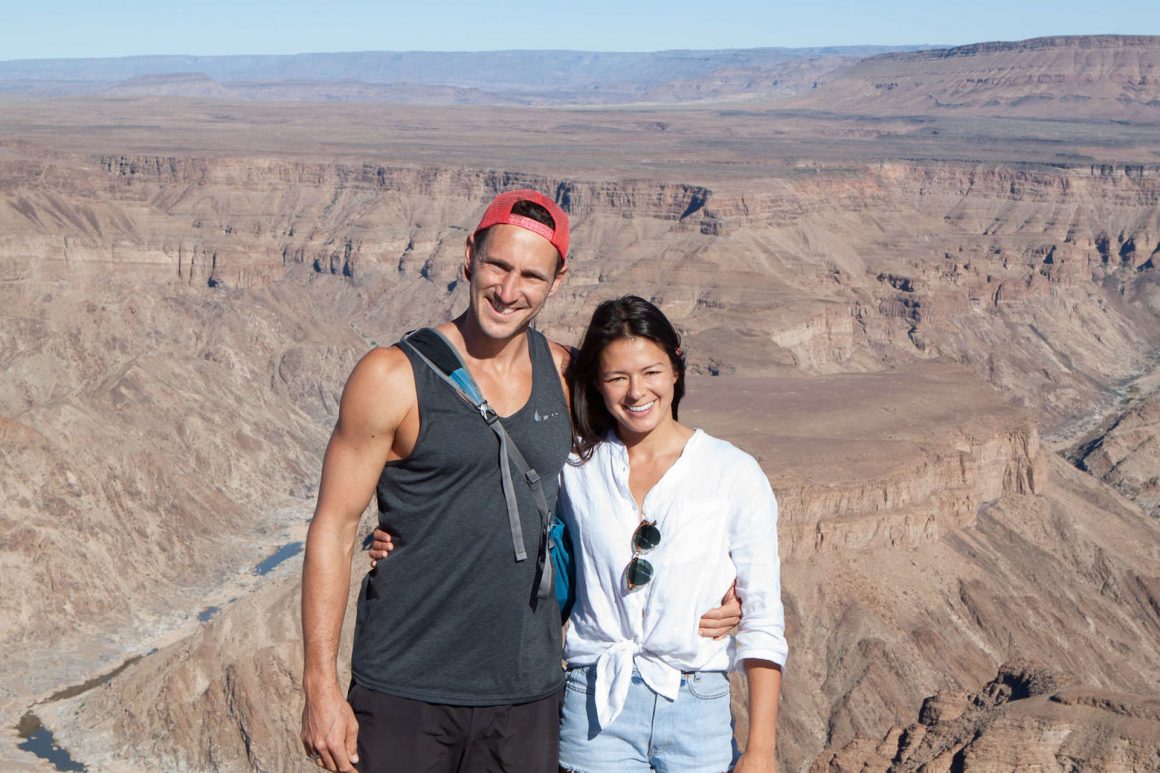
Fish River Canyon
We arrived at Fish River Canyon three hours after setting off.
The view of the canyon didn't take our breaths away, as the breathless blogs and guides claimed. But at least we had the opportunity to stretch our legs on the ridge trail and take photos of the canyon and the quiver tree beside it.

We stopped at Cañon Roadhouse , which is as kitschy as advertised and had better-than-expected homemade burgers, then at Naute Kristall Distillery , where the owner Katherine gave us samples of a variety of schnapps and the world's only date cognac.
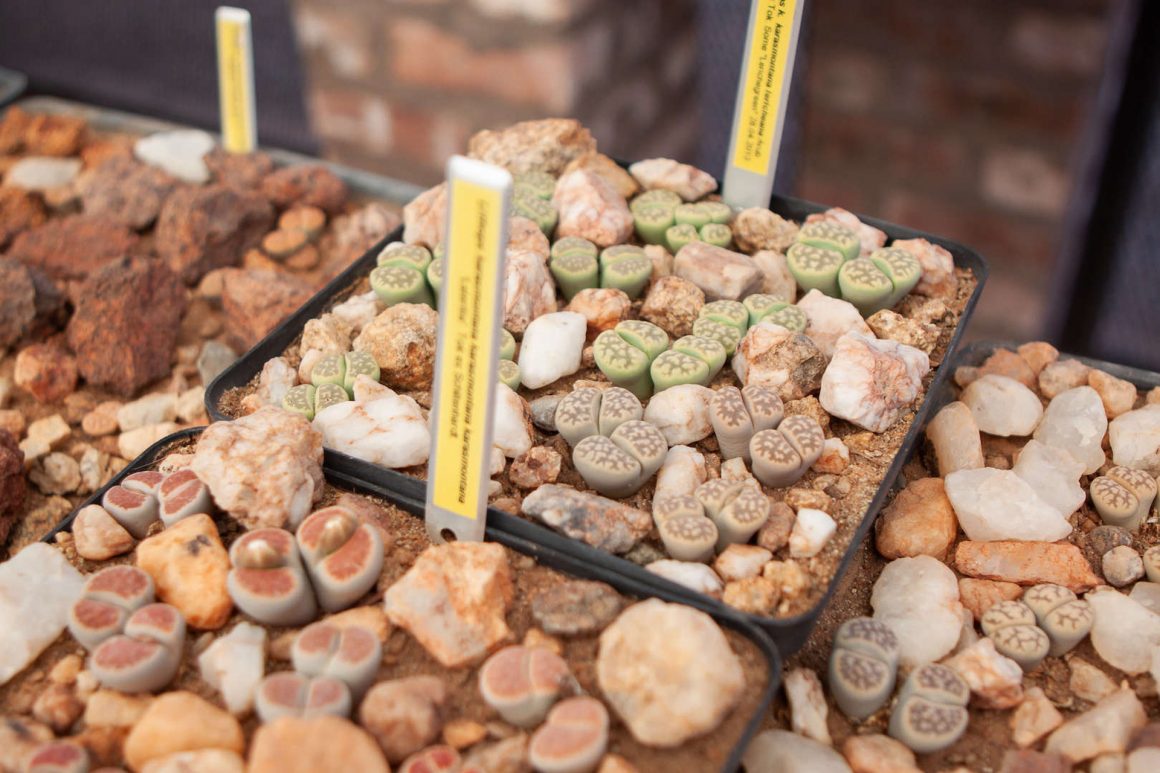
On Katherine's suggestion, our next stop was Alte Kalkofen , home of the world's only lithop sanctuary… which probably means as little to you as it did to us.
We'd never heard of these crazy little "living stones" before, either.
But as soon as the manager Marika led us into the nursery and explained lithops to us, we were enthralled. Some looked like hippos' mouths, some like brains, others like rocks, and they were all so delightfully weird.
We had some apple pie at Alte Kalkofen's restaurant, thinking the cabins there would be a good spot to spend a night if we ever returned, then drove on to the one-garage, one-shop, one-restaurant town of Aus, where we took advantage of each of those establishments.
The food at the restaurant, part of the Banhof Hotel, was good if a little overpriced.
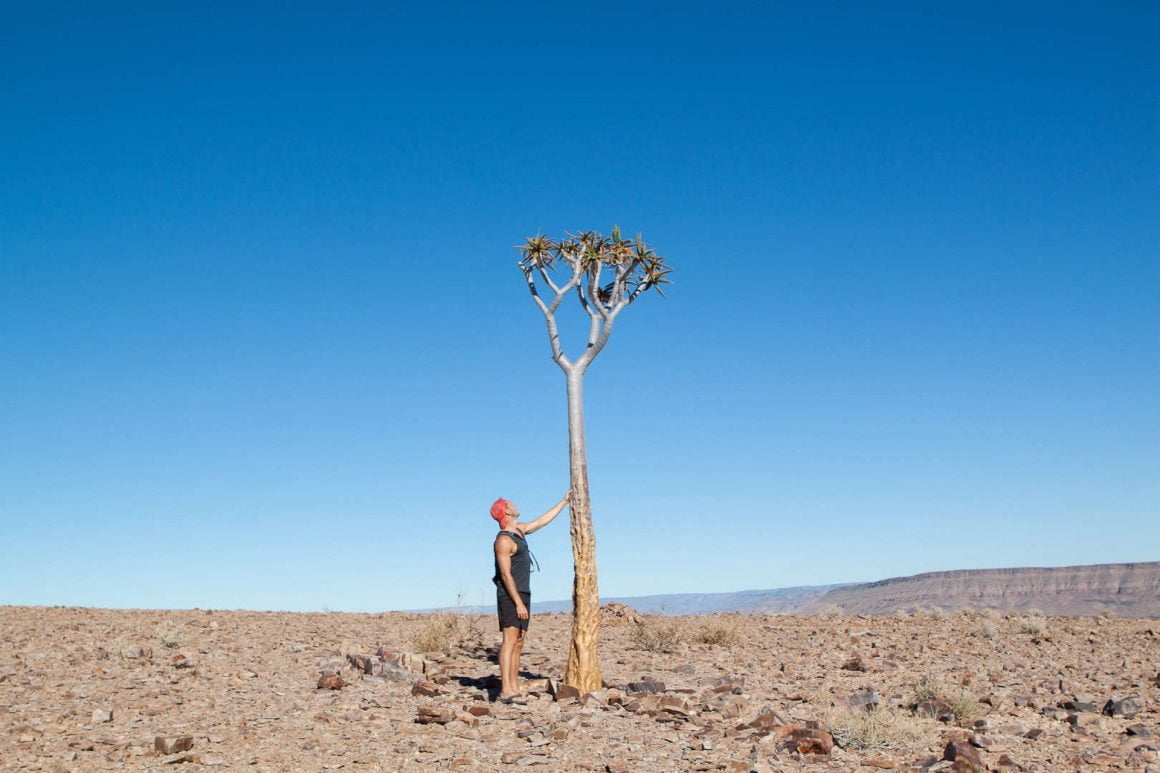
- Highlights: The lithop sanctuary at Alte Kalkofen and the early morning drive from Orange River towards the canyon.
- Lowlights: The Fish River Canyon wasn't a negative, but it didn't impress us as much as the bad road into it from Hobas annoyed us.
- Best Food: The apple pie at Alte Kalkofen was the best of our Namibia road trip.
- Where We Stayed: Airbnb in Aus .
- Road Quality: Good quality dirt road with a big exception of the road between Hobas and Fish River Canyon. The last 180km to Aus on the B4 is paved.
- Day Rating: 8. Pleasant surprises and mostly good roads made for one of the best days of our entire Namibia road trip.
Quick Tip: Fuel up and take some air out of your tires in Noordoewer because the next garage isn't until the Cañon Roadhouse.
Namibia Blog Day 4: NamibRand
275km in 6 hours.

Klein Aus Vista Hiking
Once again, we got up before the sun to go for an early-morning hike at Klein Aus Vista and get a head start on what we had been warned would be a long day of driving.
The 1-hour, 6-kilometer Mountain Trail hike at Klein Aus Vista wasn't nearly as noteworthy as ones we were to do later in our trip at Spitzkoppe, Sossusvlei, and Goanikontes, but the setting of the cabins they have there is worth considering a night or two.
Helmeringhausen
After showering back at our Airbnb and buying supplies for tonight's braai (a.k.a. barbecue), we took off for a slow, empty, initially-interesting-but-soon-becoming-boring ride north.
The drive was made extra slow by Kim's cautiousness (today was her turn to drive) more so than the quality of the dirt roads, which was fine.
Just over 100 km in, we hit Helmeringhausen , another middle-of-nowhere outpost like Canon Roadhouse and Solitaire that somehow was busy with a couple of busloads full of French and German tourists. We had another self-proclaimed "best apple pie in the world," which wasn't as good as yesterday's from Alte Kalkofen, then hit the road.
And the road hit us back.
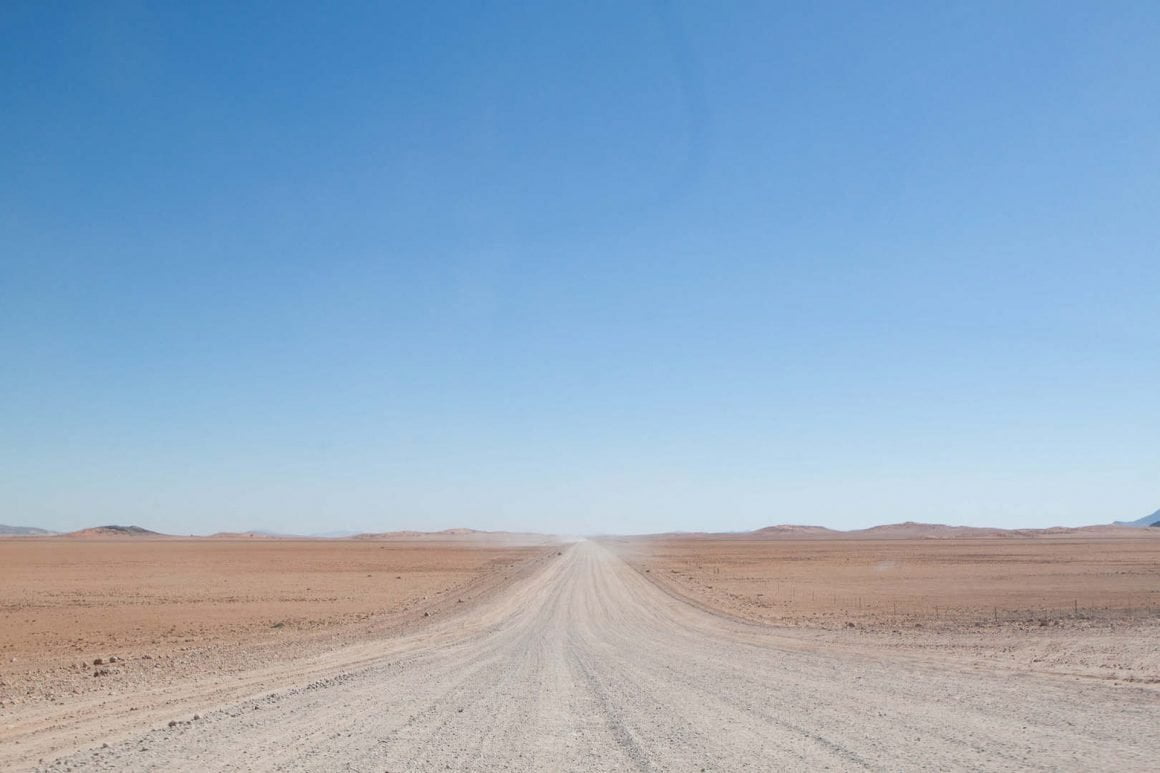
Namibian Desert Torture Begins
From Helmeringhausen, the road steadily deteriorated for four hours. We felt each and every one of those 14,400 seconds. Eventually, our speed (around 35 km/h) was lower than the temperature outside (around 40°C).
I coined it "Namibian desert torture," a dry version of Chinese water torture that we were to face a lot of in the coming days of our Namibian road trip.
But in this case our destination, NamibRand Family Hideout , made it all worthwhile.
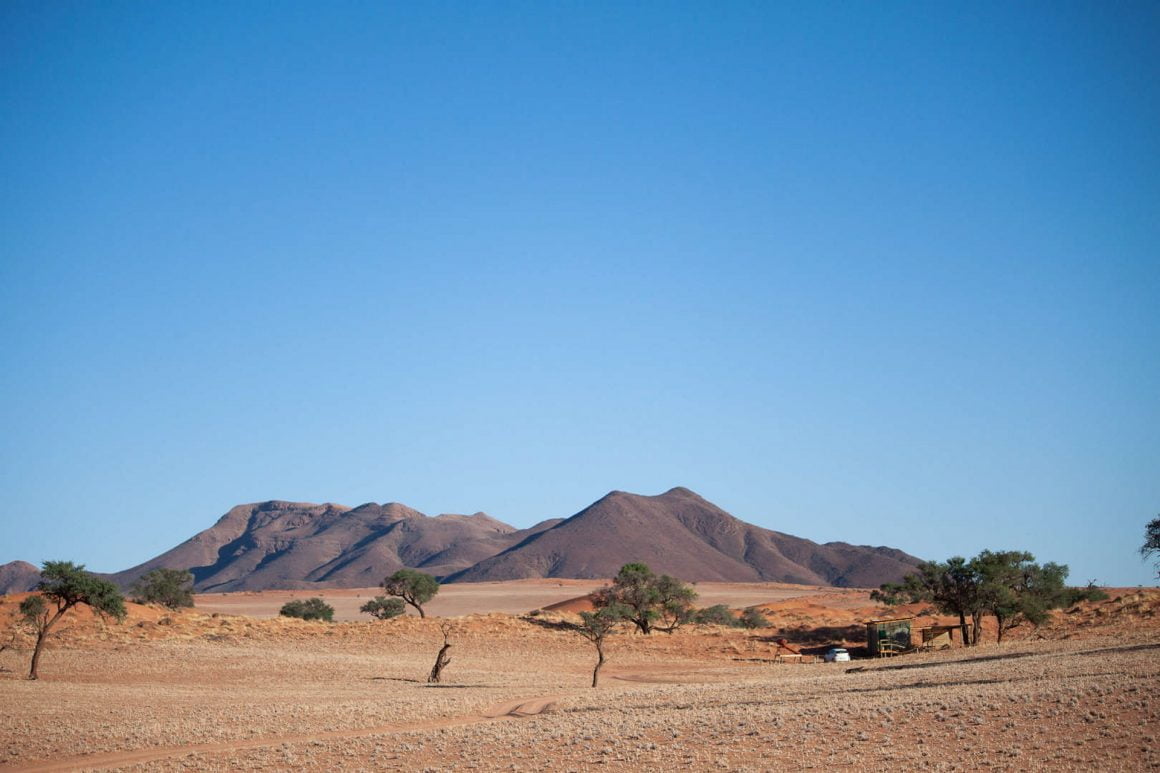
NamibRand Family Hideout
Our Venus campsite was in the middle of nowhere with a huge private bathroom area that we could've easily slept in and backed by our own private sand dunes.

At sunset, we brought a blanket and the bottle of Hectic Route wine we'd saved for a special occasion to the top of the dunes.
And man was this occasion, with the 360-degree views of the technicolor desert and not another human in sight, special.
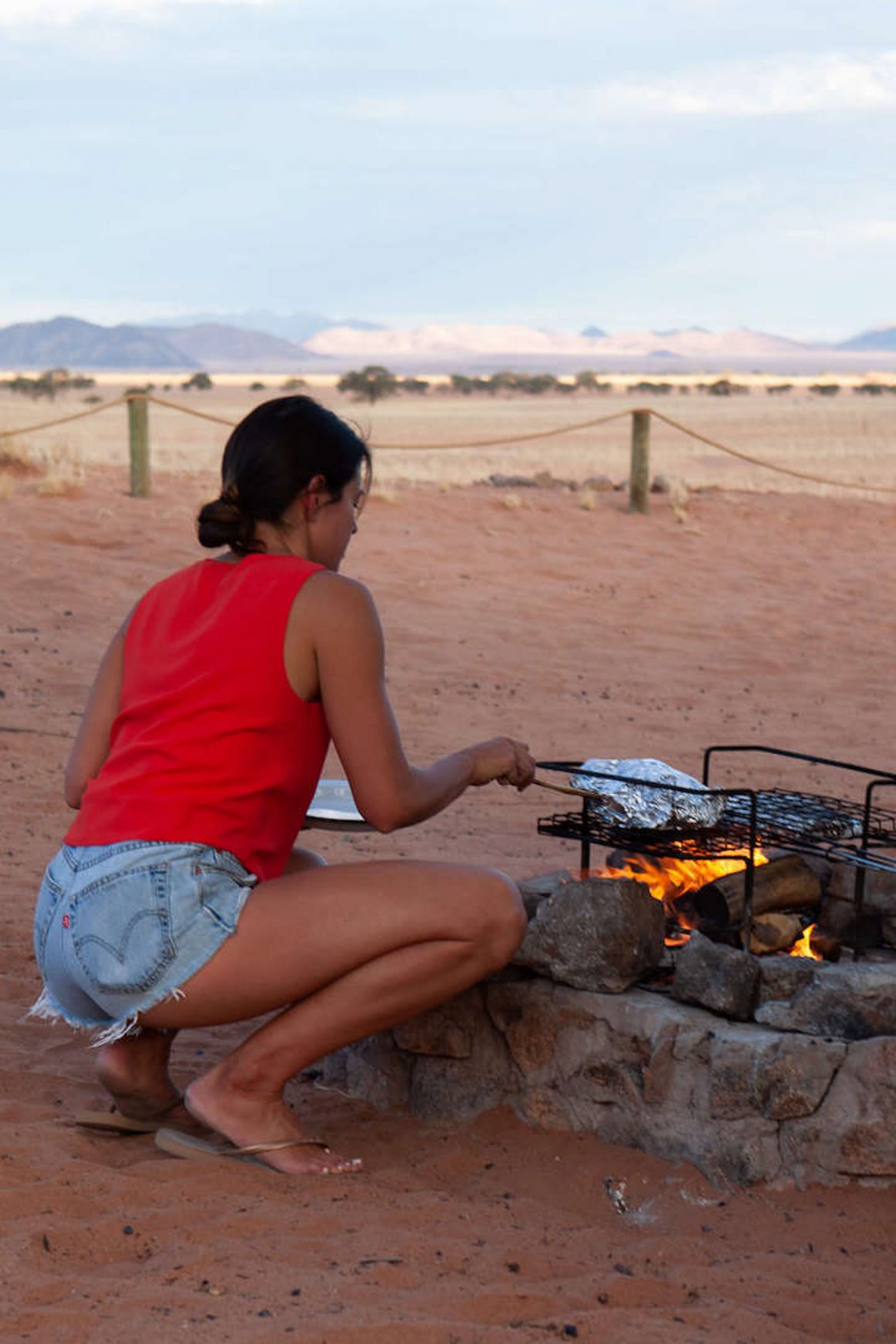
Amateur Campers
This was our first night camping of our Namibia road trip and it showed.
Our biggest mistake was not bringing any fire starter. The bag of wood we bought only had big pieces that a match could never get aflame and, since we were in the middle of the desert, finding kindling was a major challenge. We resorted to using up almost all our matches and every piece of paper we could scrounge up to get it started.
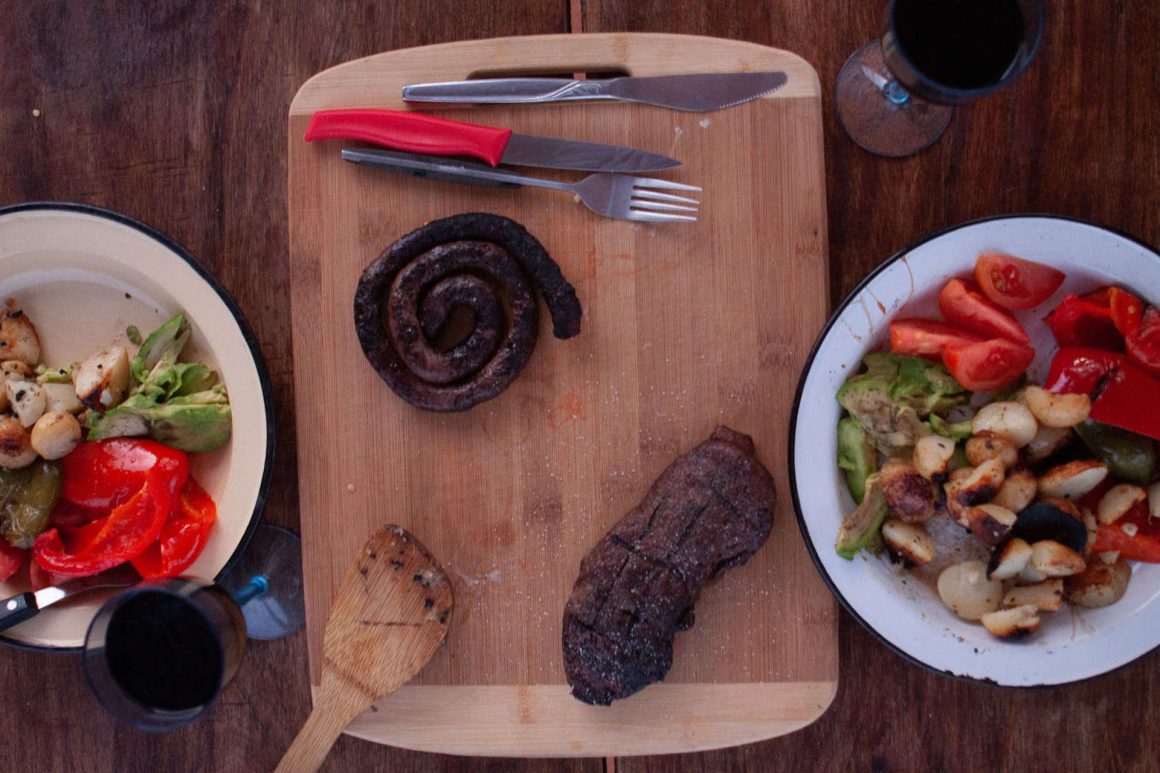
Dinner Under the Stars
Once we got the fire going, Kim worked her magic and made us a magnificent meal that we ate under the stars.
We were all alone…
…aside from a bunch of fearless dune hairy-footed gerbils (mice with a fancy name) that at first were cute but soon became a nuisance for nibbling at our feet.
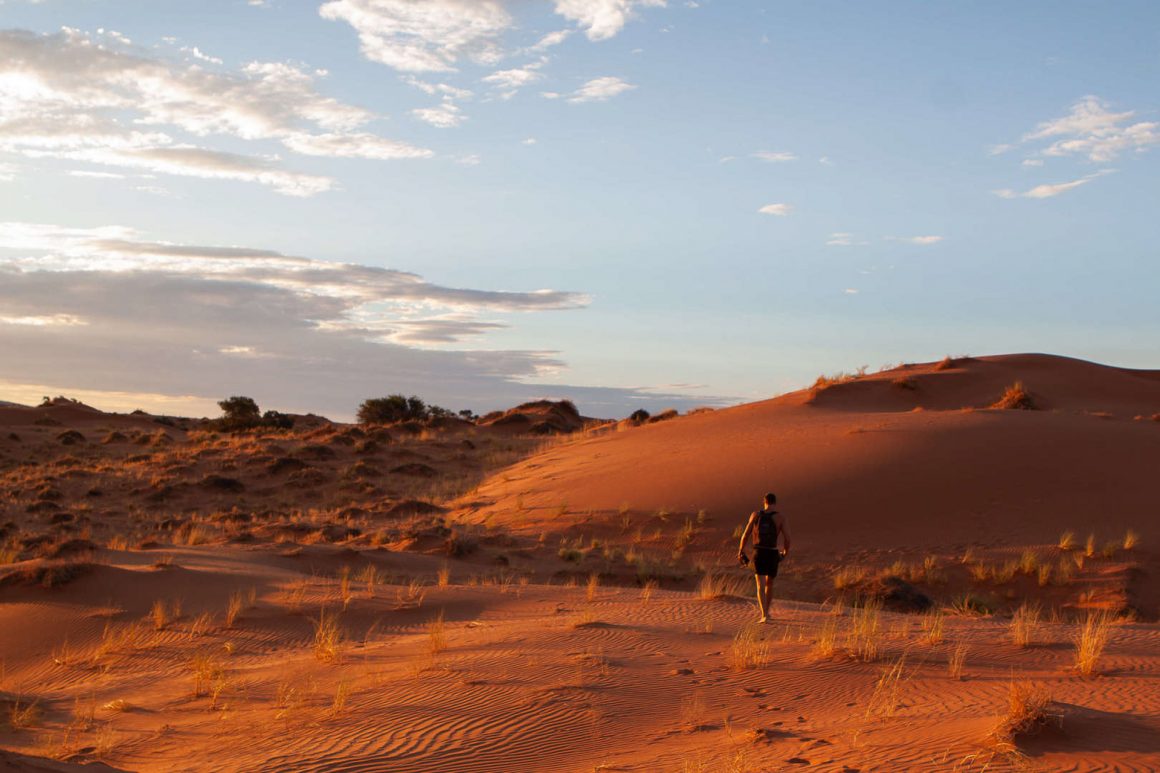
- Highlights: Dune-top sunset views and wine at NamibRand Family Hideout will likely remain our most lasting positive memory or our entire Namibia road trip.
- Lowlights: The frustration of trying to make a fire without fire starter.
- Best Food: The meat, veggies, and potatoes Kim made over the braai were worth the struggle to get the fire going.
- Where We Stayed: NamibRand Family Hideout's Venus campsite.
- Road Quality: Ok to start then degrading down to really bad by the end.
- Day Rating: 7.5. The road took away from what would otherwise be an unforgettable day.
Quick Tip: NamibRand doesn't sell wood or food, so buy everything beforehand, including some fire starter.
Namibia Itinerary Day 5: Sossusvlei
279 km in 5.5 hours
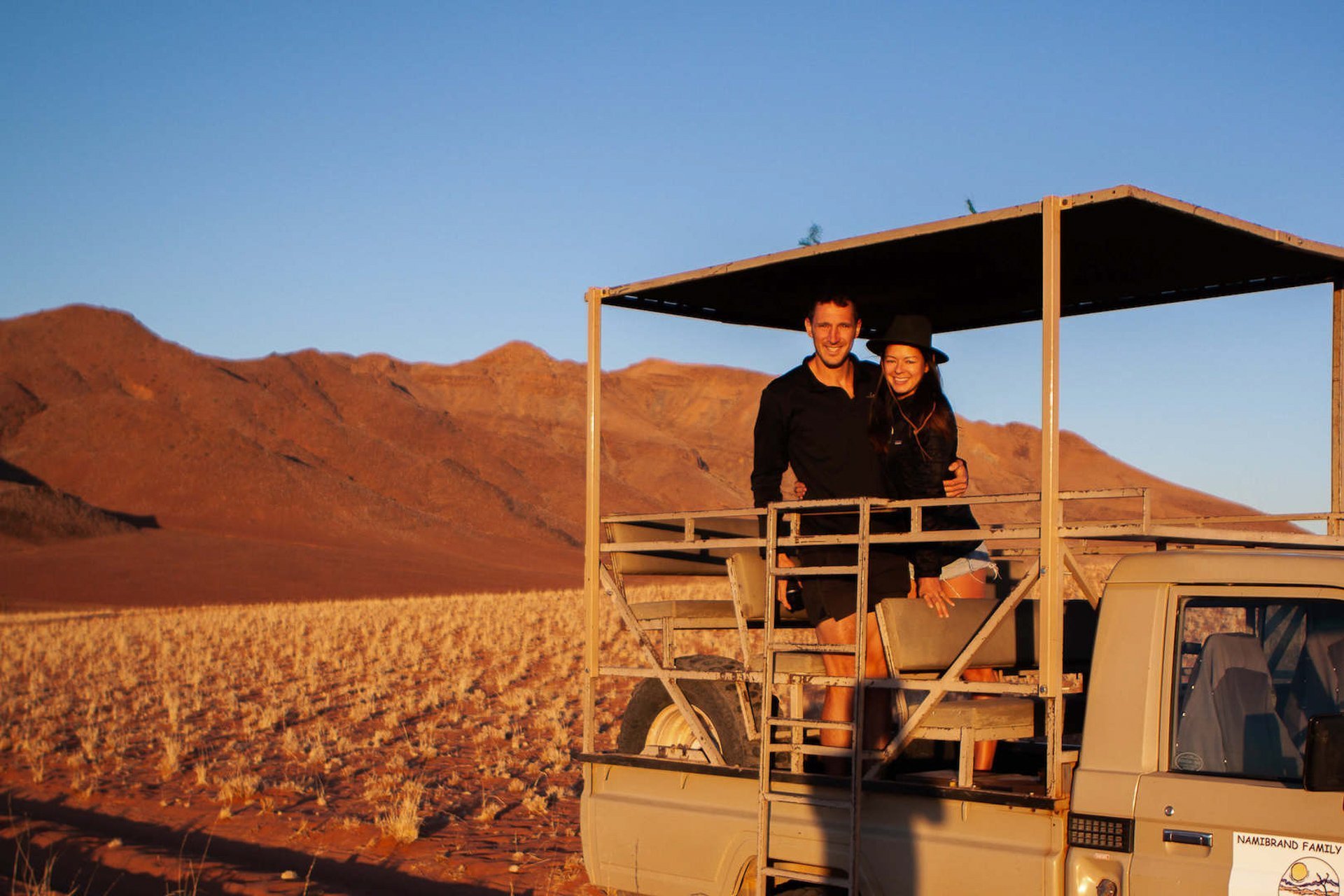
Cornelius from NamibRand Family Hideout came over in the early morning to show us around the reserve. As the sun started to shine on the desert in a display that equaled last night's performance, Cornelius also enlightened us. He taught the history of these, the oldest dunes in the world, and interesting facts about the plant and wildlife.
We would've loved to spend another day in paradise at NamibRand , but we had to pack up and leave for another looooong drive.
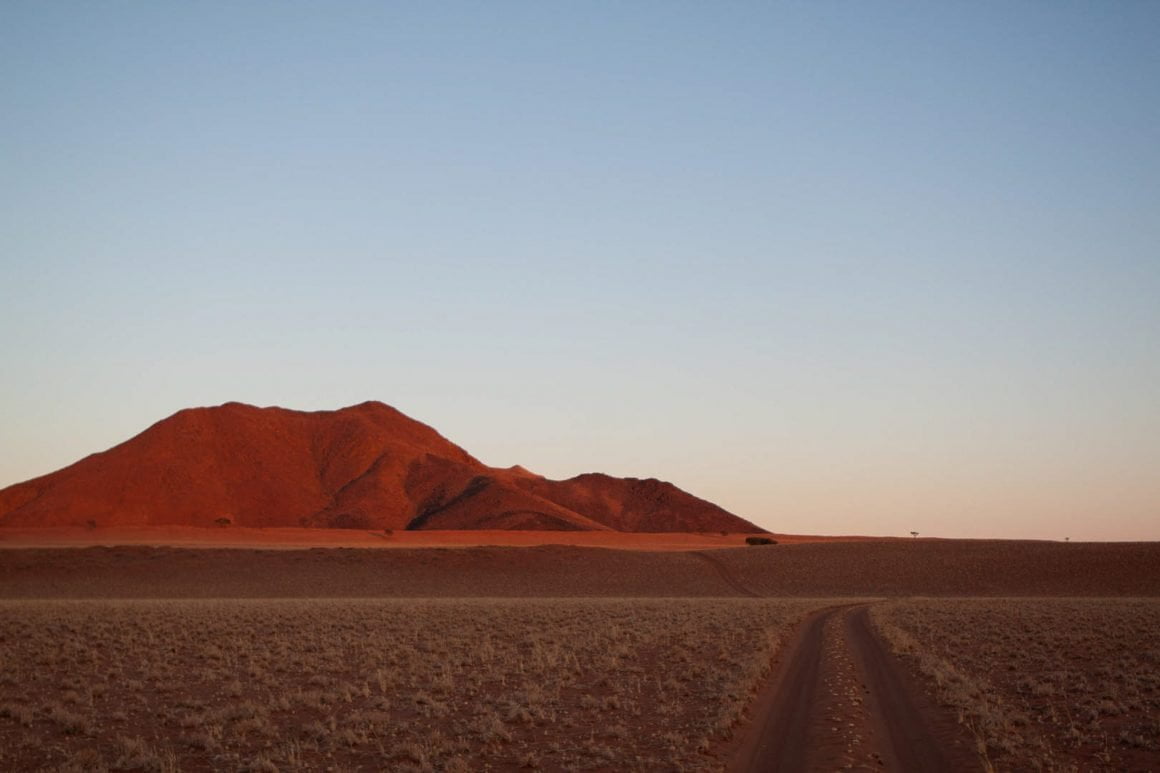
Following Cornelius' advice, we took the longer route from NamibRand to Sesriem , the gateway to the famous sand dunes of Sossusvlei , along the D827 instead of the D27 (which a couple we met later confirmed was virtually impassable).
The D827 was in decent shape but the C19 and then the D826 into Sesriem was a different story.
What may one day have been a road had devolved into a sea of sharp gravel and stones with waves of corrugations that endlessly ate away at our good mood until we were at each others' throats.
Even as the scenic dunes of Sossusvlei and the colorful Naukluft mountains came into view, we could barely appreciate them because we were too distracted by the road.
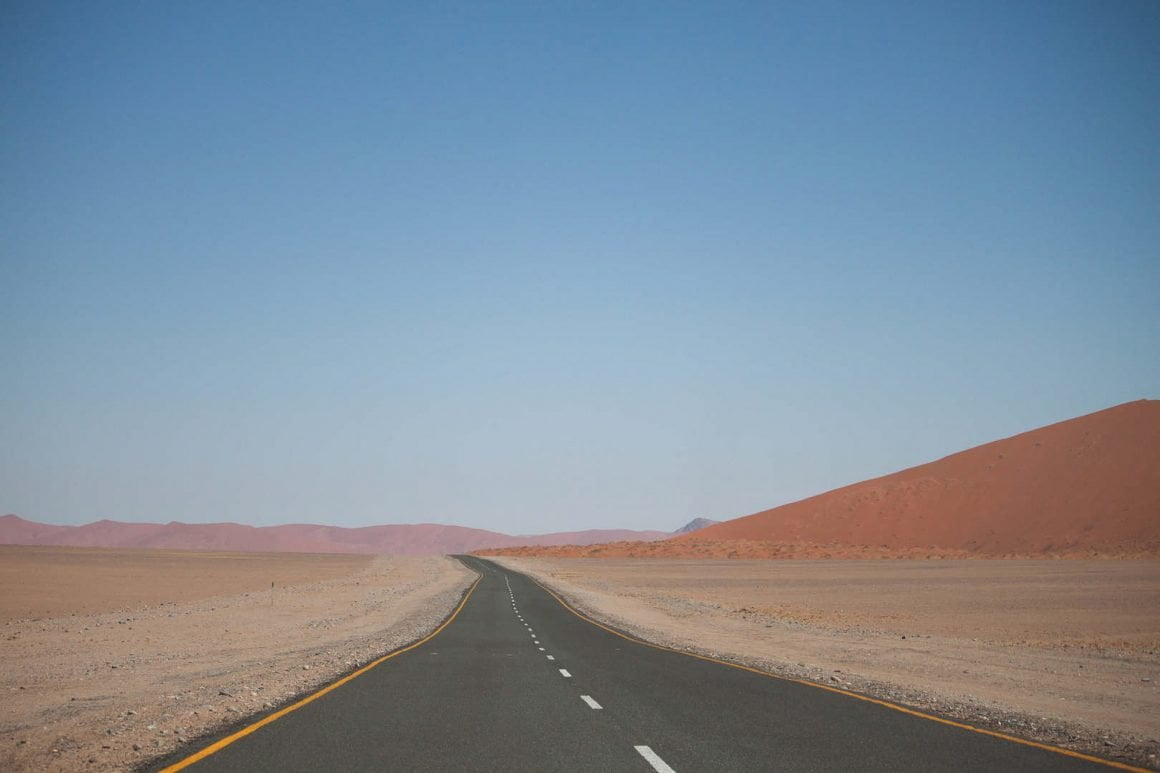
A Hard Truth in Sesriem
Once we finally arrived at Sesriem, we confronted a hard truth:
The gates only open at sunrise then it's 60km from there to the dunes, so even if we got to the entrance ahead of the other 60 to 100 other cars who start lining up as early as 1.5 hours in advance, there was no way to truly see the dunes in the perfect light.
Well, no way other than staying inside the gates at the official NWR (Namibia Wildlife Resorts) camp , whose spots had sold out months ago.
Sunset was out of the question too . Sesriem's gates close before sunset, which at this time of year meant 6:30 pm.
So we swallowed this hard truth we made what turned out to be an excellent decision….

We went to the dunes in the middle of the day.
We were car number 146, but almost everyone before us had already come and went. There were only a few cars on the perfectly paved road to the dunes and only two others at the parking lot at the end of it, where we were all alone on the overpriced (170 each) but necessary shuttle to Sossusvlei.
From the shuttle drop-off point, it was a 1.1km walk in 39.5°C (103°F) heat through the sand to Deadvlei .
At least it was a dry heat and there was a bit of a breeze so I barely broke a sweat. Kim didn't tolerate the heat as well, but not enough to affect her mood.
There was only another pair of friends when we got to Deadvlei. We took photos for each other then they left and we had the whole place, Namibia's number one tourist attraction, to ourselves!
It's like being alone in Machu Picchu, the Great Wall of China, or the Pyramids. We couldn't believe it.
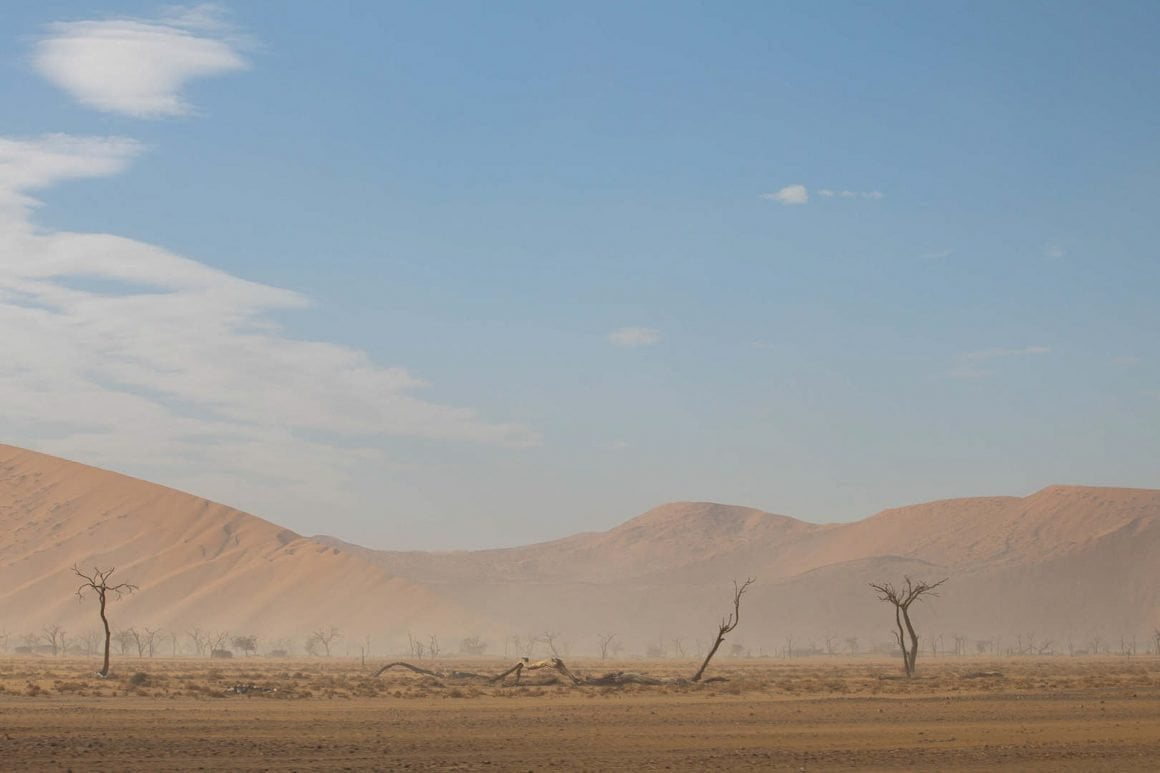
Unwinding in the Wind
On our drive back to Sesriem the breeze became a full-on sand storm and we could barely make out the dunes to the side of the highway.
It also made it impossible for us to start a fire back at our camp, Sossus Oasis , so we settled on buying some crappy bread and making sandwiches in front of the gas station.
On the table beside us was a group of cyclists who'd come all the way from Egypt on a Cairo to Cape Town tour . They told us the road they'd just cycled—the same as we had come in on—were easily the worst they'd encountered.
Way to go Namibia!
Congrats on the ignominious title of having worst roads in Africa.

- Highlights: Having Deadvlei all to ourselves at 3 p.m. in the afternoon.
- Lowlights: The C19 "highway" didn't break our car but certainly broke our spirits.
- Best Food: Macadamia nuts we brought with us from Cape Town.
- Where We Stayed: Sossus Oasis . Nothing special, but the best alternative to the NWR Campsite inside the gates.
- Road Quality: The worst. Like driving in a gravel pit.
- Day Rating: 6. The undeniable highlight of Sossusvlei couldn't overcome the lows of the bad roads.
Quick Tip: The Sossusvlei sand's hot in the middle of the day, so wear decent walking shoes if you want to hike around the dunes.
Namibia Itinerary Day 6: Camp Gecko
178 km in 4.5 hours

Road Blocked
As we left Sesriem after sunset and just as the Sossusvlei gates opened, we counted 56 trucks in line, waiting to race each other and the sun for photos. This reinforced our happiness for deciding to go yesterday afternoon instead.
The shitty roads quickly stole that happiness from us.
Fed up, we stopped at the nearest lodge, Hoodia Desert Lodge , to ask the owner how the roads are between there and the Olive Trail we hoped to hike that morning.
She crushed our dreams.
Even with her top-notch off-road truck she told us she avoids that road, which is the direct route to Windhoek, to takes another that's twice as long and still no good but not as bad.
No Olive Trail for us. We took her advice and abandoned our plans.
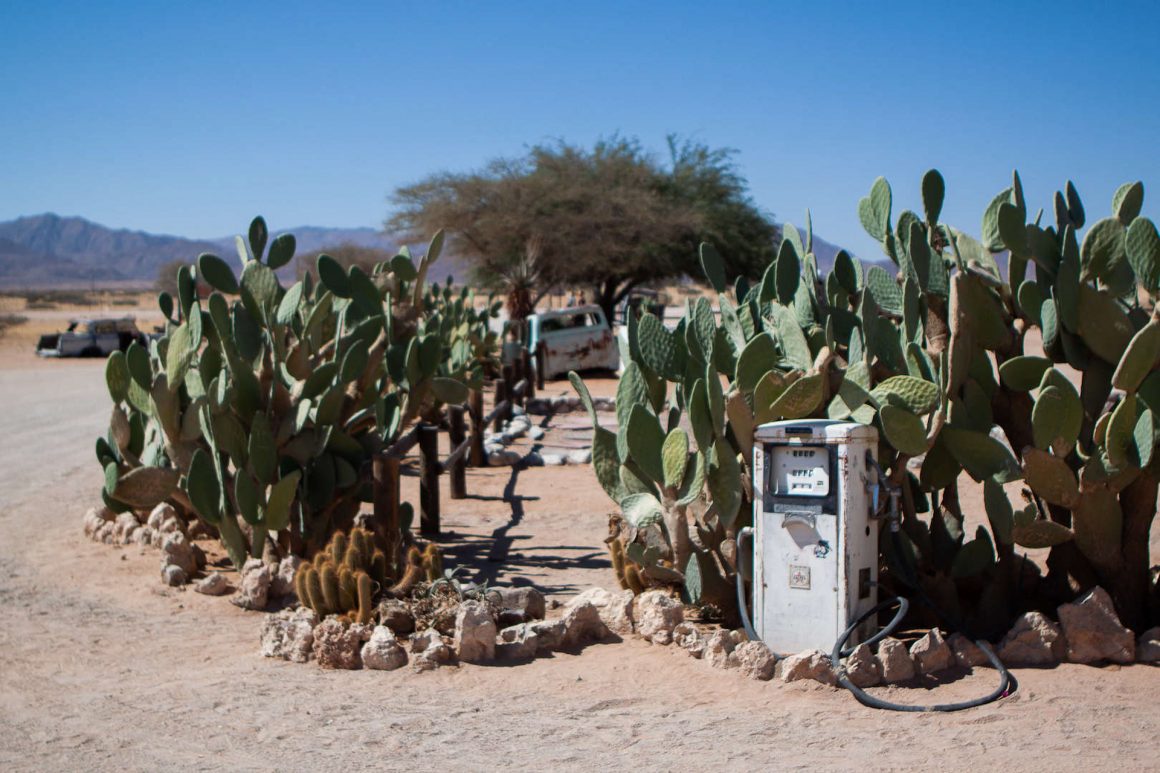
Three hours later, we got to Solitaire . As the only pit-stop between Sossusvlei and Swakopmund, it may be in the middle of nowhere, but there was nothing solitary about it. Fellow road-shaken travelers were everywhere.
We had a snack at McGregor's Bakery . The game meat pies (only NA$30 each) were much better than the chalky-crusted but once-renowned apple pie (NA$35).
And at the gas station ATM machine was broken. "Maybe later," said the employee we asked if it would be fixed anytime soon.
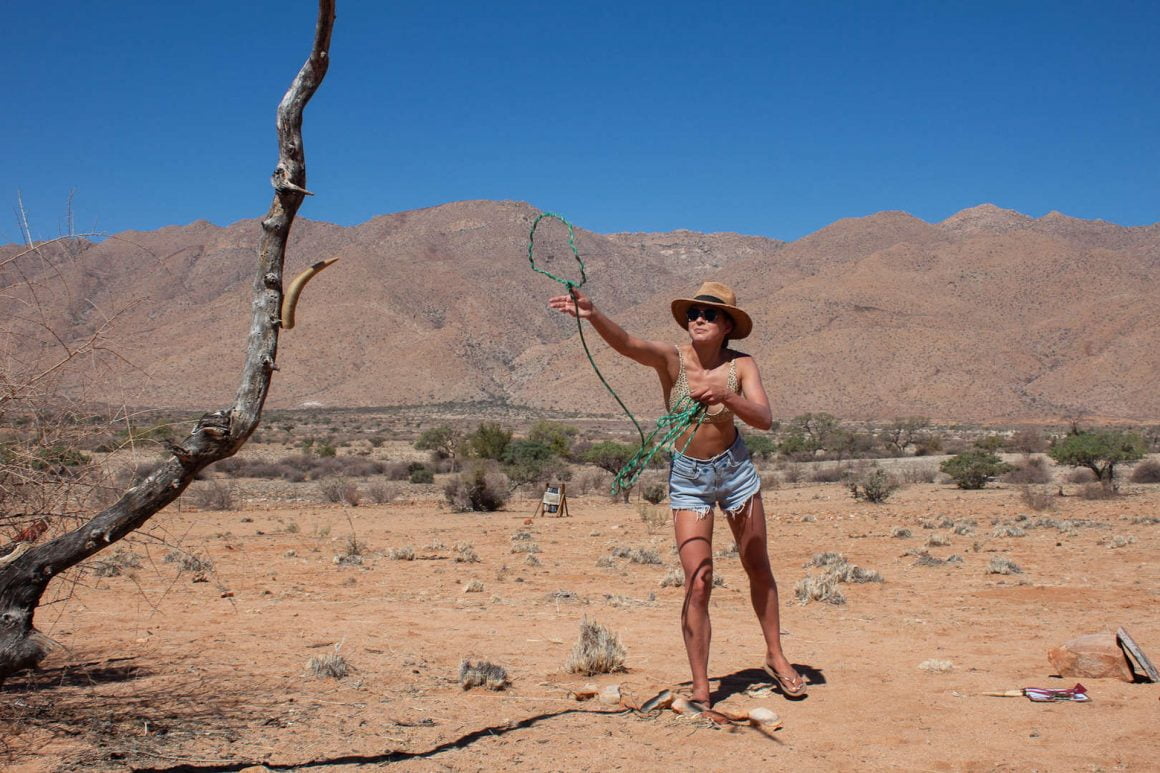
The roads improved after we turned off towards Camp Gecko , where we were spending the night.
Since we missed out on our hike, we did the fly-infested but entertainingly-interactive 3km Adventure Walk loop at the camp. The trail ended by the beautiful campsites on the other side of the hill that looked over a wild, 20 kilometer mountain-backed plain.
Our campsite was not nearly as beautiful but was close to the natural swimming pool, where we cooled off with the tadpoles.

Spreetshoogte Pass
With time to kill before dinner, we did the unthinkable:
We went for a drive.
Voluntarily.
Our Rough Guide , our hosts at Gecko, and a fellow camper all recommended Spreetshoogte Pass , so we folded ourselves back into our car to brave the roads again.
But the roads turned out to be fine on the 25-minute drive to and up the pass. The pass itself was even paved. And the late-afternoon views from up top were spectacular.

Back at the camp, we joined Camp Gecko's Swiss owners, Renee and Heidi, and an Austrian couple for a sunset drink then dinner in the spectacularly-situated lapa atop the hill.
The wood-fire-cooked oryx potjie ( oryx is an animal and potjie is a local stew) was extra tasty for us spice enthusiasts because Renee had mistaken chili for paprika.
It was a bit pricy (NA$250 each), but easily worth it for the chance to get to know Heidi and Renee, hear stories about their zaniest guests, and get the inside scoop on the struggles of trying to run a business in corrupt, inefficient Namibia.
- Highlights: Dinner and conversation at Camp Gecko. Honorable mention to Spreetshoogte Pass.
- Lowlights: Having to abandon our initial plans because of bad roads.
- Best Food: The meat pies at Solitaire.
- Where We Stayed: Camp Gecko campsite.
- Road Quality: More horribleness, but at least less time on it.
- Day Rating: 7.5
Quick Tip: Spreetshoogte Pass would be even more incredible at sunrise with the sun behind you. Try to plan an early morning breakfast at the picnic site there.
Namibia Blog Day 7: Moon Landscape
334 km in 7 hours
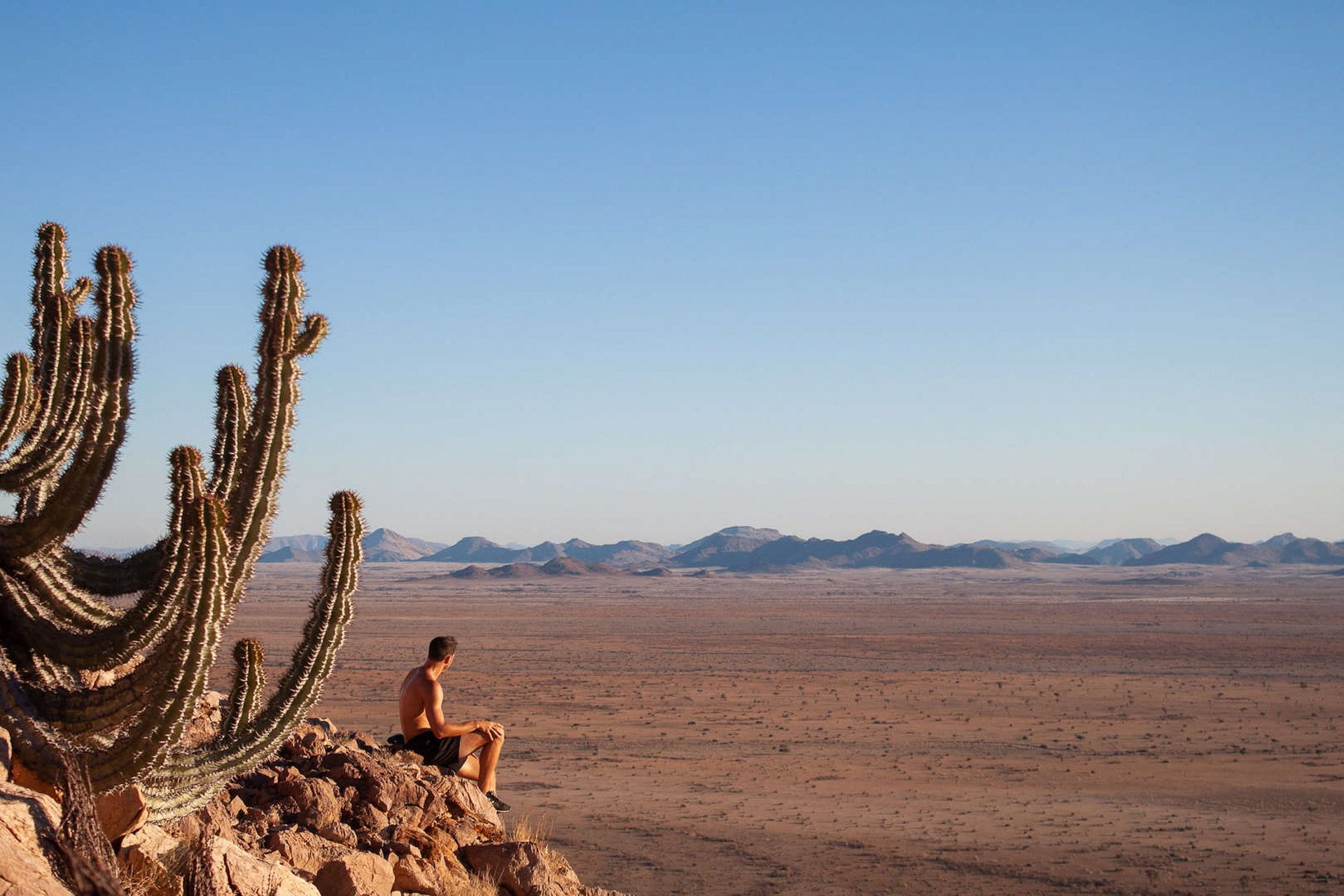
Zebra Mountain
Have you ever noticed that many places are named after animals you never actually see?
For example, we didn't see any geckos at Camp Gecko.
But Zebra Mountain, where we did a 3-hour morning hike, lived up to it's name.
There was no missing the zebras. It was so quiet out in the middle of desert scrub and rocks we could hear their footsteps and snorts from hundreds of meters away.
The quiet, the sunset, the animals, and the exercise was all magical.
Civilization
After four hours of miserable driving and one hour of regular paved road driving later, everything changed.
As we hit the coast, the weather went from dry and hellaciously hot to foggy and freezing. Relatively freezing. 15°C (60°F).
And we hit civilization.
Houses! Grass! People not in camping apparel! Other small sedans like ours! Traffic signals!
There was nothing appealing about the suburban spread of the Walvis Bay / Swakopmund area, but it was quite the contrast. We had pizzas at recently-opened Godenfang in Walvis Bay to mark the occasion.
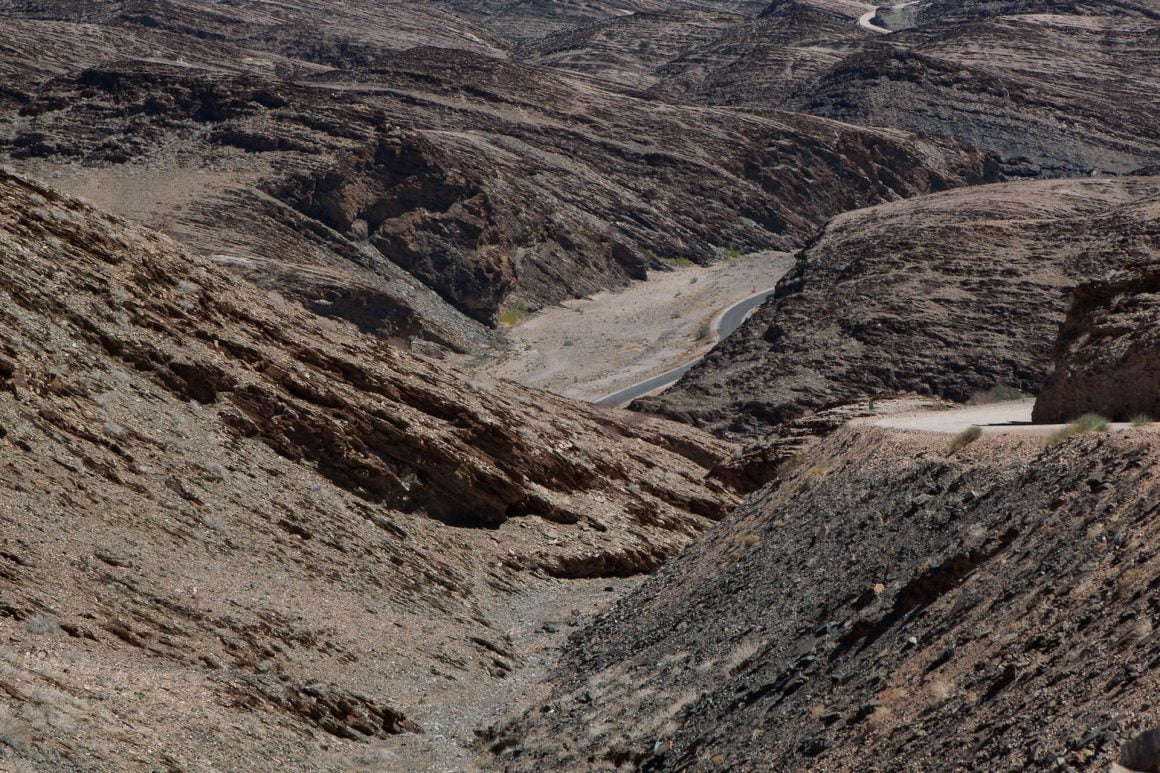
Dunes and the Moon
We passed two underrated landscapes after lunch.
First was the ocean-side dunes between Walvis Bay and Swakopmund. We'd heard about sandboarding and ATVing the dunes, but their proximity to the ocean and scope impressed us more than we'd expected.
Second, was the moon landscape . Before coming to Namibia we'd heard all about its unique landscapes, but not a peep about this one. To us, it was among the most unique as we'd seen, especially with the late-afternoon shadows.

Goanikontes
In the middle of the moon landscape, and only 30 minutes from Swakopmund on atypically well-maintained dirt roads, was Goanikontes Oasis . We were excited to spend a couple nights in one of its A-frame cabins there.
The friendly staff seemed excited to have us too. They welcomed us warmly and we had the pleasure of having a long chat with René, the matriarch of the family that recently purchased and refurbished the property.
It was actually more of a listen than a chat.
She entertained and impressed us with more tales of Namibian incompetence and her ability to work around it to get Goanikontes up and running so fast.
- Highlights: Hiking and zebras on Zebra Mountain
- Lowlights: Not having enough time to look around Walvis Bay because of bad roads.
- Best Food: Pizza at Godenfang in Walvis Bay
- Where We Stayed: A-framed cabin at Goanikontes Oasis
- Road Quality: Just as bad as the previous two days up until 100km before Walvis Bay, when the roads flattened. From then on, the roads were good.
- Day Rating: 5. Nice hiking but too much driving.
Quick Tip: We were glad to have decided to stay at Goanikontes instead of some hotel or Airbnb in Swakopmund. Consider doing the same.
Namibia Itinerary Day 8: Swakopmund
100 km in 1.5 hours
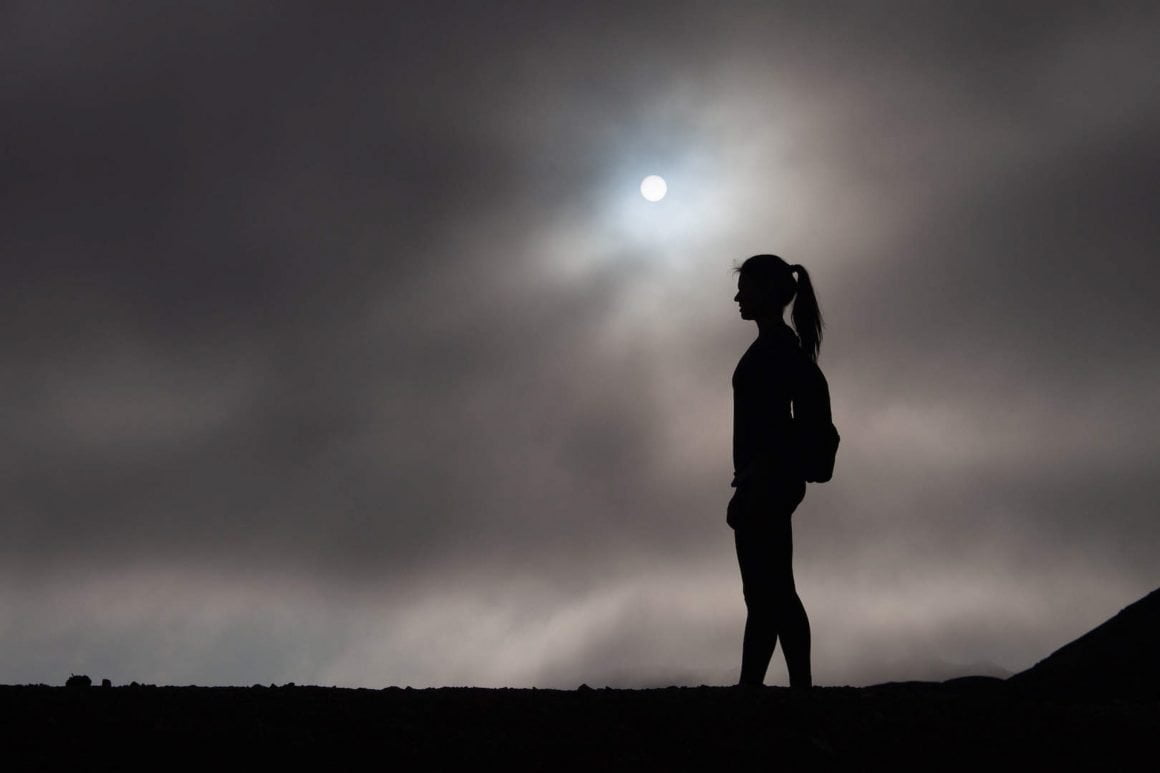
Moon Walking
For the first time in Namibia, we weren't rewarded with a sunset for waking up early. The fog from the coast beat the sun to Goanikontes.
On the bright side, it made for a uniquely eerie atmosphere during our easy, 1.5-hour, early-morning hike on the moon landscape's Weitzenberg Trail.

From Fears to Reality
The inevitable happened.
Our car, which so valiantly survived the dozens of hours of painfully corrugated roads it wasn't made for, had a flat tire. Two of them actually.
One was ok to drive on into town. The other, we replaced with our spare and the help of two well-intentioned but poor-planning Goanikontes employees. They broke our jack by using it upside down.
Luckily we had time to spare, René was around to lend us her jack, and at TyreRack in town they had true professionals who made our wheels good as new for just NA$100 each.
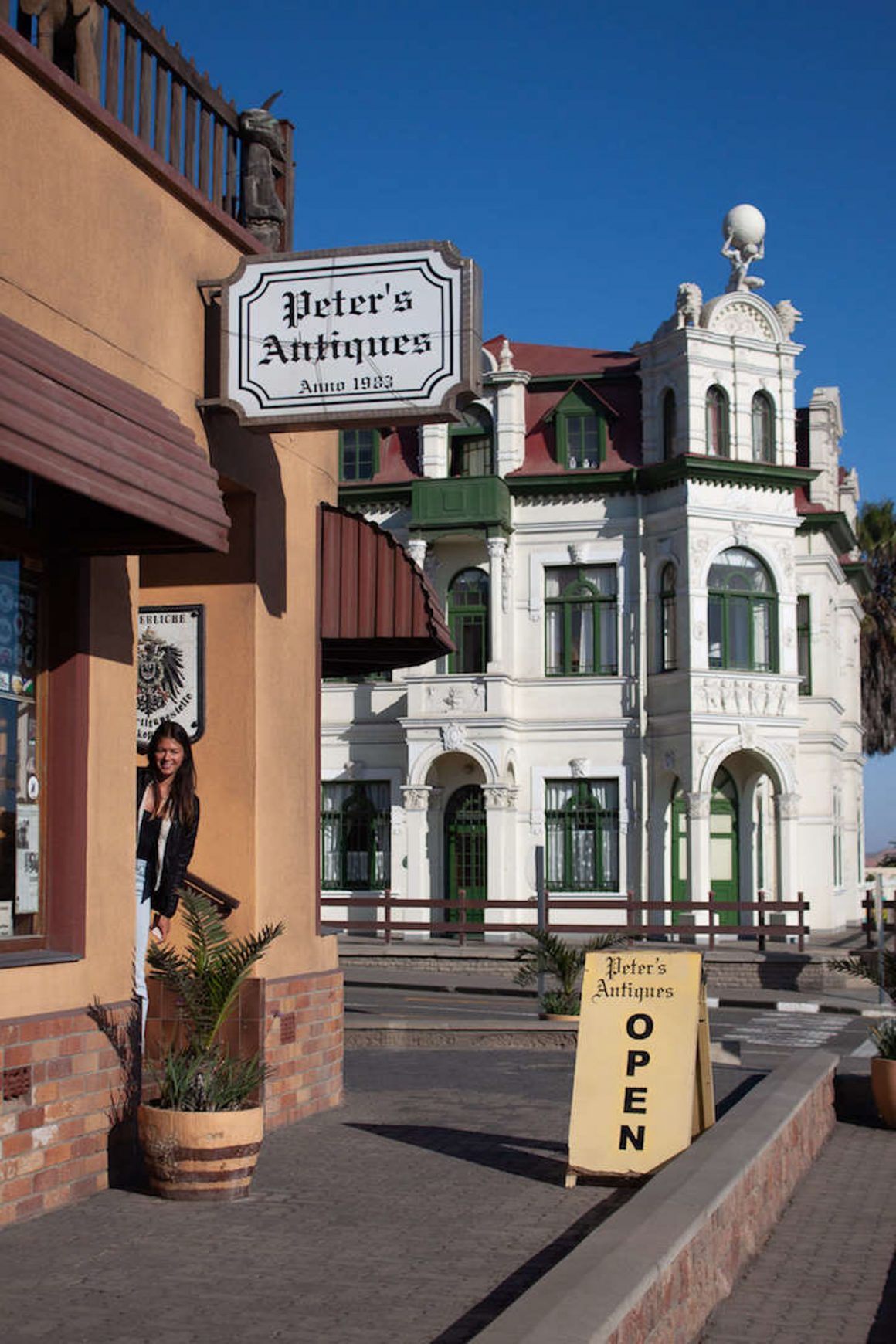
Enough of Swakop
Any concerns we had about the time we wasted fixing our tires dissolved when we got into central Swakopmund and found little to do.
Swakop may be nice compared to other Namibian towns. But not compared to anywhere else in the world.
We found very little to do . We wandered around, stopped in some souvenir shops in the pedestrian mall by the Brauhaus , the Kristall Galerie , and Peter's Antiques , but couldn't find the appeal of the place.
We enjoyed our meals at Tiger Reef and Tug , and their settings, though.
Equally enjoyable was getting a day off from driving, as spent a second night at Goanikontes.
- Highlights: Taking photos in the abandoned buildings towards the end of our moon walk.
- Lowlights: Seeing our car's flat tires for the first time.
- Best Food: Calamari from Tiger Reef and the solid-sized serving of stir-fried veggies it came with.
- Where We Stayed: Second night at Goanikontes
- Road Quality: Great!
- Day Rating: 6.
Quick Tip: Get a puncture repair kit like this one for your car. René gave us this tip when we were putting on our spare, we bought one in Swakopmund, and we soon put it to good use.
Namibia Blog Day 9: Spitzkoppe
323 kilometers in 5 hours

Amusement Park
As we approached Spitzkoppe , two hours from Goanikontes, its unnatural-looking big boulders and giant-pointy mound looked like an amusement park.
And, fitting of an amusement park, people outside tried selling us trinkets and souvenirs. Except it was kids (pushed forward by their parents) trying to sell to adults, not the other way around.
Inside, was a lot of fun. For us, more fun than an amusement park.
Scrambling up, down, around, and sometimes under the grippy rocks was the most fun activity of our whole Namibia road trip . And, contrary to many other reports we'd read, we didn't need a guide to scramble along the mountains. You only need guides to see the rock art.
Something's Erongo
We sped along the paved roads to Outjo where just outside of town was the most peculiar place: Erongo Mountain Winery , the biggest of the only four wineries in Namibia.
The vines were ragged and sparse and the surrounding farms were suffering from drought but somehow this sparkling new facility's cellars were full of wine.
We heard quite a few conspiracy theories about where it all came from.
The wine itself was unexceptional, but Boppie, who led our tasting did an excellent job and the other drinks we tasted like the Gravino, brandy, and cream liquor were nice to try.
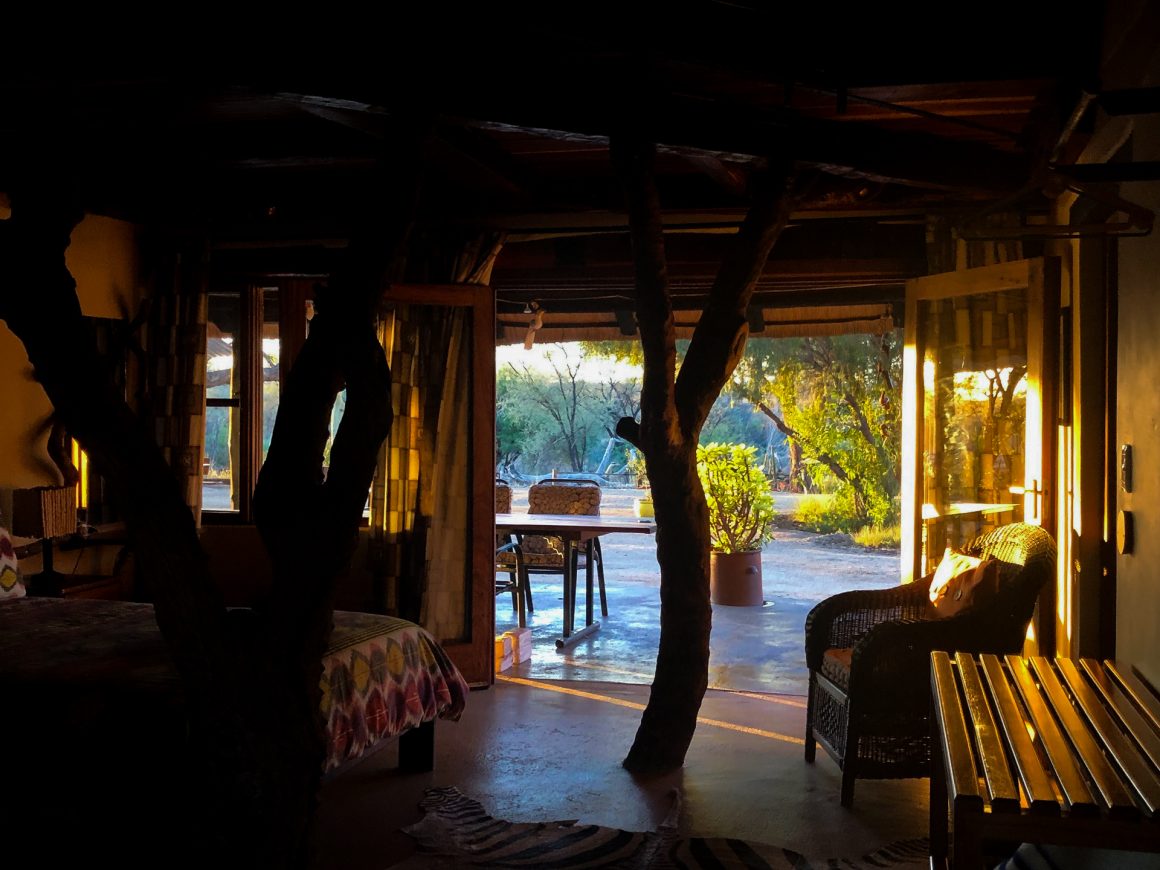
Camp Mara had easily the nicest room of our entire Namibia road trip .
The person who designed them obviously put a lot of thought into the details, like the little lights and switches built into the live edge bathroom mirrors. And the kitchen was better stocked than ours back home!
That designer turned out to be Ecki, Camp Mara's very-German but born-and-raised-in-Namibia owner. During our pleasant candle-lit dinner with him and the camp's two other German guests we tried to loosen him up, but could barely crack him. He was probably thinking of the next addition to his rooms.
- Highlights: Climbing around Spitzkoppe.
- Lowlights: The unanticipated 45-minute wait for our sandwiches at Namib Oasis when we were in a hurry to make our appointed tasting at Erongo.
- Best Food: It's too bad the wait ruined our experience and we had to scarf it down too fast to fully appreciate it, but Namib Oasis's food was good.
- Where We Stayed: Camp Mara
- Road Quality: All good and mostly paved, with the exception of the 30 kilometers from the B2 highway to Spitzkoppe and back, which was in rough condition.
- Day Rating: 7
Quick Tip: Take advantage of the showers at Spitzkoppe's camp if you come as a day visitor and get sweaty from bounding up and down its boulders.
Namibia Itinerary Day 10: Kamanjab
490 km in 6 hours
Boring's Better than Bad
With a large distance to cover we made a depressing decision : to take the long route on boring paved roads rather than risk a shorter, potentially more exciting route on bad dirt roads.
The other way would've taken us by Brandberg Mountain , but some fellow bloggers said it was the biggest disappointment of their own Namibia road trip itinerary and other attractions in the area like the Organ Pipes had especially bad reviews .
We tried to throw in a bit of spice by making a detour to Vingerklip and the Ugab Terraces , but for us it was one of those places where the photos look better than real life.

Kaman-Giraffes
After seven hours of driving, we made it to our destination, Kamanjab Rest Camp .
There, we were happy to have the chance to stretch our legs with a 3-kilometer loop around Kamanjab Rest Camp's reserve. The first two-and-a-half kilometers were nearly as uninspiring as our drive until…
Kim spotted the giraffes.
They were so still at first that Kim thought they were fake, but as we moved in for a closer look, they moved away.
We'd seen plenty of giraffes before in Kenya and at Kruger but the novelty of seeing them, especially when on foot instead of in a vehicle, made our day (even though that didn't take much doing.)
All's Well that End's Well
We booked at Kamanjab Rest Camp first because of its convenient location en route to Etosha game reserve but second because of the good reviews of its food.
The dinner delivered.
I had a three-course meal with zebra (my second zebra steak of the day!) and Kim had a two course with oryx. Both steaks were superbly seasoned and topped with a tasty pepper sauce, and accompanied by a nice salad and fresh fries.
After dinner, we chatted with Elodie and M.D. the younger-than-us Belgian-Namibian couple who'd taken over Kamanjab Rest Camp in August.
Elodie shared her experiences of settling into Nambia and M.D. outlined his own perfect Namibia road trip itinerary. It didn't overlap with ours at all. It centered around the rarely-visited far-northwest of the country and required serious off-roading expertise.
- Highlights: Spotting giraffes on our walk around Kamanjab Rest Camp.
- Lowlights: "Giving up" on adventure and staying on paved roads.
- Best Food: Belgian-cooked zebra and oryx food at Kamanjab Rest Camp.
- Where We Stayed: Kamanjab Rest Camp
- Road Quality: All paved roads except the detour to Vingerklip, which was in ok condition.
- Day Rating: 5. At least we weren't home on our computers.
Quick Tip: Go to the Farmhouse instead of Outjo Bakery in Outjo. The Farmhouse used to be the only spot in town, got too comfortable, then Outjo Bakery came along and stole all its business. Now, the tides have turned. Outjo Bakery seemed charm-less and uninspiring while Farmhouse's food was tasty, well-priced, and had excellent service. Oh and apparently "the best coffee in Namibia."
Namibia Blog Day 11: Etosha (The Good Day)
225 km in 7.5 hours
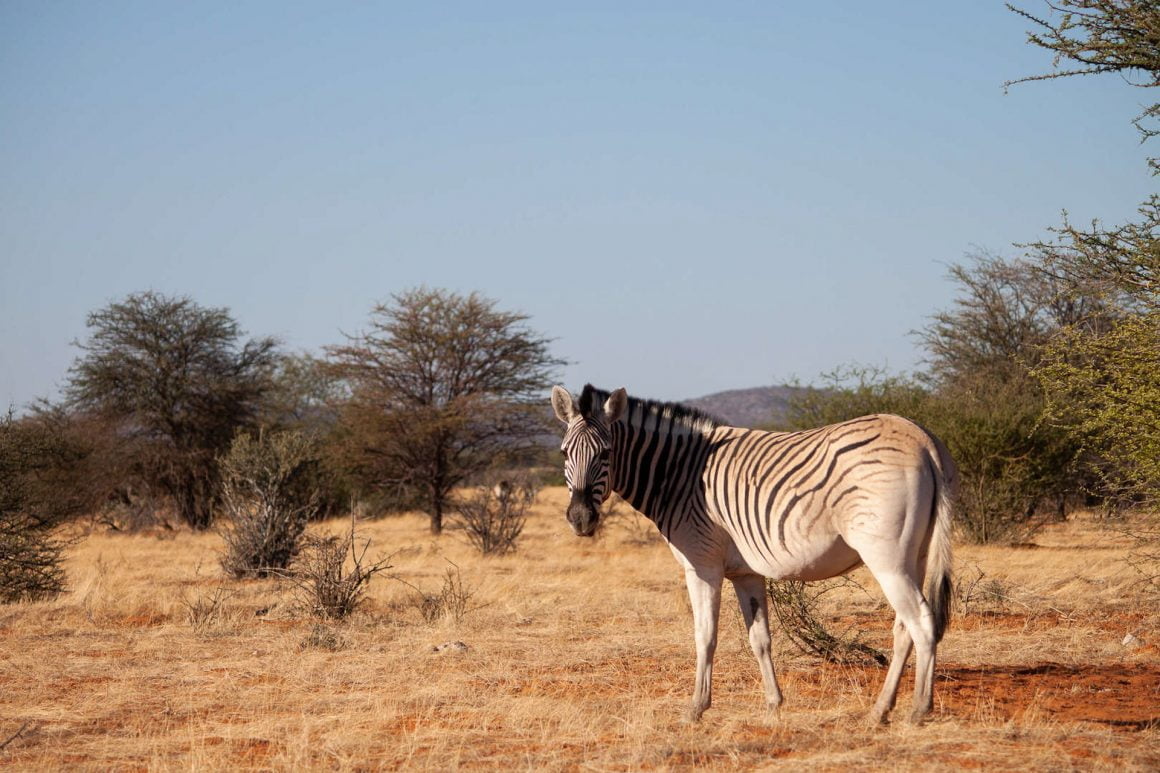
Forty-five minutes after we'd hastily packed up because I set my alarm for 6 p.m not 6 a.m., we made it to the Galton Gate entrance to Etosha National Park .
We didn't see many animals for the first hour-and-a-half in the remote western edge of the park…
…But over the following five hours we saw more wildlife than we'd seen at any park in Kenya or in South Africa's Kruger Park .
By 3 p.m., we'd seen every animal we had extra tentatively, because we were visiting off peak season, included on our wishlist!

Around 11 a.m., we stopped at the Olifantrus Camp where we lost track of time watching wildebeest, oryx, zebra, and red hartebeest jostle over drinking spots from the two-story animal hide.
Aside from the hide the camp was basic and had "sold out" of all its firewood and meat, so we regretted having reserved a night there. Luckily, the manager managed to change our reservation and get us the last campsite in Okaukeujo instead.
Unbelievably, the road from Olifantrus to Okaukeujo was worse than any we'd experienced on our Namibia road trip.
When we finally made it to Okaukeujo camp, we found and fixed two punctures in our back left tire. Thank goodness we purchased the tire repair kit in Swakopmund. Without it we would have had to abandon our next day in Etosha and drive 117km to Outjo to get it fixed.
Okaukeujo is more of a village than a camp with shops, various types of accommodation, a big tower in the middle, and, most importantly, an animal viewing area.
Sitting on benches semi-encircling a waterhole, we watched oryx and elephants drink at sunset and, after a braai with some new Spanish photographer friends where an opportunistic jackal circled for our scraps, returned at night to watch more elephants, giraffes, and black and white rhino under the floodlights.
What a show!

- Highlights: Watching three female lions saunter into Jackalswater waterhole as all the other animals there lost their shit and fled.
- Lowlights: The long, featureless, animal-less, and miserable road from Olifantrus to Okaukeujo, especially from Ozonjuiti on.
- Best Food: We grilled our own food rather than pay a premium for whatever uninspired food was available at the camp restaurants.
- Where We Stayed: Okaukeujo (o-ka-koy-yo). Dirty, crowded, and overpriced, but worth it for the animal viewing at sunset, sunrise, and at night.
- Road Quality: Until Olifantrus, the roads were OK, but the roads from there to Okaukeujo almost gave us and our car a K.O.
- Day Rating: 7.5. Four hours of bad driving was worth it for animals.
Quick Tip: Book at a camp inside Etosha well in advance to ensure you get a spot. Watching animals from the hides at sunset, sunrise, and at night is an incredible experience you cannot have if you stay at better, cheaper camps outside the park.
Namibia Itinerary Day 12: Etosha (The Bad Day)
271 km, 8.5 hours

Fewer Animals, Too Many Bad Roads
We saw plenty of animals—elephants, a honey badger, lions, and all the other common game—but made even more mistakes on our second day in Etosha.
- Starting our day driving to Pan's Edge, a "viewpoint" at the edge of Etosha's salt pan that, from our point of view, was a complete waste of time.
- Forgetting to download and bring the guide to Etosha waterholes our friends had sent us the link to. We should have gone through it and carefully planned our route.
- Electing to drive a loop to Halali Camp and back. The bad roads were too much for us. We would've enjoyed our time more had we picked a couple waterholes near Okaukeujo and stayed there.
Quick Tip: Get The Photographer's Guide to Etosha National Park . Our friends told us it was super handy for learning about Etosha's watering holes, animal patterns, and some added photography tips.
Halali Camp
In the mid-day heat, we took a break at Etosha's Halali Camp .
The camp itself isn't much more than a big dusty parking lot of campsites, basic cabins, and a restaurant but we relished the opportunity to cool off in the swimming pool then watch a big group of elephants do the same at the waterhole while bullying away the oryx and zebra who wanted to join.
- Highlights: The elephants at Halali Camp's waterhole.
- Lowlights: Realizing our mistake of not planning our day better before we set out.
- Best Food: Vegetarian braai at our campsite to finish off everything we'd bought.
- Where We Stayed: Taleni Etosha Village , just outside Etosha's Anderson's Gate on the road to Outjo. So much nicer in every way than the campsites in Etosha… except for the all-important waterholes.
- Road Quality: Rock bottom.
- Day Rating: 5
Quick Tip: Don't get over-eager like we did. We would have enjoyed Etosha much more had we spent less time driving and more time sitting at waterholes watching animals.
Namibia Blog Day 13: Windhoek
443 km in 5 hours
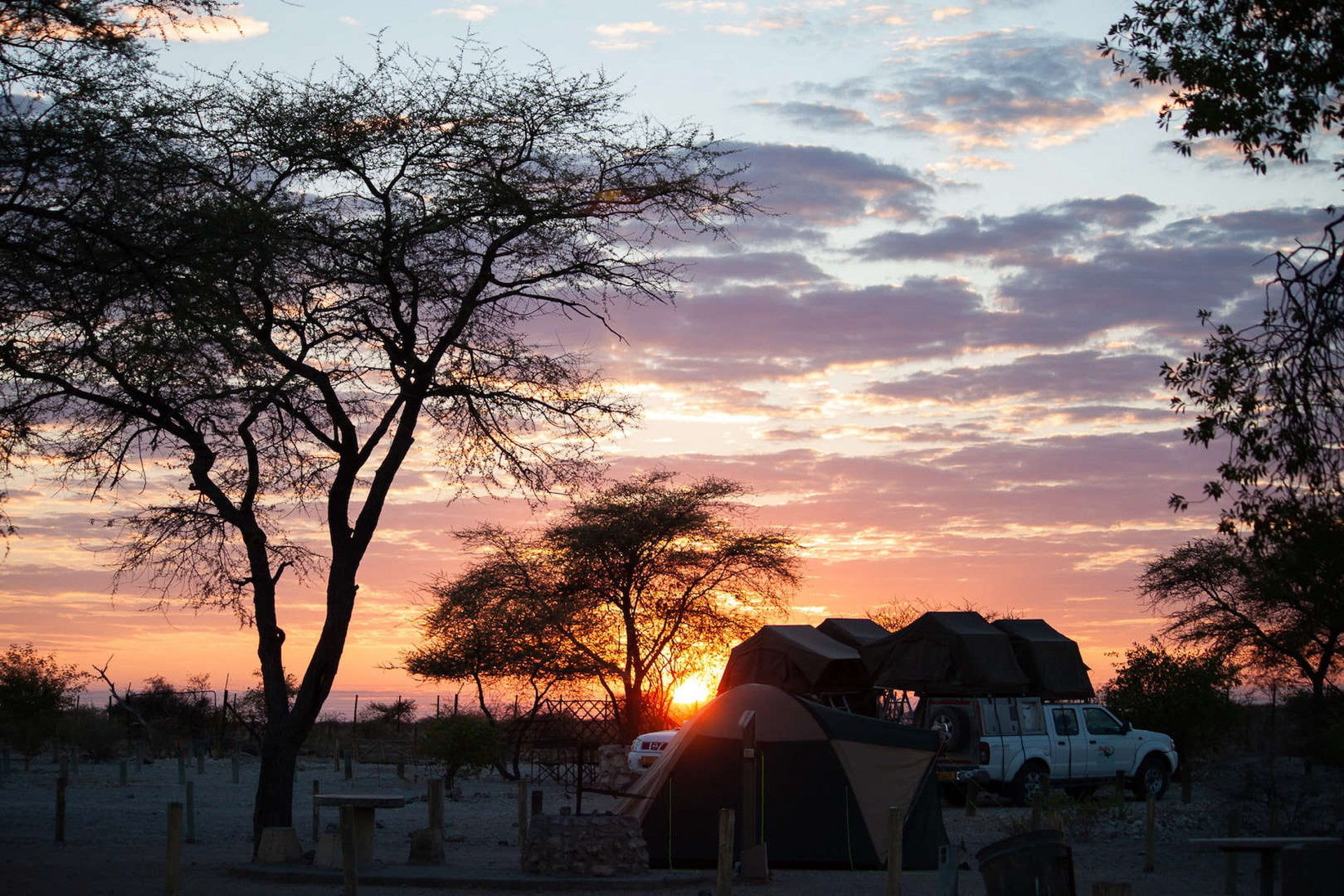
Driving from Etosha to Windhoek
We looked hard for things to do in the 400 kilometers between Etosha and Windhoek, but found little.
Waterberg Plateau Park is the biggest attraction, but we'd heard mixed reviews and that you can't go on unguided hikes there, so we skipped it.
Discouraged, we sped straight to Windhoek. The roads are great and straight so it took us only 4.5 hours including stops for gas in Outjo, for food at Bohemia Books & Coffee , and for some biltong and dried fruit in Okahandja.
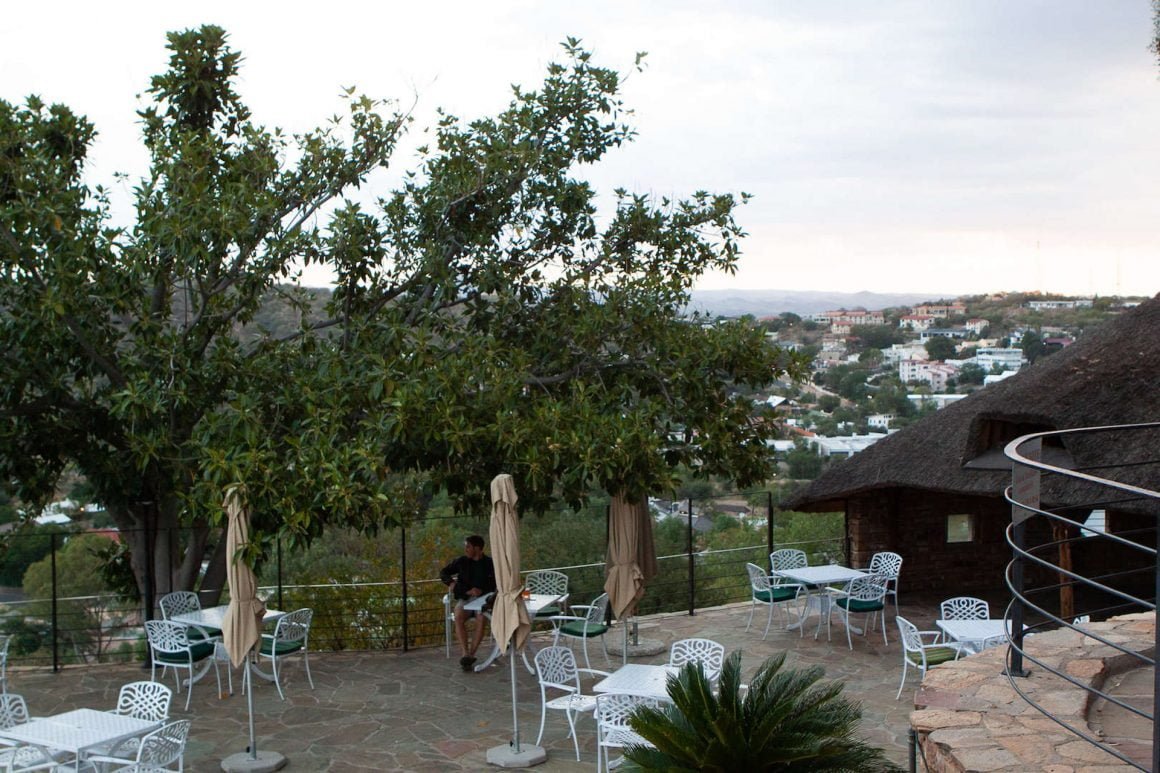
We had low expectations for Windhoek , Namibia's capital and most populous (around 350,000 people) city.
And Windhoek failed to live up to them.
We found it to be a character-less sprawl of traffic, strip malls, walled homes, and a ratty downtown center.
For one evening, though, it was fine.
We were treated to a sunset thunderstorm (!) at Hotel Thule and found Joe's Beehouse lived up to its legendary reputation thanks to its wild knick-nack decor and decent food.
- Highlights: Watching and experiencing a rare Namibian thunderstorm while enjoying a fantastic sunset and cheap beers at Hotel Thule.
- Lowlights: The lack of attractions between Etosha and Windhoek.
- Best Food: My oryx schnitzel from Joe's Beerhouse in Windhoek.
- Where We Stayed: An Airbnb that wasn't as well-located as advertised.
- Road Quality: Perfect and paved the whole way.
Quick Tip: Feel free to skip Windhoek entirely. You're visiting Namibia for the wilderness anyway.
Namibia Itinerary Day 14: Departure
48 kilometers in 1 hour
Windhoek Craft Centre and Cafe
Unlike similar shopping centers in other cities, Windhoek's Craft Centre didn't sell junky, made-in-China stuff. Each of the 38-or-so stalls sold what looked to be high-quality, original products.
So even though we had no space in our bags, Kim felt compelled to buy a couple things.
Our Airbnb host highly recommended the café there too. The upstairs patio seating was a plus, but everything was 20-40% more expensive than it should be.
Airport Shenanigans
Annoyingly, Windhoek's Hosea Kutako International Airport is 45 kilometers outside of town.
Much more annoyingly, nobody told us that rental car companies don't accept patched tires. Even though we'd gotten our tire professionally patched and it survived a further 2,000 km on Namibia's horrible roads, the agent told us they'd have to replace it. We were charged accordingly: NA$1,100 for the tire and NA$500 for "administration."
One last bump in the road for our very bumpy but undeniably scenic Namibia road trip.
- Highlights: The Craft Center actually had some nice stuff.
- Lowlights: Dealing with rental car issues.
- Best Food: The 25 foods we ate during our 24-hour layover in Taiwan on the way back to Canada.
- Where We Stayed: Seat 52F and 52E of the airplane.
- Road Quality: 100% paved.
- Day Rating: 3. Who likes airports and traveling?
Quick Tip: If you're returning your rental car at the airport, fill up your tank in Windhoek. We didn't get penalized for using up the 45 km worth of gas to get from there to the airport.
Read This Next:

Namibia Travel Tips: 20 Things to Now Before Your Self-Guided Trip

Before Planning a Cape Town to Namibia Road Trip, Read This

Is Namibia Worth Visiting? Yes, But Prepare Yourself
Disclosure: Whenever possible, we use links that earn us a cut if you pay for stuff we recommend. It costs you nothing, so we'd be crazy not to. Read our affiliate policy .
2 thoughts on “Namibia Itinerary and Travel Blog: 14-Days, 4,274km, 1 Big Problem”
Too critical You should research your destination before arriving. Namibia’s tarmac roads are among the best in Southern Africa. There are many thousands of kilometers of gravel roads and it is very expensive keeping them in perfect condition. Don’t you appreciate that you contributed virtually nothing to Namibia and the majority of the population while there and expect services to be equal to what people living in cities Europe and USA have. You hired a car that was cheap and unsuitable for your route when research before arriving would have.made it obvious that a 4×4 (and knowledge of how to adjust tyre pressures depending on road conditions) was a much better choice. You are financially very fortunate to live in the cosseted West and have spare money for leisure trips around Africa. Namibia (and the rest of Africa can be an amazing experience but if you are not super rich you should not arrive with a critical mind. Accept it as it is even if it might take you out of your comfort zone. Don’t you appreciate that your lifestyle is partly at the expense of exploited countries around the world. Corruption mainly benefits major foreign companies who approach incompetent and corrupt politicians (traitors) who are prepared to sell their countries future prosperity for a relatively minute amount. I lived in Namibia for five years and know some of the difficulties there. My opinion is that if you can appreciate being away from suburban life, temporary solitude, and amazing nature and wilderness you will probably want to return again and again. If you are a committed suburbanite you are probably better to stay away.
I think my perspective is worth sharing and closer to my real experience than the fawning stuff others write. Readers can balance my perspective with others for their planning.
What do you think? (Leave a Comment.) Cancel reply
We’re on the road right now – join in on the fun and follow @thebrokebackpacker on IG!
- Meet the Team
- Work with Us
- Czech Republic
- Netherlands
- Switzerland
- Scandinavia
- Philippines
- South Korea
- New Zealand
- South Africa
- Budget Travel
- Work & Travel
- The Broke Backpacker Manifesto
- Travel Resources
- How to Travel on $10/day
Home » Africa » Travel Safety
Is Namibia Safe for Travel? (Insider Tips)
Namibia, with its incredible landscapes that seem to go on forever and amazing opportunities to see some of the most quintessentially African wildlife you could ever imagine clapping eyes on, is a dream for any nature lover. This is safari country, people.
Although Namibia is often touted as one of the safest countries in the whole of the African continent, it still certainly has a few issues of its own that you should take note of.
Petty theft and street crime, as well as more violent crime, has actually increased in recent years, especially in the capital and transport hub of Windhoek. Self-driving can mean the risk of finding yourself stranded half a day’s drive from anywhere and nature can be very dangerous.
To help ensure that your trip goes as smoothly as it can possibly go, we have created this epic safety guide to Namibia. Filled with tips on how to travel around the country, how to call a cab, whether you should rent a car, and much more, we’ve got you completely covered.

Unlock Our GREATEST Travel Secrets!
Sign up for our newsletter and get the best travel tips delivered right to your inbox.
How Safe is Namibia? (Our take)
Is namibia safe to visit (the facts.), is it safe to visit namibia right now, namibia travel insurance, 23 top safety tips for traveling to namibia, keeping your money safe in namibia, is namibia safe to travel alone, is namibia safe for solo female travellers, is namibia safe to travel for families, is it safe to drive in namibia, is uber safe in namibia, are taxis safe in namibia, is public transportation in namibia safe, is the food in namibia safe , can you drink the water in namibia, is namibia safe to live, how is healthcare in namibia, faq about staying safe in namibia, final thoughts on the safety of namibia.
Namibia’s huge landscapes are a natural habitat to the “Big Five” safari animals, which is naturally one of the major draws to this Southwest African nation.
Another draw to the Republic of Namibia is just how safe it is. Said to be one of the safest countries in Africa, its capital Windhoek is more provincial and small scale than sprawling and urban.
That said, the crime level of Namibia is still a concern.
In Windhoek, for example, there is actually a growing a level of street crime, including violent crime, some of which does affect foreign tourists.
Nature, too – which here is vast, epic and unforgiving – can prove to be quite a risk to your safety. You can, for example, often drive for hours and hours without seeing a single soul, giving you an idea into just how remote things can be here.
There are well-travelled routes in Namibia that do make exploring the country relatively safe, but obviously, if you want to do something more adventurous, there is an element of risk involved. That’s why it’s called adventurous.
To see just how “adventurous” it can get here, let’s dive into the details…
There is no such thing as a perfect safety guide, and this article is no different. The question of “Is Namibia Safe?” will ALWAYS have a different answer depending on the parties involved. But this article is written for savvy travellers from the perspective of savvy travellers.
The information present in this safety guide was accurate at the time of writing, however, the world is a changeable place, now more than ever. Between the pandemic, ever-worsening cultural division, and a click-hungry media, it can be hard to maintain what is truth and what is sensationalism.
Here, you will find safety knowledge and advice for travelling Namibia. It won’t be down to the wire cutting edge info on the most current events, but it is layered in the expertise of veteran travellers. If you use our guide, do your own research, and practise common sense, you will have a safe trip to Namibia.
If you see any outdated information in this guide, we would really appreciate it if you could reach out in the comments below. We strive to provide the most relevant travel information on the web and always appreciate input from our readers (nicely, please!). Otherwise, thanks for your ear and stay safe!
It’s a wild world out there. But it’s pretty damn special too. 🙂
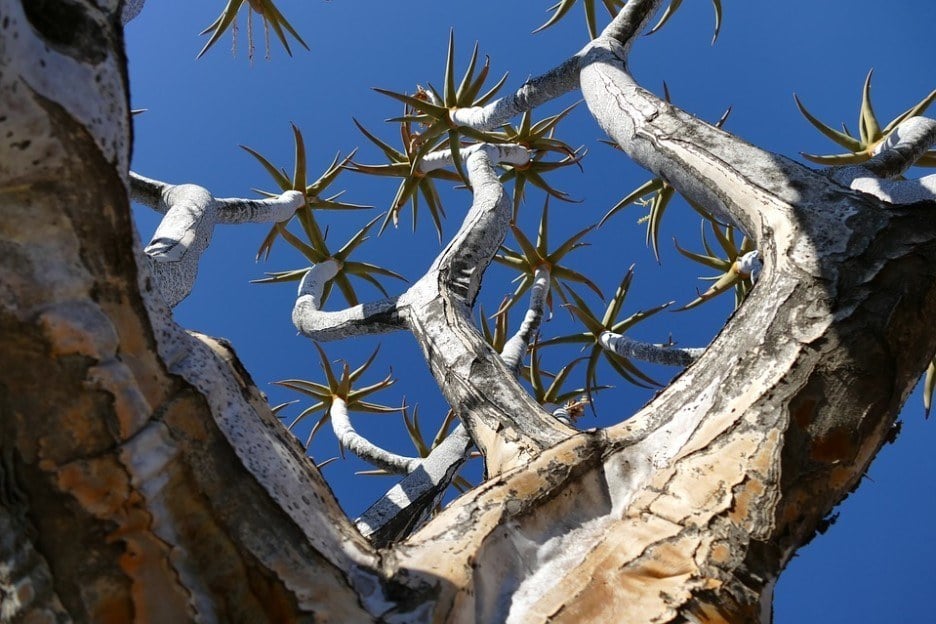
The history of Namibia is somewhat complicated. Prior to colonial rule, it was its own thing, then the Germans arrived in 1884, then the British after World War I and then South Africa, which administered the country till it gained independence in 1990.
It is, therefore, quite a new nation. Unlike many new nations, however, there has been little political violence in Namibia, thanks to its democratic government. Even street demonstrations are rare.
Namibia is so huge and so underpopulated that it has the second-lowest population density of any sovereign nation in the world (after Mongolia). With 2.2 million inhabitants, it was reported in 2017 that there were on average 3.08 people per square kilometre. Now that’s sparse.
In terms of crime, according to the UK Government, the capital has seen an increase in crime in recent years. More than two-fifths of crimes reported occur in Windhoek, in fact, most of which are burglaries, assaults and robberies.
The US State Department reported in 2015 that the most common crime taking place was “petty street crime,” with criminals using knives, sometimes firearms, and most incidents taking place after dark.
Organised crime is also an issue, which has only had a place in the country since the 1980s, something which affects much of southern Africa. Drug trafficking and laundering money are the main issues although this does not affect tourists.
In fact, Namibia’s tourism industry is booming as there are so many incredible places to stay in Namibia .
In December 2010, the country was touted as the 5th best tourist destination in the world, in terms of value for money. It’s valuable to the country too, being worth an estimated 7.2 billion Namibian dollars (around USD $485,500,000).
Since the first estimate took place for tourist numbers took place in 1989 (100,000), it increased tenfold by 2014, with 1,176,000 tourists to the country.
We’ll end with this fact: The Global Peace Index of 2019 ranks Namibia joint-60th in the world (out 163 countries measured), alongside France!
Namibia, as we mentioned, lacks any current political crisis or social upheaval. However, the only thing that might be affecting how safe Namibia is right now is the spike in crime, particularly in the capital.
Thefts, muggings and robberies have been occurring frequently in crowded areas – and especially places where travellers are found. People are usually unharmed if they surrender their belongings, but often criminals brandish knives as a threat.
There has been a Tourist Protection Unit (or TPU) set up by the Namibian police to help deal with these crimes, but it has been reported that this unit is understaffed and not as effective as it could be. It began in the Khomas and Erongo regions as a pilot project. In Windoek there is a TPU at the corner of Independence Avenue and Bahnhof Street.
Most of the crimes that take place in Namibia are actually non-violent and are based around theft. Things like pickpocketing, theft from vehicles, and the like.
You don’t need to worry too much about political instability. Union led demonstrations do take place, but discipline is enforced and there is very little confrontation with the authorities; nevertheless, it’s never a good idea to be involved in the demonstrations of another country.
Aside from human threats, nature can be very scary in Namibia. There’s vast distances between locations and vehicle breakdowns could very quickly turn into life-or-death situations.
During the summer in this dry, semi-desert country, you can expect high temperatures a lot of the time. Then, flooding during the rainy season (December to March) can see roads washed away or become impassable.
Also, let’s not forget that this is safari country, home to big, dangerous animals. Doing what your guide tells you, taking the right precautions when staying at a lodge, and making sure to watch your step in the wilderness is a good place to start to keep yourself safe in Namibia’s nature.
Cholera is known to occur in Namibia ; currently, there is an outbreak in the Kunene region as well as a small outbreak in the capital. The UN AIDs Report in 2013 stated that there were 200,000 adults aged over 15 who are living with HIV (13.3 percent of the adult population, compared to 2.2 percent of adults in the UK).
None of this, however, is designed to scare you – it’s good to be aware of issues affecting Namibia before you venture there for yourself.
ALWAYS sort out your backpacker insurance before your trip. There’s plenty to choose from in that department, but a good place to start is Safety Wing .
They offer month-to-month payments, no lock-in contracts, and require absolutely no itineraries: that’s the exact kind of insurance long-term travellers and digital nomads need.

SafetyWing is cheap, easy, and admin-free: just sign up lickety-split so you can get back to it!
Click the button below to learn more about SafetyWing’s setup or read our insider review for the full tasty scoop.
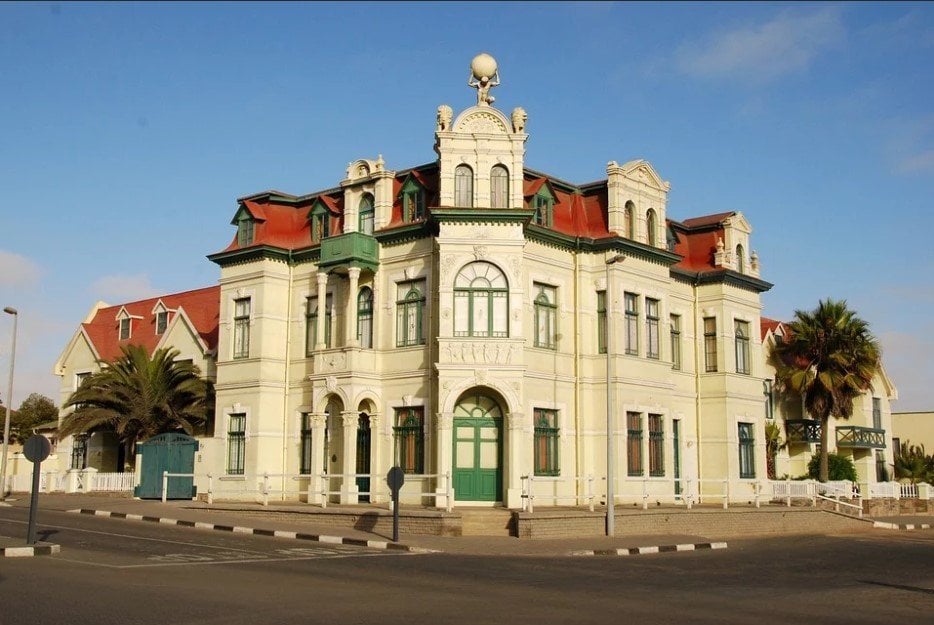
Though Namibia might be sometimes seen as “Africa Light” or an easy way to explore nature of the sub-Saharan part of the continent, there are definitely still dangers you should beware of and issues you should know about. It’s important to be aware of things going on around you as well as potential dangers, to protect yourself – to help you do that, here are some travel tips for Namibia to keep in mind…
- Stay alert – muggers target foreign tourists, even in daylight in busy areas
- Avoid walking around at night – the crime levels increase after dark, so it’s not wise to be strolling around at this time
- Keep car doors locked, windows shut – smash and grab type crimes from cars can happen in traffic or at lights
- Don’t leave anything on display in your car – having anything that looks like it might be worth something in your car that’s visible is an invitation for thieves
- Only use reputable taxis – and don’t hail them on the street, especially in Windhoek; ask your accommodation for a reputable number (we have a whole section of taxis later)
- Keep hold of your credit/debit card – card skimming happens, even in hotels, so don’t let it out of your sight
- Avoid looking wealthy at all – having wads of cash in your wallet, having an SLR on show, even a smartphone, or wearing designer clothing or expensive looking jewellery… this all screams “I’m a rich tourist” to a potential thief
- Try to hide your money – when paying for things, or exchanging it at all, it just advertises you as a walking ATM
- Keep your passport and important documents safe – have copies in a separate bag or place, just in case
- Be aware of scams – politely decline the services of over-friendly strangers accosting you in the street; it will just cost you a lot of money
- LGBTQ+ relationships are not illegal, but they are taboo – it’s important to be culturally aware of this; any show of same sex affection could cause some upset with local communities
- Keep well away from the Forbidden Zone – or Sperrgebiet. It’s en route to Luderitz and is a prohibited diamond mining area with armed patrols and, yeah, keep well away
- Just say no – don’t buy drugs, don’t carry over borders, don’t carry it around, just keep away full stop: the penalties are severe and the prisons are hellish, from what we can gather
- Theft can be an issue from campsites near urban areas – don’t leave anything in your tent that you are fond of or need
- Protect against mosquitoes – malaria is rife in the far northwest of the country; cover your arms and legs, especially around water sources at dawn and dusk
- Be careful around any stagnant or slow moving water – these can harbour all sorts of nasty diseases and illnesses
- Watch where you tread when camping or trekking – snakes and scorpions can deliver painful, if not lethal, bites and stings; check your boots, shake your clothes, don’t walk around barefoot!
- Keep away from the Euphorbia plant – it can be deadly; check out pictures online. If you are camping by yourselves, don’t forage your own firewood, buy it instead to avoid any nasty surprises
- Be careful taking pictures of state properties – and military buildings, it’s not illegal but people have been detained for doing so
- Don’t buy or trade any animal parts or products – don’t risk arrest and don’t support the hideous trade.
Whilst many would have you believe that Namibia is an oasis on the African continent, the relative safety of a country in Africa compared to other countries in Africa doesn’t say that much. On the other hand, just because there are things to watch out for, that doesn’t mean that it isn’t safe to travel to. In Namibia, it’s just important to keep your wits about you and make sure you’re aware of your surroundings.
Having your money go missing, whether you end up losing it yourself or if it gets stolen from you, is never going to be a good experience – anywhere in the world.
In Namibia, with a rising level of crime in urban areas, there may be a chance that you get targeted by a potential thief – and if you happen to let your guard down, you may end up more than a few dollars short.
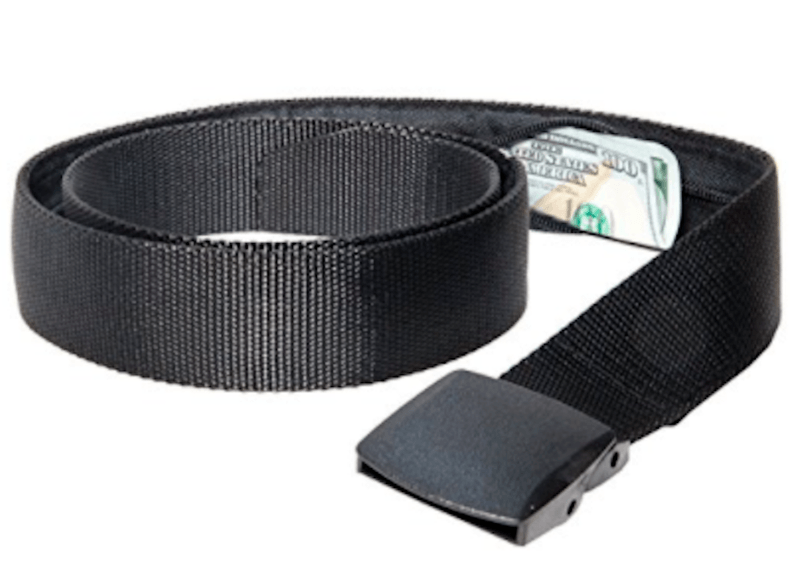
To ensure that your money stays safe in Namibia, the best thing to do would be to use a money belt . Trust us, the best (and only) way to ensure that you have a stash of cash that’s always safe is to use a money belt.
The thing is, not all money belts are great.
In fact, some money belts aren’t good at all. They can be awkward to get to, uncomfortable to wear, look obvious bulging underneath clothes and generally be overcomplicated.
The Pacsafe Money Belt is our best bet. It’s affordable, it looks and acts like a belt, and it’s sturdy – what more could you ask for out of a money belt!
This amazing piece of kit is quite literally just a belt – a normal belt with a buckle (sturdy, at that) – but it has a secret zipper pocket hidden in it. No one, especially not a potential thief, will suspect a thing.
Keep a stash of cash here and, even if you end up leaving your wallet somewhere, you have a little bit of money to fall back on whilst you sort out card cancellations and replacements.
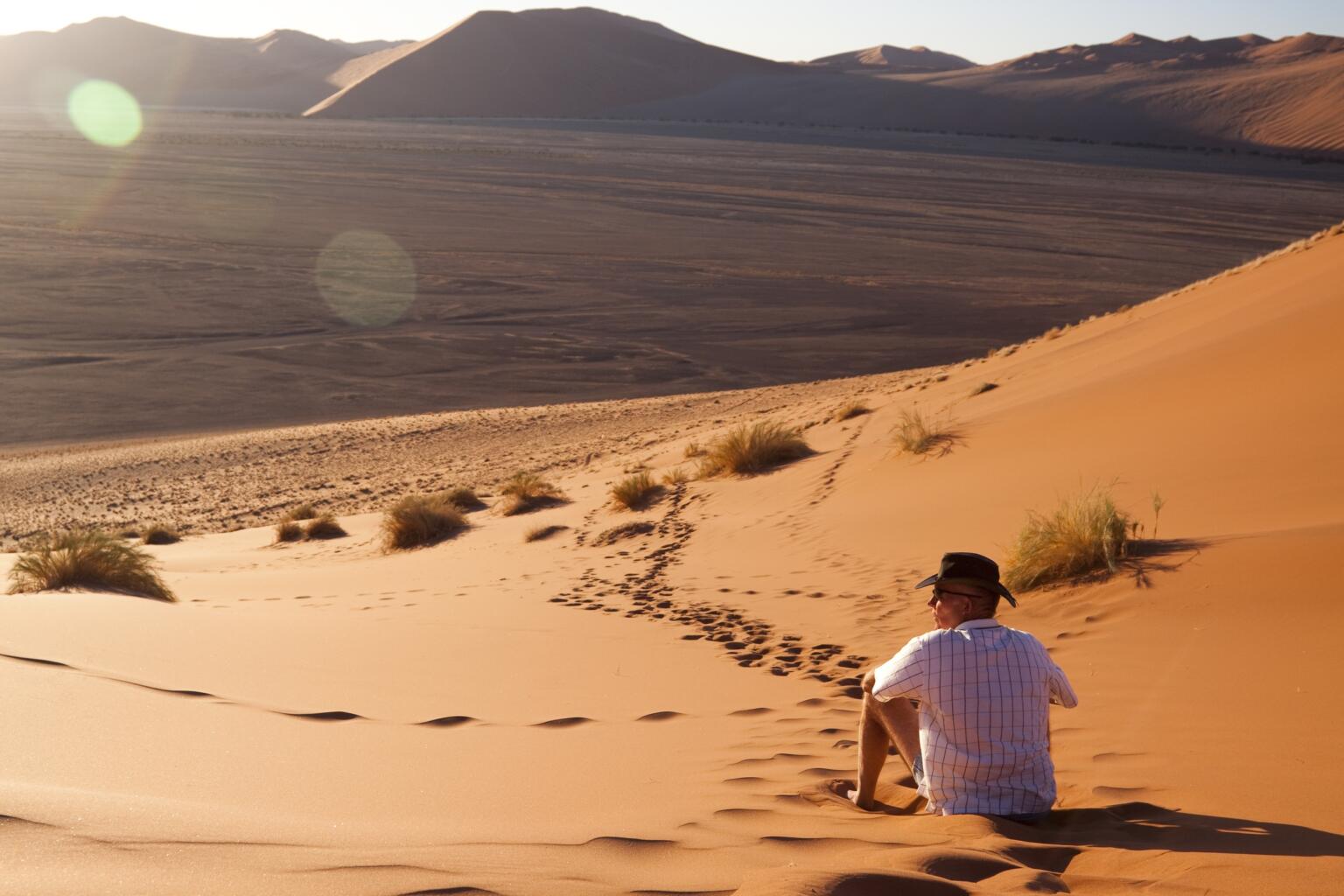
Namibia, despite everything that you have to watch out for, is a fairly safe place for solo travellers to explore. The local people are pretty friendly, there is a range of accommodation that you can choose to stay in, and there are also some amazing tours that you can join.
For solo travellers who are looking to get away from their daily lives and enjoy themselves, there is no better place. You get to choose what you want to do, tick some things off your bucket list, and push yourself. And here’s a few pointers from us on how you can do that safely…
- Choose your accommodation wisely. For solo travellers, you can opt for guesthouses, hotels, bed and breakfasts and also Airbnbs. The best thing to do is to find somewhere that’s run by a local; they’ll have some good advice to give you about travelling around their country, plus you’ll have someone to chat to.
- When it comes to accommodation, however, you will have to make sure that you do your research. Read reviews online of just how much other solo travellers liked it and choose somewhere that sounds like your kind of place.
- If you are choosing to self drive yourself around the country. With the huge distances between places, you should be prepared – even more so as a solo traveller. It’s possible to drive for hours without seeing a town or even a gas station, so stock up on all the supplies you need.
- Tell someone at your lodge or accommodation if you’re going out for a hike, or even if you’re just going out to see the sights of Windhoek; it’s a good idea to keep someone in your immediate vicinity in the loop about what you’re doing, just in case of an emergency.
- You should also keep in touch with friends and family back home. Share a Google Doc of your itinerary – when and where you plan to be certain places and what you intend on doing once you’re there. Going off grid is never a good idea; plus if you keep in touch via phone, you get to keep grounded with conversations and make the solo travel blues go away a bit by hearing a familiar voice.
- Ask a local that you’ve befriended, at a bar, or at your accommodation about where is safe to travel to, where isn’t so safe, and what you should be doing when you’re in their country. If there’s anybody who’s going to be, it’s them.
- Make sure you have multiple ways to access your money. Savings are all well and good, but if you can’t get to them… that’s not so good. Consider opening another easily accessible bank account, and getting an emergency credit card, too, for those just-in-case situations. Having a stash of emergency cash, US dollars, for example, is also a good idea.
- Don’t get crazy drunk! We’re all for the idea of having a few drinks, but being totally wasted is not a good idea, it will just mean that your judgement is impaired, you won’t be able to find your way back to your accommodation, and you’ll end up generally putting yourself at risk.
- Keep your phone charged. If you’re on the road for hours on end, or even just exploring the city, the last thing you want is to leave yourself without a way of contacting the outside world. Make sure to charge your phone fully as much as possible; you may want to invest in a battery pack, too.
A really big part of staying safe when you’re backpacking Namibia is just to keep your wits about you – no matter what you’re doing. You may have heard Namibia is safe, but not everything is going to be the same as your home country; it will be very different here.
Being cautious of people and situations, travelling lightly with as little luggage as possible, keeping in contact with people back home and generally not treating Namibia like a theme park will help you. It’s all about travelling around sensibly and making sure you’re prepared.
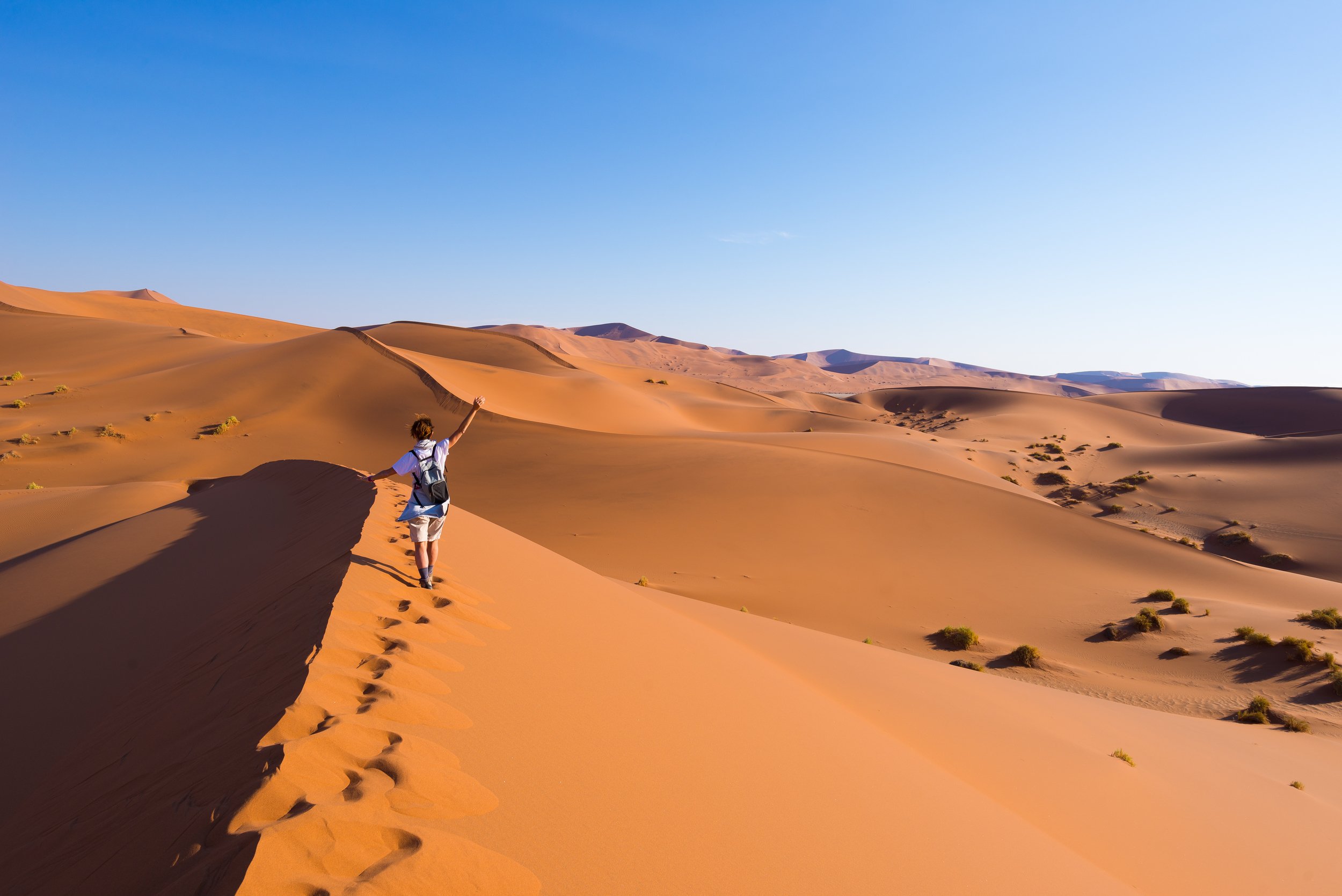
Namibia is a pretty tourist friendly country and, as a result, this means that there isn’t actually that much to worry about if you are thinking of exploring this place by yourself as a female traveller. In fact, on the whole, Namibia is quite safe for a solo female traveller.
However, it’s a conservative society and there are social norms to take into consideration. However, there is not much in terms of harassment on the streets, making it a surprisingly stress free place to travel solo as a woman. You could go on a tour or you could choose to discover the country by yourself with your own wheels. Either way, here are some tips on how to do so whilst maximising your security.
- Avoid walking alone, especially in back street areas, at night. This is just not a good idea. Even if you were somewhere in Europe, you probably wouldn’t be doing this – so definitely don’t do this in a dimly lit, deserted area of Windhoek just because it’s a shortcut to get back to your accommodation, for example.
- Take care if you want to go out drinking. Some bars in Namibia are male only and some others just won’t feel comfortable to be in if you’re a woman by yourself.
- Be aware that accepting a drink from a man at a bar (at a hotel or otherwise) is often perceived as an open invitation or a come-on. It’s probably best to politely decline if you don’t want this kind of attention.
- If you’re not happy with a situation, or someone is making you feel uncomfortable, remove yourself from it/them. Even if you just feel a little awkward with how a situation seems to be progressing, don’t feel like you need to stick around to see how it pans out just to be polite. Just make an excuse and get out of there.
- A good rule of thumb is to try and dress how the locals are dressed. In Windhoek, for example, it may be ok to wear shorts, but in more rural areas it’s best to dress more modestly. Err on the side of caution and opt for outfits that don’t reveal too much skin.
- If you want to meet up with other travellers, there are certain places where doing that is going to be easier than others. For example, in the north, the popular Etosha National Park , and in the centre, Sossusvlei and Swakopmund, are good spots for meeting other travellers and getting involved with activities; the Zambezi region, on the other hand, is popular with backpackers.
- Get connected with other travellers and local communities before you even head to Namibia. Facebook groups like Girls Love Travel are places where you can ask for advice, or see if any other female travellers are in the country at the same time as you; Host A Sister is another good resource, where you may get the opportunity to hang out with and befriend an actual Namibian local.
- Do thorough research of your accommodation. It’s all well and good going by a star rating alone, but you should read some reviews, taking particular note of those made by other solo female travellers – this will be a good benchmark of how much you will like the place too.
- Don’t feel that hiring a guide, or joining a tour group, is an easy way out. It’s actually a cool way to travel Namibia, with more regions covered than you could manage, more know how, more experience, and being able to stay in pretty nice accommodation, too. At the same time, it’s a good way to meet some fellow travellers.
Being a relatively safe country, at least for the standards of the African continent, women travelling solo in Namibia will find themselves having an awesome time in general. There’s so much incredible nature and wildlife to get wrapped up in that it’ll be a memorable trip.
Just like many other destinations throughout the world, however, there will always be places in Namibia where you should be careful. With just a few extra safety precautions you are bound to have a mindblowing time in Namibia, whether you go it alone or join a tour.
As a solo female traveller, a trip to Namibia is probably best if you already have a few trips by yourself under your belt – especially if you want to tackle long distance driving by yourself though. First timers can always join a tour, letting someone else deal with the stress!
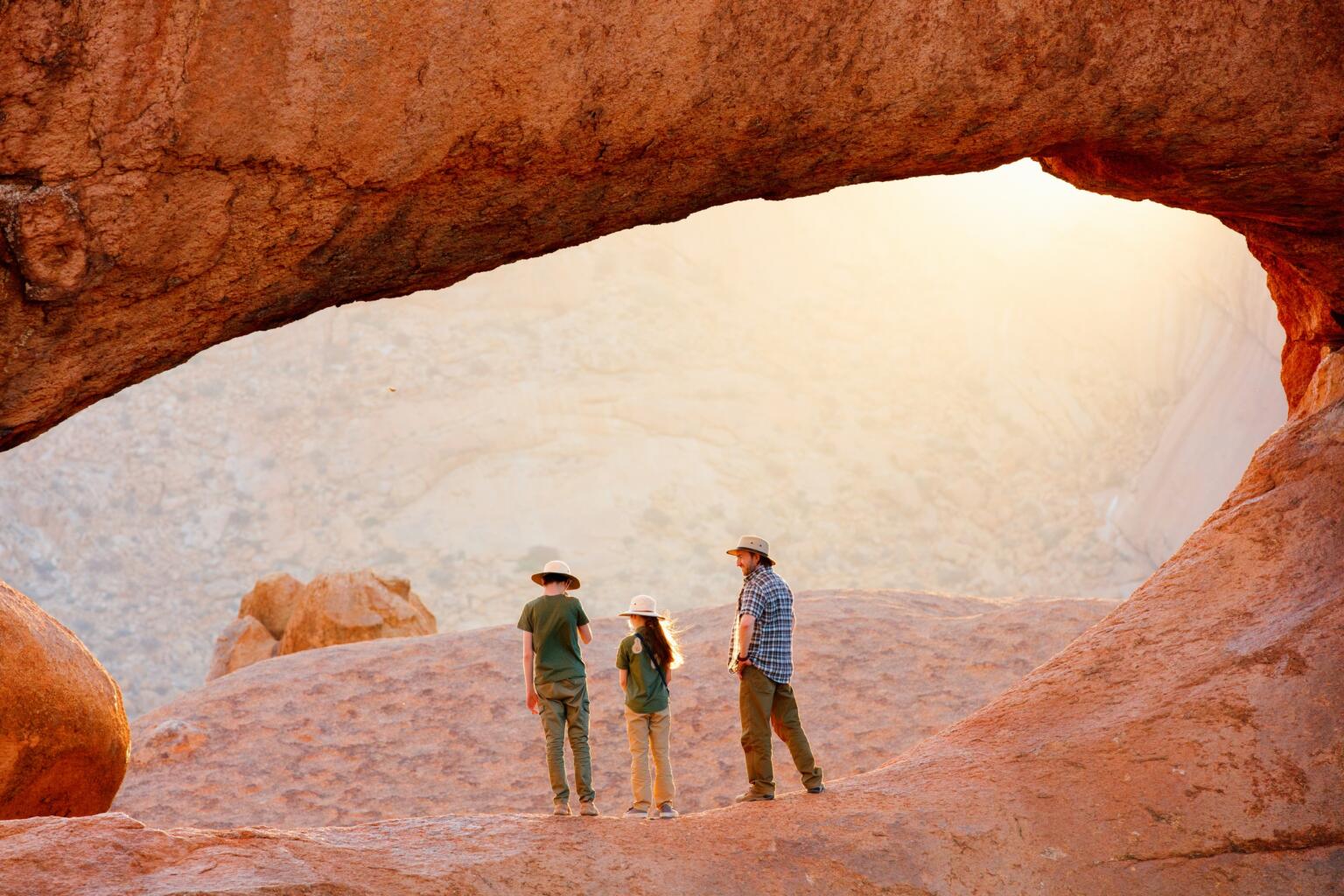
Travelling to Namibia as a family with your children is going to be an amazing thing to do. This is a fantastic family destination which can be enjoyed by children of many different ages.
It’s probably one of the best countries in Africa for a family vacation, even more so if you are considering making this a safari trip. Many families may opt for South Africa or Botswana for their safari needs, but Namibia can do it just as well – and much more safely, too.
Obviously there is plenty of wildlife and nature to explore in the country and, whilst many parents would think of Africa in general as a dangerous place to take children, in actuality, there aren’t a ton of issues facing families thinking of visiting Namibia.
Namibia does lack traditional attractions geared up for children. That means no theme parks, no water parks, no children’s museums… But that doesn’t mean that there aren’t any adventures to go on; in fact, there’s loads to do!
You can explore the wildlife of the Etosha National Park, go camping or stay in luxury lodges. Safaris are a good way to introduce your children to the amazing fauna that Africa boasts, but often this is better suited to older children; some safari companies won’t accept children under a certain age.
There are a few good reasons for that. Firstly, the distances involved in travelling around the country can be simply too much for a young child. Secondly, it can get really, really hot. Thirdly, you’re not guaranteed to see amazing animals right away, so there’s a chance they may not appreciate the adventure of it all unless they get the pay-off of the Big Five.
When it comes to the practical side of things, like accommodation, it’s usually quite easy to find fairly affordable family chalets and rooms. Supplies like baby food, powdered milk and diapers can be found at large supermarkets, but it’s best to stock up if you’re heading out into the wilderness.
If you want to do some travelling around with your children, the best way to do it is by hiring a car. The distances can be really long – too long – on public transport and are just not suited to a child.
Self driving in Namibia means you will have to pack essential supplies and enough things to keep the children entertained. Bringing your child seat from home is definitely a better idea than risking not finding one in Namibia.
Aside from all of that, the most important thing about travelling to Namibia with children is actually related to documents.
New immigration rules (enacted in 2016) mean that parents travelling with children who are under 18 have to carry with them at all times the original, or a certified copy of, the birth certificate. This needs to list the child’s and both parents’ details and short version will not be accepted.
If you’re a single parent travelling with a child, you need an affidavit with approval from the other parent, which you’ll also need to travel with you.
Note that whilst you may not be asked for this at every turn, you may get yourself into a sticky situation if you don’t have this official documentation.
Travelling to Namibia with your family definitely makes for an exciting adventure. Of course, being all about the nature, the nature can be a big risk here: make sure your children are protected against mosquitoes, that they are slathered in sunscreen, and be extra vigilant that your children don’t wander off unsupervised.
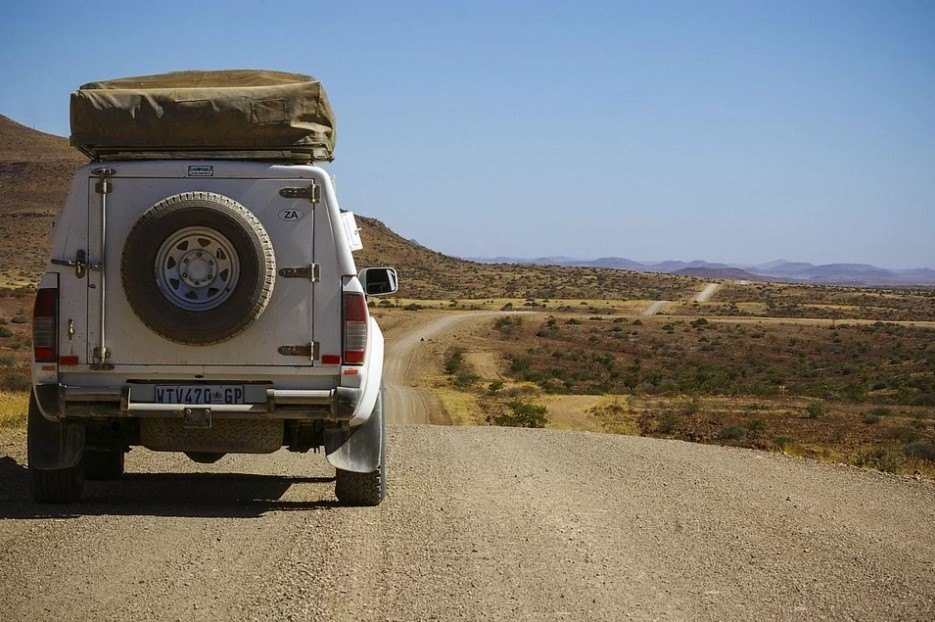
We’ve mentioned it a lot already, but here’s when we finally get into the nitty-gritty of it.
Self-driving in Namibia is a great way to see the country. Whilst it’s generally quite safe, given the state of the roads and the vehicles that you get to rent, it’s the sheer distances involved that are the main issue with driving in Namibia.
Getting behind the wheels of your own car is the best (and easiest) way to get around this country. Put simply, it’s made for a road trip.
There’s actually a pretty impressive system of made-up roads that connect the country, running all the way from South Africa to Botswana.
In towns and popular tourist sites, the roads may be unsealed (i.e. gravel) but they’re still accessible and fairly well looked after.
Roads that are C-numbered highways are passable to all vehicles and well maintained; D-numbered roads are usually passable, but generally rougher going and only navigable with the help of a four wheeled drive.
You can pick up a rental car from one of the big rental agencies at Hosea Kutako International Airport; you’ll have the biggest selection of agencies here.
For up to date information on the state of the highways and the laws in Namibia, check out the AA of Namibia ; they provide maps too.
To certify to drive in Namibia you will need an international drivers license before you touch down in the country, and then after that you can simply hit the road – and drive for up to 90 days.
Most small towns have petrol stations and fuel gets more expensive the more remote you go. They’re opened from 7am to 7pm and are fully serviced; it’s a good idea to tip a couple of dollars to the pump attendant once they’re done.
The distances are so vast in Namibia that you should really never pass a gas station or service station without filling up. It’s also a good idea to carry some additional fuel with you in a jerry can, in case you are going to a really remote area. (In addition, petrol stations can run out of fuel, too.)
In most towns, you can pick up spare parts or find someone to fix your car. You should be prepared with spare tires, jump leads and tow ropes (to name a few) and to, most importantly, know what you’re doing with them: you do not want to be stuck out in the desert.
Speaking of which, just in case, you should have emergency supplies with you. Plenty of water, plenty of food and blankets. Make sure you have an extra battery pack or two for your phone in case you need to call for help.
One very important thing to note is that, whilst it seems like an amazing adventure to explore Namibia by car, it actually has one of the highest road fatality rates in the world. With that in mind, you really do need to be careful of hazards: wild animals, pedestrians, stray dogs, potholes, other speeding vehicles, driving at night, flooded roads…
On that note, we wouldn’t recommend that you drive in Namibia if you just passed your driving test. If you’re going anywhere near gravel roads, you really do need some skill to navigate them – and you’ll need a four wheeled drive, too.
Experienced, good drivers who know something about fixing cars and tackling off road conditions: you’ll love it.
There is no Uber in Namibia. Windhoek, sadly, is not privy to the global sensation that is Uber.
The best thing to do in the absence of Uber is to get your hotel to order a taxi for you. It’s the old school Uber.
However, it’s always worth checking as situations with Uber can change, and other app-based taxi hailing companies may even pop up to fill Uber’s place. Watch this space.
Taxis in Namibia can be pretty tricky sometimes, but they’re quite a good way to get around. You just need to know how to use them, so a few insider tips can only help you in your quest to become taxi-savvy in Namibia.
There is a system of shared taxis in Windhoek. If you’re not aware of how this works, shared taxis work almost like minibuses, following a set route from main areas in townships, linking communities. Fares aren’t always the same and you can ask to be dropped off wherever you want – provided it’s on the route.
However, these taxis can be a bit sketchy. The cars are badly kept, the characters you’re sharing with (or even the drivers) might be shady, and the conditions can be cramped. Add to that a bit of dodgy driving, and you will probably agree that a shared taxi is not an ideal option.
If you want to catch a normal taxi in Windhoek, for example, you stick your arm out and wave it down towards the ground. You’ll usually find them along Independence Avenue. However, be warned: flagging down a taxi like this can end up with higher prices and not great service.
Before you get in the cab, tell the driver where you want to go and agree on a fare beforehand; there is a likelihood they’ll refuse if it’s too far out of there way.
Radio taxis are much less sketchy than hailing one off the street, you’ll get to have it to yourself, for starters, and the price will be pre-arranged. They’ll come and collect you wherever you are if you book them.
You can also find these sorts of cabs behind the Tourist Information Centre in Windhoek, on the north side of the Wernhill Park Shopping, and outside popular restaurants and bars.
Make sure you agree on a price before you get in. Fares vary depending on where you want to go.
It’s a good idea to not have large denominations of money on you, as taxi drivers may be unable (or just say they’re unable) to split the bill and give you change. It’s always best to pay with exact change.
If y0u are worried about getting into a taxi that is safe, the best thing for you is to ask your accommodation to either book one for you or to ask them for the number yourself.
In short, taxis can be pretty sketchy in Namibia. We would advise against hailing one in the street and always go with a recommended, reputable radio taxi company.
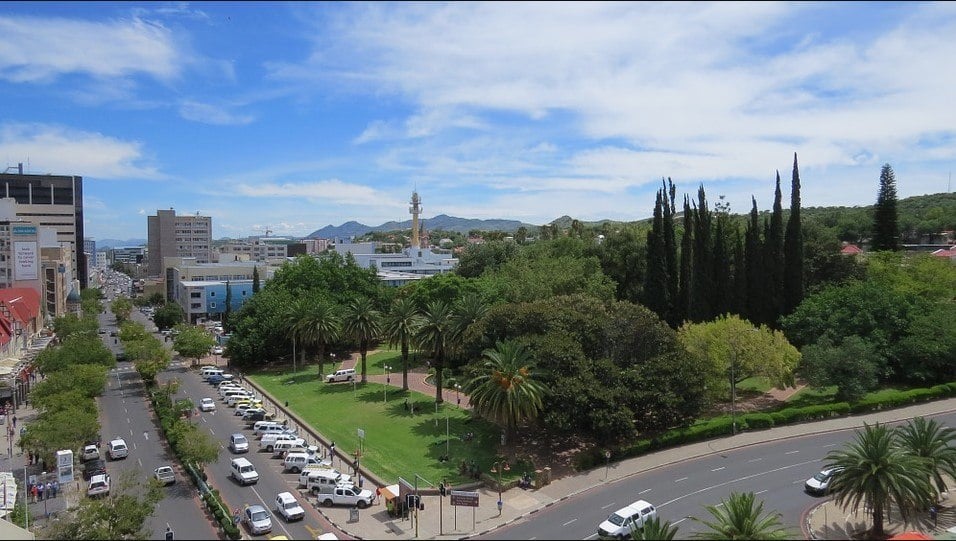
Namibia doesn’t exactly boast a whole lot of public transport on offer. What they do have here is designed mainly for local use, and not really suited to getting off the beaten track to popular tourist locations.
There are a few train lines, that runs out of the hub that is Windhoek; there are buses and minibuses that service the rest of the country.
Namibia doesn’t have the most extensive bus network in the world, let’s be honest. The best and most high-end service to get around is the Intercape Mainliner; this goes between the capital, Swakopmund, Walvis Bay and other places such as Rundu.
This bus service features things like air-con and meals included in the price. It’s fancy, and you’ll have to pay for the privilege, but if you are looking to get around in a non-local way, this is probably the only way (other than a private driver) to do it.
Another way to get around is via local kombis, or minibuses.
These travel around the country between many different destinations and even to neighbouring countries. As you may have expected these can be quite irregular, can take a long time, and are generally quite a hair raising experience.
There are other bus services that ferry people between neighbouring countries. For example, you can go (if you really want to) travel from Windhoek to Johannesburg, but it takes a painful 24 hours to get there. There’s also one to Victoria Falls in Zimbabwe, but it’s a long way to go on a bus.
The Trans-Namib Railway, the one we mentioned earlier, connects big towns between the capital and Swakopmund in the west. The trains are slow, painfully so, and they will require some degree of patience. They tend to stop at every post, even if there are no passengers, because it acts as a freight service, too. It’s not very popular, but if you like trains it could be an interesting experience.
There are also services that run south to Keetmanshoop and east to Gobabis. There are economy and business class seats on all trains, but even though they run through the night there are no sleeper cabins. Needless to say, you should watch your belongings and keep them close to you if you are travelling on Namibia’s trains.
If you feel like travelling in a bit of style, you could shell out some cash on one of Namibia’s two tourist trains. This is the kind of thing when you can hark back to the old days of rail travel aboard the veritable rail cruise that is the “Desert Express”, featuring actual beds and en suite cabins. It’s super nice and travels Windhoek and Swakopmund, stopping for lunches and game drives.
The other one is “Shongololo Dune Express” – a similarly lavish experience that can only be done on a 12-day trip, taking in the highlights of Namibia from bottom to top, wining and dining all the way.
Aside from those two expensive options, most other public transport in Namibia (perhaps with the exception of the Intercape Multiliner) are rickety and should be used with caution, though – most likely – you’ll be fine. Just bring snacks so you don’t get hungry.

There is plenty of opportunity to try some amazing dishes when you are in Namibia. This may not come as a surprise, but there’s a lot of meat on offer – vegetarians, you have been warned. What you’re doing and how you’re travelling will affect how you eat in Namibia.
In hotels, for example, half board is often on offer, whereby they’ll give you a packed lunch to take out for the day (if you ask for it). Generally, however, regular Namibian food is not typically found on tourist menus, so here are some tips on how to get to try it all…
- Make friends with a local. They will show you the best places to eat, well away from any tourist traps or fancy hotel offerings that don’t actually resemble what people in this country eat. For example, outdoor dishes like potjie and the good ol’ braai are very local experiences; getting invited along will help you get to grips with the culture of Namibia.
- Definitely try out the German-influenced cake shops, where you will be able to try out a whole load of different pastries, breads and cakes. There’s not a high chance of getting ill from apple strudel or black forest gateaux – well, only if you eat too many of them at one time.
- If you want a cooked breakfast, beware: alongside stuff you may expect, like a fried egg or bacon, you may get something a little bit strange – curried kidneys, for example.
- Meat is the main thing that people eat here since, being a desert-y country, it has to import much of its fruit and vegetables. However, you can sample squash and pumpkin, which grow here, as well as Namibian oranges and papayas, just in case you’re missing a bit of vitamin C in your life.
- Watch out for the hotel buffet. Whilst it’s all well and good to gorge yourself on all sorts of stuff for breakfast, lunch and dinner at your hotel, there is a high chance that the stuff in the metal trays and troughs has been sitting around for a while before you get to it. Opt out, or order something or order something that has to be cooked fresh instead.
- Make sure that when you do it meat in Namibia that it has been cooked well and is served to you piping hot; it’s the only way to ensure that something has been cooked thoroughly enough.
- Meat in Namibia will often include “weird” stuff like zebra and ostriches and crocodile. If you want to try new stuff, go for it, but it might be a good idea to avoid exotic meat like this since it fuels a trade in game meat that probably isn’t good for the world.
- Probably one of the most basic tips in the whole of this safety guide for Namibia, but honestly: wash your hands! Having dirty hands, and then using those hands to eat, is actually a really easy way to make yourself ill. Avoid doing so by washing your hands before you eat. Simple.
- Stock up on food at supermarkets if you will be leaving town. Make sure it’s stuff that will last you a few days – not fresh produce, for example, but something sustainable like nuts.
Whilst the stuff you get in your hotel is probably more likely going to be a local take on international cuisine (hello, pizza and pasta), the things that actual Namibian people eat are quite different. Whether you actually get to try these or not will depend on how you travel…
Oshifima , a dough-like paste made from millet, accompanies meat stew; oshiwambo is a spinach and beef dish; meali pap is a standard sort of porridge. Adventurous foodies: do some research on what you want to eat and see if you can seek it out with the help of a local!
The water in Namibia is sometimes safe to drink. Hotels and other private venues purify and filter their water, so it’s ok to drink.
However, if you are worried, you should boil the water (vigorously for 1 minute) in order to purify it.
Alternatively, the only option is to stick with bottled water. In fact, when you are heading out on a road trip into the Namibian wilderness, you should stock up on a lot of bottled water as it’s obviously very hard to come by in the desert.
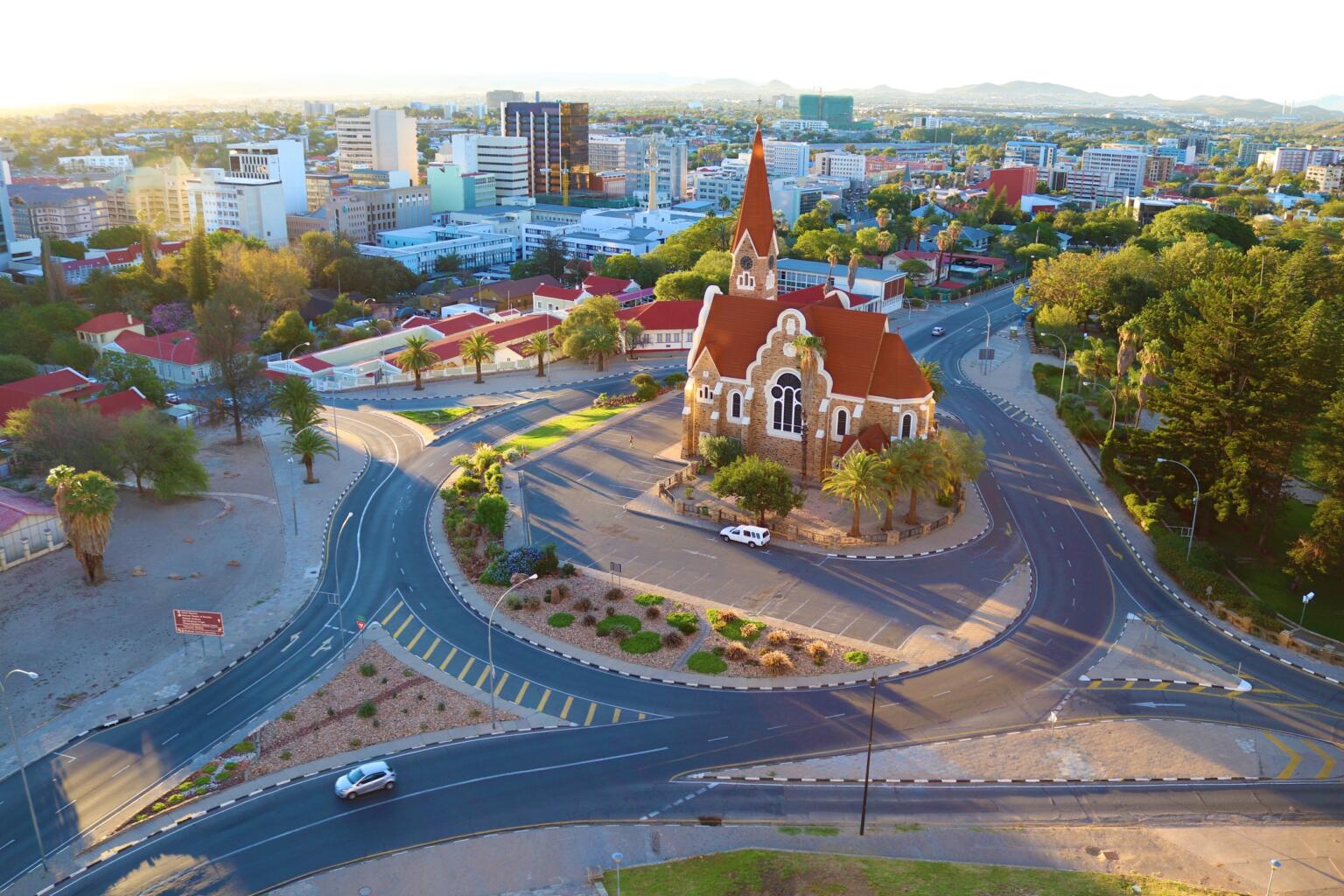
If you are thinking about making the move to Namibia, this is going to be a difficult choice to make.
It’s a very large country that’s probably very different both culturally and economically to the one that you are from, with one of the most unequal distributions of wealth and income in the world (according to the World Bank).
You could potentially, as many people do, live quite a comfortable life here – living in the suburbs, shopping in department stores and malls, driving a big car, eating well, and rubbing with the sorts of people who live like this.
Alternatively, you could live a much more basic and rural life, where the water comes from a pump, where you’ll be living much more in tune with nature. It is possible.
The climate can be hard to deal with in Namibia. Kapriva is a pretty wet area, whereas somewhere like Luderitz is much more desert-y; living in either one will mean a very different lifestyle.
Most of the people in Namibia live close to the Angolan border – the shared border with South Africa has a much harsher landscape.
If you live in Windhoek, you could probably live quite a decent, laid back lifestyle, without having to worry about drinking dirty tap water or learning any languages. You could go to a grocery store to get your food and live a pretty “normal” life, similar to the one you’re living now, maybe.
Living in Namibia in general means having access to the vast nature of the place, which is a major plus if you like nature. Some careful research may be able to land you with some property where you could eke out an existence of farming and getting to know locals, learning to speak a local language. If you want that sort of life, it has been done and you could do it too.
In general, especially in more urban areas, you will have to be live slightly differently to how you do now – that’s because of crime. Expats often live in protected housing or in a secure, private neighourhood, fenced off from the rest of town altogether. Many people live in houses with loads of rooms and a pool.
If you’re only here for the short term, however, finding a serviced apartment that suits you – most likely in Windhoek – is relatively easy. As with most moves abroad, get online, do your research, get connected to expats (past and present) and, most importantly, make sure you actually pay a visit to Namibia before you figure out if you’ll move there or not.

A new country, a new contract, a new piece of plastic – booooring. Instead, buy an eSIM!
An eSIM works just like an app: you buy it, you download it, and BOOM! You’re connected the minute you land. It’s that easy.
Is your phone eSIM ready? Read about how e-Sims work or click below to see one of the top eSIM providers on the market and ditch the plastic .
You may have imagined this already, but the healthcare in Namibia varies wildly.
It is possible to find good quality healthcare in urban areas; in Windhoek, being the capital, there is access to good medical facilities. Private hospitals are of an excellent standard and highly recommended if you need to see a medical professional.
On the other hand, public hospitals suffer from overcrowding and underfunding. If you go further into rural areas, you may not even find any medical facilities.
You could be, at some points in your trip, something like 10 to 12 hours driving distance from the nearest medical facility: not even a hospital, just a medical practitioner or even a pharmacy.
With this in mind, you should definitely travel with all the medication you may need, a first aid kit, and things such as painkillers, rehydration sachets, and anti-diarrhoea medication.
You really need to make sure you have fully comprehensive medical travel insurance. Some private hospitals, amazingly, might even need to see proof of payment before they start treatment – even with insurance. Some policies won’t even be accepted or recognised by some private hospitals, so you will really need to check that your insurance will handle it.
Pharmacies are good for basic advice, but if you need specific medication you will most likely need a prescription.
In the case of blood transfusions, there is a risk of contracting HIV; to find a reputable clinic, or for a source of safely screened blood, visit www.bloodcare.org.uk . These guys will transport safe blood, anywhere in the world, within 24 hours – it’s an incredible service.
Finally, if you have an emergency and you need medical assistance during your time in Namibia, you should dial 211111 (not as catchy as 911) if you’re in Windhoek – if you’re elsewhere in the country, dial 10111 – and ask for an ambulance. Note that it can take a while to get assistance if you are in a remote area.
All in all, the healthcare of Namibia is good – if it’s private – can be hard to pay for, and is very thin on the ground in rural areas.
Here are some quick answers to common questions about safety in Namibia.
Yes, Namibia can be safe for a solo female traveller, especially if a bit of research was done beforehand. Keep your wits about and stay alert at all times when exploring the beautiful country and you should have a trouble-free trip.
What should you avoid in Namibia?
Avoid these things when travelling to Namibia: – Don’t leave anything on display in your car – Avoid hailing taxis on the street – Avoid walking around at night – Avoid looking wealthy at all
What are the main dangers in Namibia?
The main safety concerns for visitors in Namibia are scams, robberies and pickpocketing. Tourists normally don’t have to worry about worse crimes.
Is Namibia safe at night?
We definitely wouldn’t recommend walking around at night in Namibia, especially if you’re alone. This creates risks that can easily be avoided. If possible, use taxis to get around and stick with large groups.
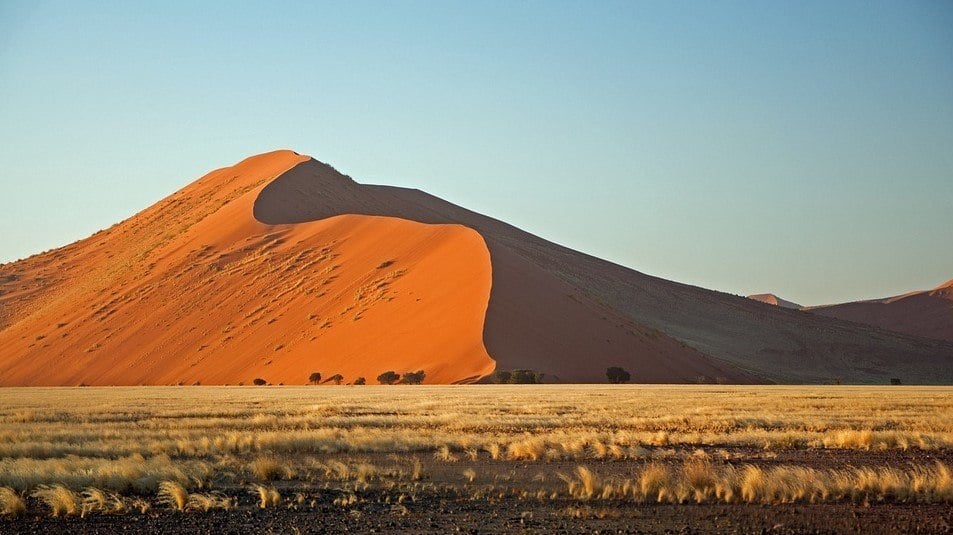
So there you have it. Whilst Namibia can be challenging, and there are real dangers, you will most probably have a safe and happy trip. Just follow the advice and guidance set out here and you should be fine!

And for transparency’s sake, please know that some of the links in our content are affiliate links . That means that if you book your accommodation, buy your gear, or sort your insurance through our link, we earn a small commission (at no extra cost to you). That said, we only link to the gear we trust and never recommend services we don’t believe are up to scratch. Again, thank you!
Lerato Bambo
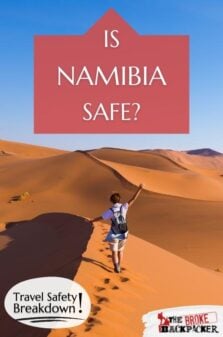
Share or save this post

Hi, as someone who is a local Namibian, just wanted to say thank you.
Hoped you enjoyed our country!
Leave a Reply Cancel reply
Your email address will not be published. Required fields are marked *
Save my name, email, and website in this browser for the next time I comment.
Notify me of followup comments via e-mail.

13 Things you need to know before visiting Namibia
by Sabine | Sep 8, 2017 | Namibia , Travel Tips | 19 comments
Some countries are regarded as easy to travel with hardly any preparation in advance being required. Some other countries require some more preparation before you visit. There are quite a few things you need to know before you travel to Namibia, especially for first time visitors and when going on a self-drive trip.

This post may contain affiliate links, which means we may earn a small commission on qualifying purchases, at no extra cost to you. For further info, please see our Disclosure
Updated version May 2020
Namibia is an amazing country with some beautiful nature and great things to do and see. I have been lucky to be able to visit Namibia on numerous occasions and every time I get more gripped by how spectacular this country is. I have also learned over the years that Namibia is a travel destination where it is important to be prepared and to know certain things before you go. I love to travel without much preparation and I am in favour of discovering new things and places with hardly any preparation and to take it as it comes. For 1st time visitors to Namibia, do take some time to prepare your trip and to get to know certain things before embarking on that wonderful journey.

Namibia is a sparsely populated country. In fact, it is the worlds second least populated country after Mongolia, where distances between major towns are large and with quite a lot of remote places. Here are 13 essential and useful tips to know before travelling to Namibia
Table of Contents
Be prepared for a lot of dust and sand while driving in Namibia
A large part of Namibia consists of desert. A desert has a lot of sand and dust of course. And there is even more dust in the air when visiting Namibia during the dry season. The dust and the sand will get into just about everything, including into your car and your luggage. If you have expensive equipment with you, best is to keep it in sealed bags or containers to keep the dust out. I do use my DSLR camera, but I keep it covered as much as possible or don’t take it out when there is too much wind. I try to keep my camera in this sling bag all the time to keep it protected. A useful tip for when you are self-driving, in the beginning of your trip, buy some plastic boxes with a sealable lid, so you can keep your food dust free while driving. Here are some more tips on what to pack when going on a safari in Namibia .
Don’t get bothered too much by the sand and dust as there is nothing much you can do about it. In the end, you are visiting a desert, and a beautiful desert for that matter. I always say, you have only truly visited Namibia if you have smelled, felt and tasted the dust.

Expect long driving distances
The land area of Namibia is slightly over 800.000 km2 (twice the size of Germany), making it a fairly large country to travel in. Most of the highlights of Namibia are spread out all over the country and in order to see the main attractions, you will have some pretty long driving distances. Around 80% of the roads in Namibia are either hard gravel roads, sand roads or salt roads, making fast driving not as safe as your normal highway roads in some western countries. The maximum advisable speed on these roads is 80 km/hour.
One of the most important pieces of advice I can give is, fill up with fuel whenever you can, especially when travelling through the more remote areas. Fuel stations are not found on every street corner and you never know when the next one will come on your path. And even then, you never know if the next fuel station will have fuel (it happens that fuel stations run out of fuel due to various circumstances).

Plan your trip to Namibia
I am normally not someone who likes to plan a trip too much in advance. I tend to go with the flow and plan my trip en route. For Namibia, I would give everyone the advice to plan at least the broad lines of your trip when self-driving. Most people will fly into Windhoek (the capital of Namibia) and start a round trip from there, sometimes also including Botswana. In order to be able to see all the major highlights in a decent time, it’s important to define how to start the round trip. What you will visit first will depend on some bookings of accommodations you may have already made. If you are travelling in peak season, you might have to book long in advance, especially in places like Etosha National Park. This information can be found the National Parks website .
Namibia is a large country and consists mainly out of gravel and sand roads with lower average speeds. The driving times will therefore be longer than expected and careful planning is needed.
About time. Up until 2017, Namibia was the only country in Southern Africa that implemented daylight savings. The first Sunday of April the clock was turned 1 hour back to GMT+1 and the first Sunday of September the clock was turned 1 hour forward to GMT+2. As a tour guide, it was important for me to keep track of this when travelling in Namibia. I managed to travel a few days in the country on the wrong time. In itself it would not be too much of a problem, as who needs to keep track of time while travelling on holiday? On the other hand, it is important in that most national parks open and close their gate at a specific time (sunrise and sunset). I once stood with a group of tourists 1 hour before the gates of Sossusvlei would even be open. Luckily there was a 24 hour fuel station in the area who was already serving coffee.
Rent a 4×4 vehicle in Namibia
Since most of the roads that you will use as a tourist are gravel roads, the best is to rent a 4×4 vehicle, or at least a vehicle with high clearance. It is possible to drive around with a normal sedan, but believe me, you will not be comfortable. A sturdy 4×4 car with high profile tyres will have better grip on the dust roads and will be smoother to drive over the heavy corrugations on the gravel. Lowering your tyre pressure will help with comfort and grip. Make sure you have a portable air compressor for if or when you drive on tar again. A second spare tyre is never a bad idea. And last but not least don’t forget to take out your international insurance.
What I would really not recommend is renting a camper van, unless it is a 4×4 camper van. More and more you see normal camper vans (or RV’s) driving around on these gravel roads and that can honestly not be comfortable for the passengers, nor for the camper van itself.

Expect extreme weather conditions in Namibia
Namibia receives very little rainfall, making it one of the driest countries in Southern Africa. Most of the nature and wildlife have adjusted to these dry weather conditions, but for us humans coming from other weather types, we need to take some measures when travelling there.
When travelling in Namibia, you can expect some typical desert weather conditions. It can get very hot in Namibia during the day and it can get very cold at night, especially during winter. During night time the temperatures can drop below zero. During the winter months, Namibia hardly receives any rain. It is really very dry, combined with some strong winds. It will dry out your skin, lips, hair and is not very good when wearing contact lenses.
When planning your activities, make sure you take the weather patterns into account. For example, when visiting the dunes of Sossusvlei during summer, try to visit early morning or late afternoon. It will get extremely hot during the day. I have seen people loosing the soles of their shoes while walking over the desert sand, where the glue just melted off their shoes and soles.
While visiting Namibia, many people underestimate the cold temperatures, especially when sleeping in a tent. Make sure to be prepared and take enough warm clothes and a good sleeping bag. Temperatures can drop to around -5˚C night.
Expect to see wildlife while visiting Namibia
One of the reasons to visit Namibia for many people is to go on an African safari and to see wildlife. Namibia has plenty of wildlife, so there are great chances of seeing the notorious Big Five animals and many more. The best place to see wildlife is of course the amazing Etosha National Park, located in the north of Namibia. What makes Etosha National Park so special to view wildlife are the many waterholes that are present all over the park as well as in each of the official lodges inside the park. The best place to see animals in Etosha are these waterholes , especially during dry season.

But not only inside the national park can wild animals be seen. Damaraland is renowned for its desert elephants who roam free in the area. And in the southern regions there are many places where one can see Zebras, Sprinkboks, Ostriches and Oryx antelopes next to the road. In the region of Aus, you can even see wild Horses.

What about water in the desert?
Most of the water in Namibia is borehole water often pumped from around 100 metres deep. Most of this borehole water is fine for human consumption, although sometimes it does have a special taste to it. In certain areas like Etosha and Swakopmund the water can have a very brackish (salty) taste. If your coffee tastes slightly different than what you are used to, it is due to the water. If you are in doubt as to the drinking quality of the tap water, ask your accommodation if it’s drinkable (which mostly it will be).
If you prefer to buy bottled water, we do recommend to buy the 5 Litres bottles and to poor it into a smaller reusable water bottles. A lot of places are very remote in Namibia and don’t have a garbage truck to pick up the rubbish on a daily nor on a weekly basis, if at all. So I discourage buying smaller bottles of water to avoid excess use of plastic. We use these types of water bottles to fill up with drinkable water. Apart from the one we use, there are many different types of water bottles available to take with you on your Namibia trip, included insulated ones to keep your drinking water nice and cold as well as special colourful bottles for kids.
Money Matters
Both Namibia and South Africa are part of the Common Monetary Area , which means that the Namibian Dollar (NAD) and the South African Rand (ZAR) are valued 1:1. It also means that you can freely use both NAD and ZAR in Namibia, but the NAD cannot be used in South Africa. That is important to know if you are travelling to both countries. Also if you are travelling to Botswana in combination with Namibia, it will be difficult to exchange NAD into Botswana Pula . Keep in mind that if at the end of your visit to Namibia, you still have NAD left, try to change them into ZAR while still in Namibia. This can be done freely in any shop, hotel or restaurant, assuming they have any ZAR. No need to go to a bank for that.
While paying with credit cards is possible in many place in Namibia, it is advisable to carry enough cash with you. It is not always possible to rely on your bank card to pay. Some smaller campsites, fuel stations or restaurants have no credit card facilities, especially in the more remote places. And it also happens that the credit card machine is down or there is no connection. Since often enough you are in the middle of nowhere, you will need to have cash with you. Keep enough with you and normally every town will have an ATM to provide you with the necessary money.

Cell phone and mobile internet network
Maybe surprising, but mobile telephone network coverage in Namibia is actually quite good considering the population density. What I would recommend is to bring a cheap (dumb) cell phone from home and buy a local prepaid SIM card. You can normally buy them in supermarkets, fuel stations or post offices around the country. We buy a prepaid SIM card from the biggest provider MTC, in case of emergency or to phone ahead to our campsite or accommodation. At the time of writing this article, Namibian sim cards do not need to be registered like they need to be in many other countries. You just pop it in and go.
As said, network coverage in Namibia is pretty good with 3G in most towns, but also be prepared for some areas to have very slow if any coverage at all. So if you need to check email, facebook or make that important phone call, do so as soon as you have signal. Most lodges and sometimes campsites will have Wifi available, but don’t expect great speeds. So my advice is, leave the cell phone for emergency calls and don’t think about the internet too much, just sit around the fire and enjoy the stars instead.

Namibia is a family friendly destination
Lots of tourists often ask us; ‘ Is Namibia safe to travel ?’ Namibia is definitely a family friendly destination. Namibia is a safe and friendly country, with good hygiene standards and is pretty easy to travel, considering some preparation in advance has been done. Also there are not many vaccinations that need to be taken (see your own doctor for medical advise) and there is only malaria in the northern area, mainly during wet season.
We don’t have children ourselves but we do see a lot of families on self drive camping holidays in Namibia. The only drawback for children that I can think of would be the long driving distances with mostly spectacular nature to see. Depending on your own children, you will know if they will like this or not.
How to best behave in Namibia
To know some of the local habits and behaviour before travelling to a new country is important, I think. Namibia is the worlds 2nd least populated country but nevertheless you will come in contact with local people and culture.
Many visitors to poorer areas have the good intention of bringing things from their own country to give to the local people. And also have this temptation of giving sweets to children, because that is what children like. My advice, don’t give anything to people on the street, especially not children. You will see children begging in some places, but rather than just giving hand outs, inform people back home how lovely Namibia is and increase tourism and therefore work.

When visiting a local Himba village, you will often be advised to bring something (which you only give it to the chief of the village). Ask your local guide what to best bring with you and if you will be going on your own, buy some food groceries like maize meal, rice, flower or even candles. Do not bring sweets for the children, they don’t have easy access to dental care, if at all.
Tipping is expected in Namibia in restaurants, bars and guiding services. The general rule for tipping in restaurants is minimum 10%.

In cities, you will see people from local tribes walking around in traditional outfits, like the Himba or Herrero woman. If you would like to take a photo, ask the person if it is ok with them. Often enough they will put out their hand and ask for money. This is a behaviour that has started due to tourism, and personally, I would discourage anyone from handing out money to take a photo. Rather buy something from their souvenir stall (which are hand made products) and ask for a photo afterwards.
Be prepared to take lots of photos
Namibia is a country that can only be described with superlatives like surreal, amazing, spectacular and awe-inspiring. With so much natural beauty, be prepared to take lots and lots of photos. But also take time to inhale the beauty through your own eyes. However, I can guarantee you that it won’t be long before you take out that camera again, and again and again. The best time for photography, as in many occasions is at sunrise or sunset. It brings out multiple hues of orange, red and yellow in the desert.

As already mentioned before, be aware of the dust, sand and wind for your equipment. It’s very fine dust and it will damage your camera and lenses if not carefully protected. I carry around a scarf type Buff so I can at all times cover my camera when holding it in my hand or in the car when trying to capture moments while driving (as a passenger of course). It will not protect completely, but it is handy to take out your camera quickly and if not needed for your camera, use it to protect your head from the sun.
What camera equipment do I use in Namibia? I shoot with a DSLR Canon 650D and use 3 lenses with it, a landscape lens 15-85mm , a zoom lens 70-300mm , and a prime lens 50mm . Namibia is scattered with the most spectacular landscapes, so the wider the lens, the better you will capture these landscapes. For wildlife photography a good zoom lens is essential. I would not take anything less than 300mm for any safari. If you love animal photography, you will be really happy with any zoom lens that will reach 300 mm or more like this one here . One day I will use a 400mm or more, I’m saving for it.

Listen to the sound of silence and watch ‘Bush TV’
One thing that is very difficult to hear in many places in the world is silence. Almost unbelievable but true, you can really hear and enjoy true silence in Namibia. I’m from Belgium and silence is golden there, or rather hardly existing. We think it is quiet, but in fact, you only realise in places like Namibia that there is no such thing as silence in Belgium (and many other countries for that matter).
There are lots of possibilities to make a campfire. It will be dark early, so make that fire and do as the bushman did to spend their evenings, watch the full program on the bush tv. And don’t forget to look up once in a while and count the stars.

Additional travel inspiration for your Namibia trip:
- Photos to inspire you to visit Namibia : Who does not love to see stunning photos of Namibia? Let yourself be inspired by it.
- Best time to visit Namibia: If you are still doubting which time of year is best to visit Namibia, in this guide we explains all the advantages and disadvantages in travelling to Namibia per season.
- Stunning campsites in Namibia : Going camping in Namibia is a great experience. The campsites are just beautiful mostly located in stunning settings. This is a list with our favourite campsites in Namibia.
- Namibia travel guide: Here are all our travel guides for planning the best trip to this wonderful country
Do you have any additional travel tips for Namibia?
Please feel free to contact us for any additional questions about travelling to Namibia.
Pin these to your Pinterest boards:

19 Comments
Thanks for this post. I’ll be travelling in Namibia for a couple of weeks. Do you think hiking boots are essential or can I get by with trainers?
I would say hiking boots are essential. In the winter they will keep your feet warm, and in the summer proper hiking boots are far less likely to melt. The terrain is also very rocky and rough in most places, Namibia being mainly desert. However, feel free to take some trainers, we do, but we also go there with flip-flops for use in showers and walking around some towns and campsites. Hiking sandals are also an option, but depending on where you plan on walking, closed shoes are a better idea for protection from things like scorpions.
This summer we go to Namibia. Loved your adventures and great tips about money and visiting the himba. Thank you and enjoying living your dreams!
Namibia looks like such an adventure! This is definitely on my bucket list. Thanks for all the great tips!
Had no idea about the money! These are such great tips. Hoping to make it over to Africa soon!
Beautiful pictures! Love your car, what a great idea with your logo 🙂 Good idea with the camera advices, my husband is a photographer and he would sure appreciate this kind of information even though its not like he has 15 lenses to choose from hehe
I’m going to take some of this advice for my upcoming trip to Tanzania. The idea of using a buff to protect your camera against the dust is really useful, and I love those trousers you are wearing in the photograph. I don’t wear shorts, but I really don’t want to be stuck with wearing those awful safari-type pants. I’m off shopping right now to see if I can pick up something similar!
Your photos are fantastic and your list is a must-read! Both well-written and valuable – for instance, I didn’t realize that the drinking water would probably be fine for us. Thank you so much for sharing!
Those are some amazing tips for visiting Namibia especially the one of not getting sweets for children as dental services are rare. From your pictures, I could clearly make out, how beautiful this country is. I would have just clicked endlessly.
This sounds like an absolutely fantastic destination. Can’t believe I’ve never heard of it! I’ve never been to any sort of desert area, and while I obviously knew it would be full of sand, I guess I didn’t realize just how many things the sand could possibly get into! Great tips for guarding against it. I definitely would have never thought to bring plastic containers!
Living in Arizona has prepared me for dust and sand anywhere! Good to note about protecting your camera. I ruined my first camera from dust scratches. Namibia looks like an amazing place to get back in touch with nature!
It really is a great place. And indeed, a lot of people forget to protect their cameras for the dust and sand, unfortunately.
Wow Namibia looks & sounds incredible! These are great tips too, I wouldnt have thought about sealed boxes to keep out the sand! The scenery is unreal, such a beautiful place!
What an incredibly cool experience.
One of my readers lives in Namibia. I know plenty about the place through her blog, vicariously.
This is not your average trip. Gotta be hardy to get around in this neck of the woods but the ample rewards including plenty of wildlife and stunning landscapes make up for the inconvenience.
Thanks for sharing.
What a grand adventure. I didn’t know how much there is to do and about the wildlife in Namibia. Beautiful pictures and good advice about what to bring – or not. Kids do love sweets!
How lucky you were to see an Oryx on the dunes at Sossusvlei. We’ve been wanting to do a Namibian road trip for ages, and this is even more motivation. As a child of Africa now living in Europe I miss watching “bush TV”.
Your photos are amazing! I went to Namibia years ago whiling cruising and went to the deserted diamond mine. It was an experience! But now I would like to see more and go on safari and see more of the beautiful landscape. You put some great tips in here too!
If I ever get to Namibia I will be all over this article. Incredible pictures to by the way! So very jealous.
Such a stark countryside – I wonder how basic things like food, water and essentials are managed day to day. Looks like a fascinating place to visit.
Submit a Comment Cancel reply
Your email address will not be published. Required fields are marked *
This site uses Akismet to reduce spam. Learn how your comment data is processed .

We're Sean and Sabine. Life partners, world nomads & food lovers. It is with The Travelling Chilli that we'd love to inspire anyone to pack their bags and to go explore the world, but particularly Africa!
For the record: Unless explicitly stated otherwise, we have in fact personally visited all the places written about.
10 ways to travel on a budget in Namibia

Oct 19, 2023 • 6 min read
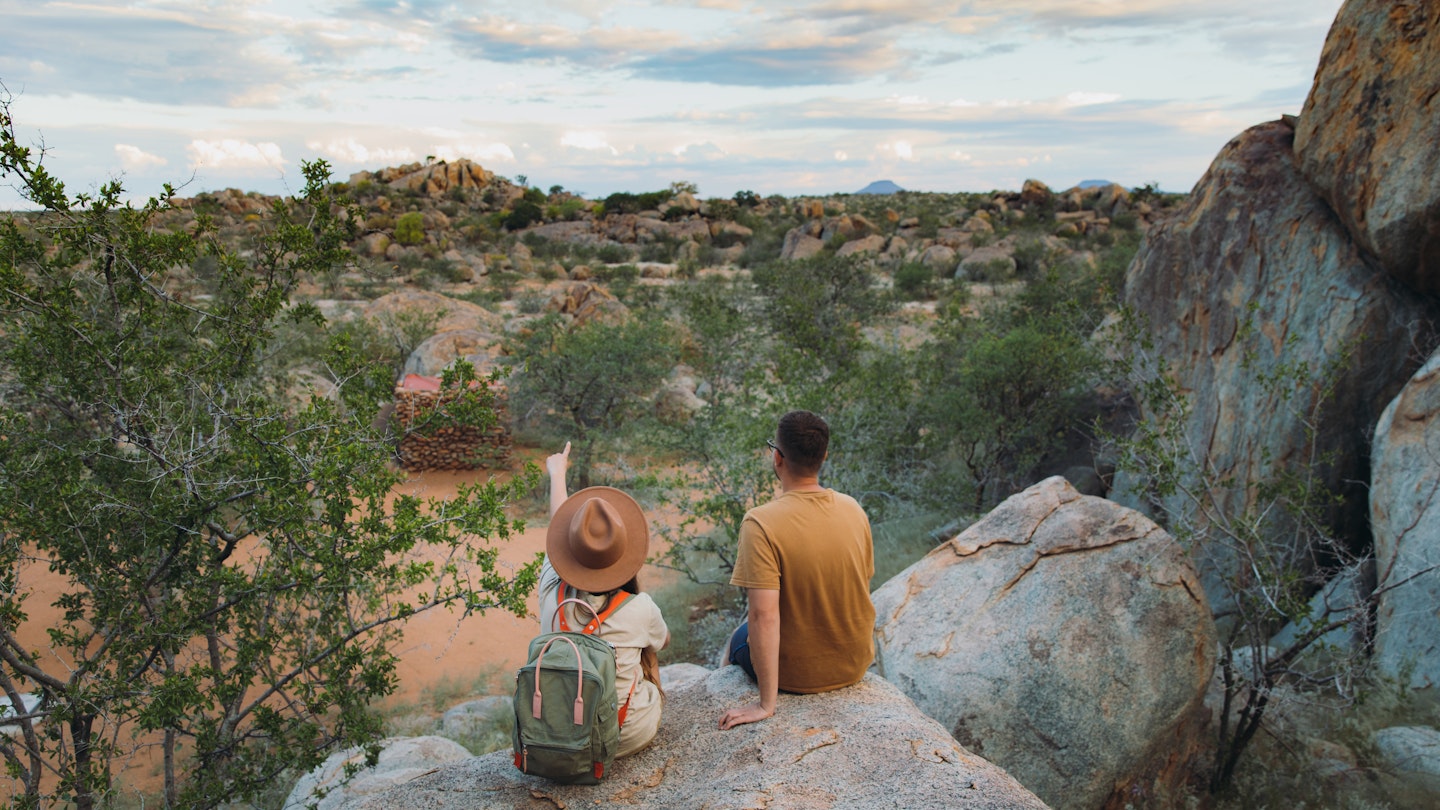
With this guide to daily costs, it is possible to tour Namibia on a budget © Anastasiia Shavshyna / Getty Images
Namibia has magnificent desert vistas, soaring dunes, a long, wild coastline and excellent tourism infrastructure.
Its good road network and multitude of well-outfitted camping sites make it ideal for independent travelers. However, distances are long, lodges are expensive and costs can quickly mount up. The biggest areas to save are transport and accommodation. Here are our top tips for creating an affordable Namibian adventure, along with a guide to daily costs.
Daily costs in Namibia
- Dorm bed in a backpacker’s hostel: from US$20
- Basic room for two: from US$50
- Managed campsite: US$150 per person
- Self-catering apartment (including Airbnb): from US$65
- Coffee: from US$1.50
- Lunch: from US$10
- Dinner for two: from US$30
- Beer at the bar: US$2
- Small packet of biltong: US$2
- 4WD rental vehicle including rooftop tent: from US$100 per day
Average daily cost: US$110–350
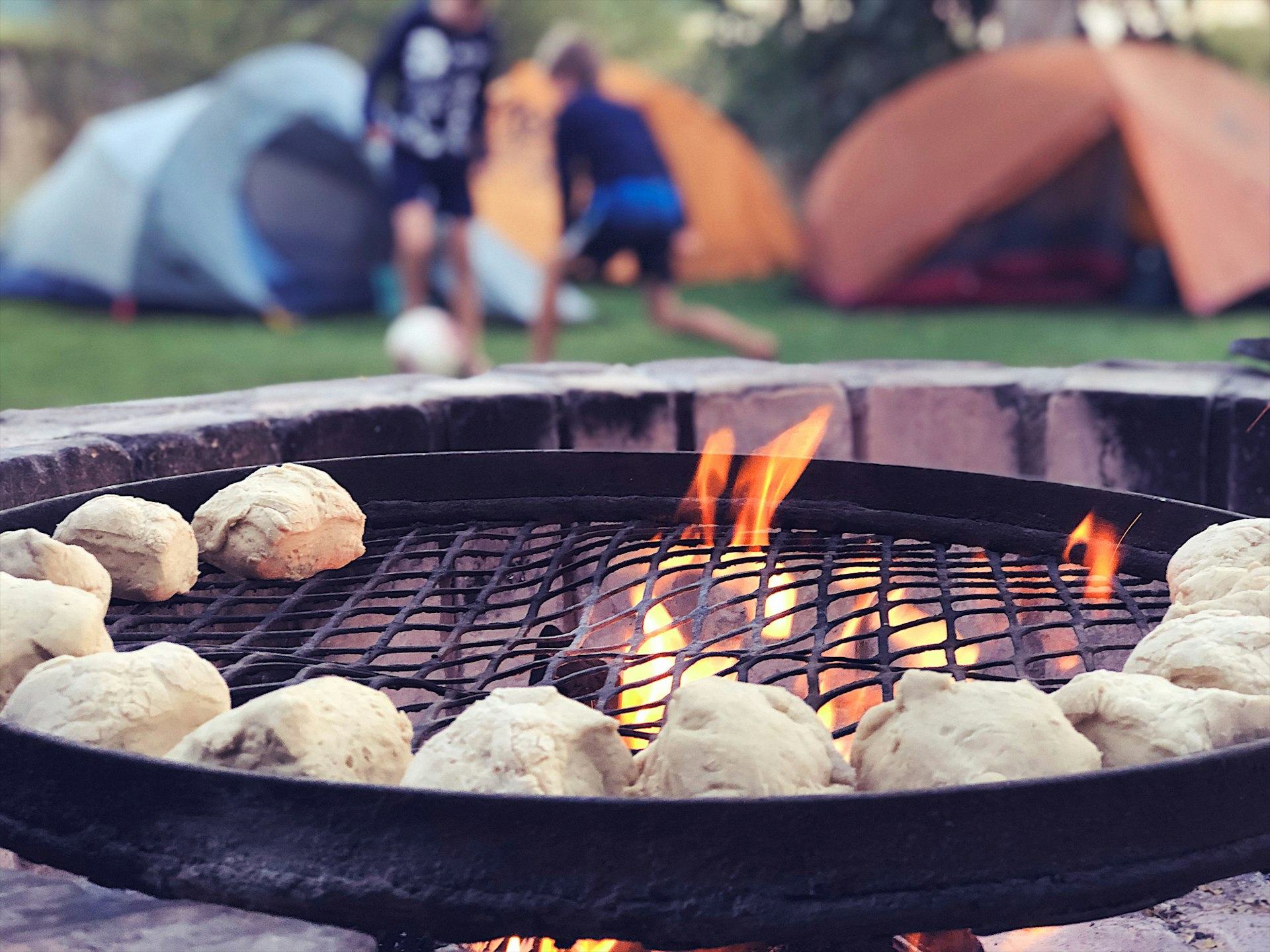
1. Fly to South Africa and take a bus to Namibia
Only a handful of airlines fly into Namibia. While good deals are sometimes available from Europe (Frankfurt, Germany is the Namibia hub), it often works out cheaper to fly into Johannesburg or Cape Town and then continue by bus or plane into Namibia. Intercape has a direct bus between Cape Town and Windhoek , and connecting service between Windhoek and Johannesburg, with prices starting about US$65 one way.
If you’re planning a regional itinerary, there are also buses between Johannesburg and Gaborone ( Botswana ), where a shuttle goes a few times weekly to Windhoek. Flying into Windhoek from either Cape Town or Johannesburg takes only two hours. If you book early enough, you can get tickets from US$150 one-way.
2. Travel during the low season
December through March marks the wet season in Namibia . Once the Christmas–New Year holidays are over, the crowds disappear and many accommodation and tour prices are reduced. Rates for lodge accommodation, in particular, can drop by up to 40% in comparison with in-season prices.
While the wetter months are not ideal for viewing large herds of wildlife, they are an excellent time for birding and seeing newborn animals. Green, wildflower-clad landscapes are another highlight, and you'll have many areas mostly to yourself. Summer rains are typically isolated and brief, mainly occurring in the form of heavy afternoon thunderstorms. By timing your excursions in the morning, you’ll still be able to get around and can relax and enjoy the welcome rain. The main exception to this is in the far north, where rains are heavier and some areas can become inaccessible.
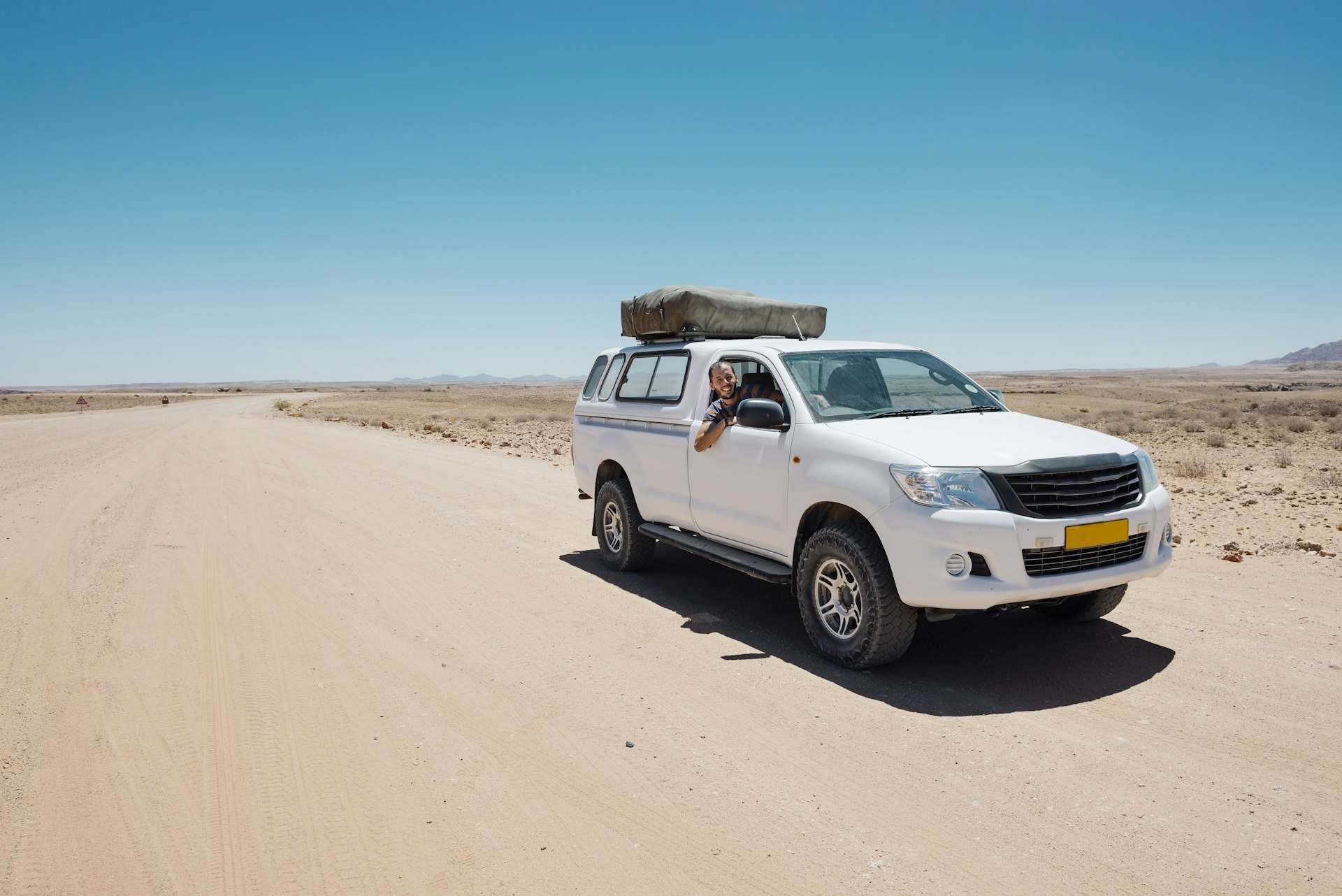
3. Self-drive your way around the country
If you’re traveling in a group, self-drive is a safe and economical alternative to a fully guided experience, and Namibia’s good road network makes it easy. A week-long scheduled group tour starts at around US$1,500 per person, while a 4-person 4WD vehicle outfitted for camping will cost from about US$650 for this same period plus the cost of fuel. Fuel costs are currently about US$1 per liter; plan on about US$50 per day or more, depending on your itinerary.
Namibia is easy to navigate and clearly signposted. Though only about 25% of the roadways are tar, the gravel roads are well-kept and generally more scenic – some are spectacular. Flat tires are the most common driver issue, so your vehicle will come with two spares. You'll want to make sure you know how to change one before your trip, and seriously consider the tire and windscreen insurance offered by rental companies.
4. If you’re traveling solo, try out Namibia's shuttle service
Born out of the COVID-19 pandemic and the global shortage of rental cars, the Gondwana Collection launched a shuttle service called Go2 Traveller Transfers . It stops at nine different areas of interest : the Kalahari, Fish River Canyon , Sossusvlei , Swakopmund , Etosha and Damaraland . At each designated stop, lodges will arrange for pick-ups and returns. At about US$45 per leg, the service offers travelers a reliable, affordable, safe, and more environmentally friendly alternative to self-driving.
The drawback is that you'll need to stay in lodges and tented camps and pay for their excursions. But with the rising cost of fuel and high demand for rental cars, this option may work out to be more affordable for solo travelers.
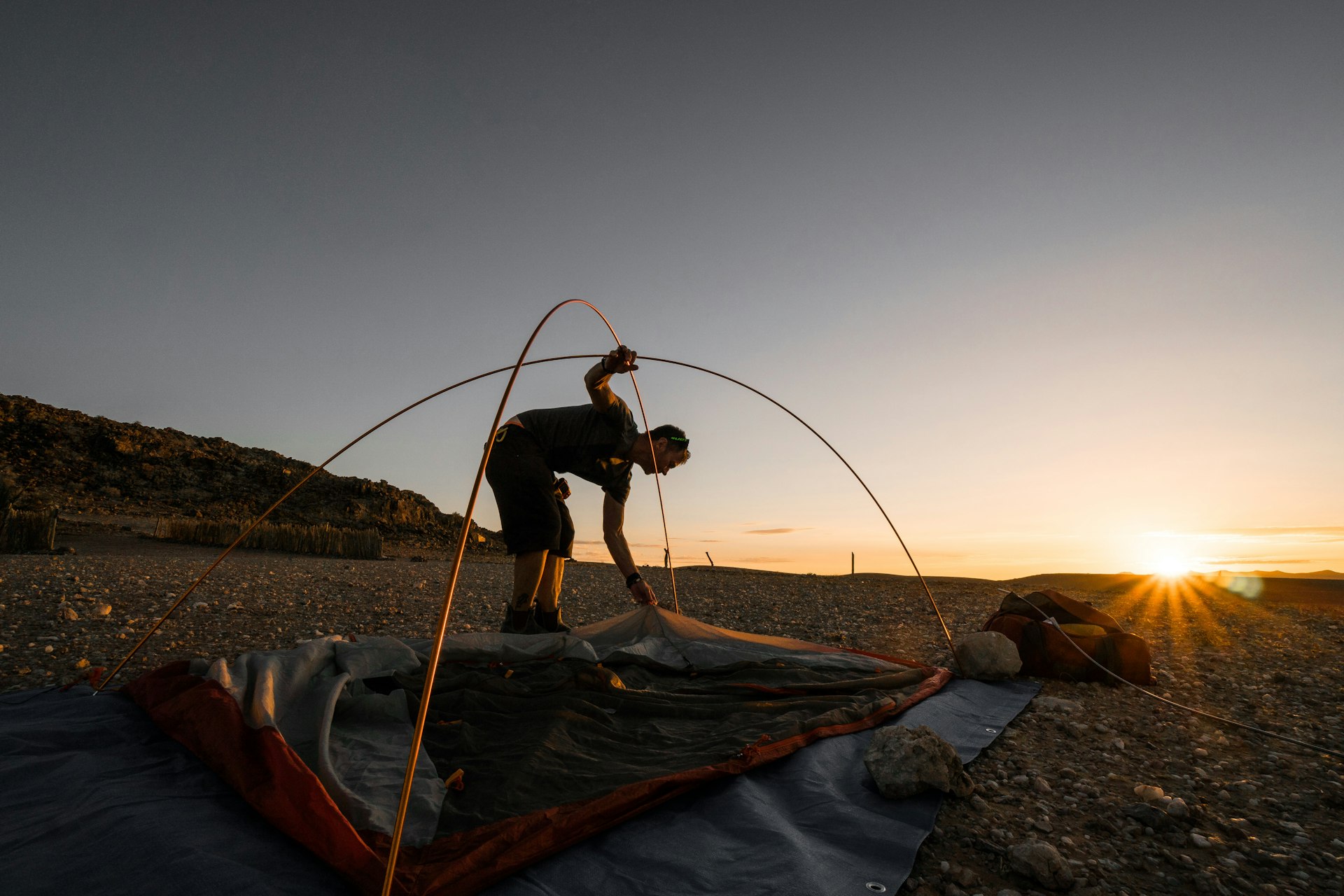
5. Join a scheduled camping tour
It’s also possible to join a scheduled guided camping program, such as those offered by Chameleon Safaris . Durations vary from three to 15 days and start at around US$500 per person. They typically include everything apart from drinks and water.
This is also a great option for solo travelers and those interested in meeting others and sharing experiences. Because the logistics are taken care of and food and fuel are included, you won’t be hit with surprise costs.
6. Stay at Namibia's vast network of campgrounds
Namibia has an abundance of organized campsites throughout the country, which are clean and affordable with good amenities. Not only will you save a ton on lodging, but it's also an excellent opportunity to meet like-minded people, exchange stories and travel tips and really get a feel for the country’s wild, empty spaces and clear night skies.
The average site costs US$30 (or US$10 per person) and has shared bathrooms, hot showers and fire pits with grills at each spot. Some camps even have shops selling food, water and other basic provisions.
7. Mix it up by staying in budget lodges and self-catering apartments
Budget lodges are plentiful in Namibia. They're located all across the country and are clean, some with refreshing pools, starting at just US$25 per night for a room with a shared bathroom. Self-catering apartments and homes average from US$65 per night for the entire place. These types of accommodations are ideal for spending a night or two between campsites. A nice hot shower and some air conditioning can help you reset and get ready for the next leg of your adventure.

8. Spend your days in Namibia’s affordable national parks
Namibia's national parks are exceptionally diverse: expansive sand dunes, vast deserts, plunging canyons, ancient salt pans and dramatic coastlines. While the country currently doesn’t offer a national park pass, entry fees are nominal. The government has added a small conservation fee to each park, bringing the total to about US$7 per person per day at most parks. Children aged eight and below enter parks for free.
9. Stock up on groceries at the beginning of your trip
Namibia's roads offer few opportunities to stop for a bite until you reach your destination, so it’s essential to shop for necessities like snacks and water before you head out. Some self-drive vehicles are equipped with a small refrigerator, allowing you to stock up and save on more than just the basics.
If you're camping or staying in an apartment, you'll have everything you need to prepare your own meal upon arrival instead of going to a restaurant in town, saving time and money. Braai (barbecue) facilities are everywhere, and sitting under the stars with dinner grilling nearby is a fabulous Namibian experience.
10. Take advantage of child and "pensioner" discounts
Children’s (generally 12 and under) and pensioners’ discounts (for those 60 years of age and older) are available almost everywhere in Namibia for accommodation and entry fees, so always ask if these categories apply to you. Some places also offer student discounts.
This article was first published September 2022 and updated October 2023
Explore related stories
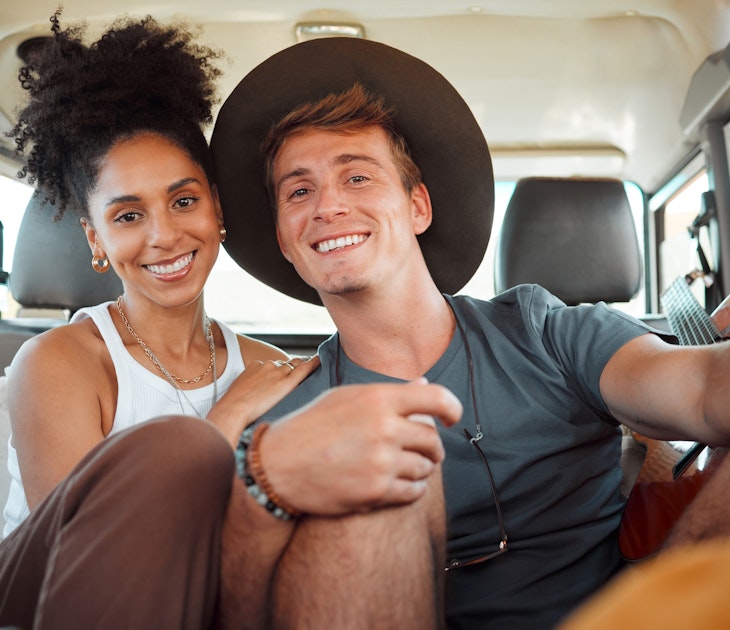
Budget Travel
Nov 30, 2023 • 9 min read
You don't have to break the bank to explore the incredible landscapes in Kenya – you just need our top tips to squeeze every penny out of your budget.
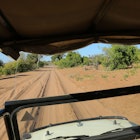
Oct 27, 2023 • 8 min read
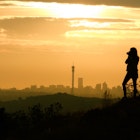
Sep 11, 2023 • 6 min read
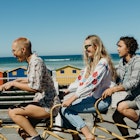
Apr 22, 2023 • 5 min read

Jan 29, 2020 • 9 min read
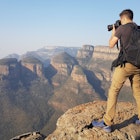
Mar 19, 2024 • 6 min read

Mar 10, 2024 • 5 min read

Feb 20, 2024 • 17 min read
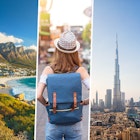
Jan 31, 2024 • 11 min read
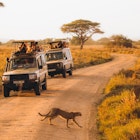
Dec 8, 2023 • 4 min read
This is Pierre and Julien. Welcome to our blog!
Gay and Normal is all about being gay nowadays. From being gay in the workplace, to travelling, organising our finances or being gays parents.
Earth Beneath Our Feet
- Dec 8, 2019
1 week in Namibia itinerary - 7 days of stunning scenery
Updated: Feb 20, 2021
Ok, let me start off by saying straight away: 1 week is not nearly enough time spent in Namibia!
This remarkable country is filled with once-in-a-lifetime experiences. From typically African exotic wildlife safaris to the world's second largest canyon. Or visiting the wealth of authentic Eco-lodges and Nature Conservancies, and the wild off-the-beaten-track Skeleton Coast. Eerily photogenic ghost towns or the many shipwrecks dotting the coast - slowly being reclaimed by the ocean. The vivid visuals of stunning Sossusvlei, or pink salt pans, pinker flamingos and the highest sand dunes in the world.
Namibia offers all this and more, interspersed with captivating views of the stark desert landscape that extends across most of the country.

Namibia is also a vast place, and preparing for a Namibian road trip is key. The distances to be covered are extensive, and made more so by the fact that they are rarely on paved roads. The quality of the gravel roads criss-crossing the country can vary significantly, and as a result you will spend many hours travelling between locations, sometimes at low speeds, often with not another soul for miles.
And so ideally you will be able to dedicate at least a couple of weeks to Namibia, to make the most of all that the country has to offer.
In our case though, 1 week was unfortunately all the time we had. In fact, in truth we only had 6 nights! As a result, we were only able to sample a small portion of what a Namibian tourist's ideal to-do list would include.

We immediately excluded any safari options, since it would consume too much of our precious limited time, and we have in any case had ample safari opportunities in neighbouring South Africa.
Conversely, our one absolute must-do experience in Namibia was a trip to Sossusvlei, and the amazing one-of-a-kind Deadvlei.
And so here is the 1-week itinerary we put together for our trip, with the very limited time we had.
On our first day, we flew into Windhoek airport from Johannesburg in South Africa, arriving around lunch time. We picked up our rental car, getting the agency to give us a thorough once-over of the car's features - including where to find the various emergency equipment and how to change the tyre for this specific vehicle.
It is a drive of around 45 minutes into the capital Windhoek, best done during daylight hours, and by the time we arrived we had just enough time to hit the supermarket before closing time - to stock up on sufficient quantities of water and snacks for our drive the next day. We checked into the Windhoek Country Club hotel for our first night's accommodation, which is conveniently located in the southern part of the city, perfect for starting our journey early the following day.
The next morning after the included breakfast at the Country Club, we set off on what would be the longest day's driving of our trip, the journey from Windhoek to Sesriem.
There are a few different route options to get to Sesriem, and we opted for the C26 / D1265 / D1261 via the Spreetshoogte pass, as recommended by our accommodation for that night - the Sossusvlei Lodge.

Pretty soon we had left civilisation and most motorists behind, as we hit the gravel road just a few kilometers outside the city.
And equally soon we were captivated by the landscape, as it changed from the dry bushveld around the capital to the even dryer desert that we would find at Sesriem. The Spreetshoogte pass was a highlight for us, with views across the valleys and the surrounding mountains.
Not long after, as we approached the small outpost at Solitaire, the condition of the road started to worsen as we joined the many other tourists to the region.
We made the obligatory fun pit stop at the Solitaire gas station, filling up our car with petrol (it is the only place for fuel for many miles!), taking a few photos with the rusty old abandoned cars, and having a piece of the renowned apple pie at the Solitaire bakery.
Refueled and refreshed, we tackled the last part of our drive down to Sesriem, and to our hotel - the perfectly located Sossusvlei Lodge .

Once checked-in, and having taken a bit of time to relax after the long drive, we decided to make the most of what remained of our first day, and once the temperature had started to drop a bit we made our way to the Sesriem Canyon.
This canyon is well worth a visit. It is only about a 5 minute drive from the gate of the Namib-Naukluft National Park (itself right next to the Sossusvlei Lodge), and large parts of the canyon are in the cool shade, making it a great way to spend some time out of the usual Namibian heat.
The local settlement of Sesriem gets its name from this canyon, which was named by the original settlers who needed Six ("Ses") leather cords ("rieme") tied together to reach the water in the canyon far below.
Our wander around the canyon took under an hour, and was a great way to finish our first full day in Namibia.
The next morning was an early start, as we set off to the main event - our visit to Sossusvlei and the peerless Deadvlei .
On the way we made a brief stop at the Dune 45, but opted not to climb it, saving our time in the cooler early morning temperatures and the softer light available for our visit to Deadvlei.
The striking images of the desiccated camel thorn trees framed by the majestic sand dunes are memories that will stay with us forever, and we cannot recommend a visit to the region highly enough!
We also took the time to visit the Hidden Vlei - which is an easy 15-20 minute walk beginning at the 2WD parking area at Sossusvlei. Hidden Vlei is its own kind of impressive imagery, however having to follow on from our just-completed visit to the unsurpassed Deadvlei, it was maybe just that little bit less inspiring by comparison.
Suitably awestruck, we hit the road again, making our way to our next accommodation - about an hour's drive north of Sesriem to what would be our favourite hotel of the entire trip - the brilliant Desert Grace Lodge .
Here we spent what remained of our afternoon, contented and relaxed, on the patio of our chalet and its private splash pool - views over the stunning surrounding landscape.
Day 4 of our journey around Namibia would see us driving further north, up to the seaside towns of Walvis Bay and Swakopmund. On the way along the C14 we passed through the Tropic of Capricorn, stopping for a quick photo op, then on through the Gaub pass and some gorgeous desert hills scenery.

Some time before arriving into Walvis Bay we hit the salt roads common in the area, and it was a relief after the bumpy gravel roads we'd been navigating thus far on our trip. The salt surfaces are incredibly smooth and are a pleasure to drive. Though do bear in mind that they can get slippery when wet, after it rains in the area or mist rolls in from the ocean, so do take care in those situations.
Soon after, we took a quick turn-off to ogle at the majestic Dune 7, purportedly the world's highest sand dune.
As we hit the coast we turned briefly south, flanking the lagoon and towards the Walvis Bay Salt Refiners and the nature reserve it forms part of. Here we saw hundreds of the flamingos that the town is famous for, as well as a fair few pelicans, together with towering mounds of white salt and a couple of the pink salt water lakes.
And we finished the day a bit further north up the coast in the city of Swakopmund where we would bed down for the evening.
Swakopmund is one of Namibia's few larger settlements, and is a great place to spend some time relaxing with all the required mod cons. There are many great restaurants, delis and coffee shops, loads of great accommodation options, and a real holiday feel about the place, and it is a big contrast to the experience driving around the rest of the country.
With the rain clouds moving in on a strong sea breeze and a chilly evening fog, this was the only time we found ourselves reaching for our jumpers on this holiday.
After a delicious breakfast at the authentically local Village Cafe, and some traditional Southern African rusks with our coffee, we were on the road again.

Continuing up the coastal salt roads north of Swakopmund, we took a drive through the unusual holiday settlement of Wlotzkasbaken. These colourfully painted houses are all off the grid, no fences separating the homes, the plots generally simply marked by a few rows of rocks. The houses are each designed and built by their individual owners, and they certainly make for an eclectic collection.
Further along the coastal road we stopped off to see the Zeila Shipwreck, the most easily accessible of the ships marooned along this aptly named Skeleton Coast, which has famously claimed so many naval vessels.

At Hentiesbaai we bid farewell to the ocean, and turned back inland on the D1918. The quality of this D road was astonishingly good, and we made great time. We were also back to the amazing views so unique to this parched land, as the captivating Namibian vistas stretched scorchingly out before us, the mountains of the Erongo region growing ever larger ahead, Spitzkoppe mountain hazy in the distance.
Our destination for that evening was the inimitable Erongo Wilderness lodge near Omaruru. This special ecological lodge, nestled into the surroundings and playing such a big part in the conservation efforts of the region, was a highlight of our trip and is well worth dedicating a night or 2 to, for sundowners with a view, delicious meals under the stars, and guided nature walks led by passionate locals.
After an informative sunrise hike the following morning, and an amazing local breakfast, we bade a reluctant goodbye to the Erongo Lodge as we set off on our final drive, making our way to our last night's accommodation.

We had chosen the Naankuse Lodge , partly for its proximity to the airport, and partly for its reputation.
Unfortunately, we were slightly disappointed with our Naankuse lodge experience, which did not quite live up to the other amazing stays we had had thus far during our holiday.
Nevertheless, Naankuse is well located for the airport, and so on our final morning, and day 7 of our 1 week Namibian adventure, we took the short drive remaining to us, back to Windhoek airport for our quick flight to Johannesburg.
Namibia had exceeded all our expectations, had given us memories we would cherish for a lifetime, and had left us wanting more! We cannot wait to return to this incredible, implacable, incomparable country to spend some more time discovering the amazing experiences it has to offer.

Recent Posts
Conrad London St James hotel - review
Crystalline lakes and endless waterfalls at Plitvice National Park
3 of the best National Trust Gardens in West Sussex
- You are here:
- Countries & Parks
- Namibia Travel Guide
- Best Time To Visit

Namibia Travel Guide Namibia
- Parks & Reserves
- Weather & Climate
- Popular Routes
- Getting There
- Malaria & Vaccinations
Best Time To Visit – Namibia

Anthony is a renowned Africa expert and author of many Lonely Planet guidebooks, including the 'Botswana & Namibia' guide.
Anthony is a renowned Africa expert and author of the 'Botswana & Namibia' Lonely Planet guide.
Anthony is the author of the 'Botswana & Namibia' Lonely Planet guide.
The best time to visit Namibia is in the Dry season from June to October, although it can be visited throughout the year. Wildlife viewing in all parks, but especially in Etosha, is best in the Dry season. The climate is generally dry and pleasant. Between December and March, some days will be humid and rain may follow, often in localized, afternoon thunderstorms. In the Wet season, animals move away from the waterholes and scatter around the park.
May to October – Dry Season – Winter
- Wildlife congregates around rivers and waterholes, making animals easier to spot – it is the best time to visit Etosha
- There are no clouds, it's sunny, and there is virtually no rain
- Even though most tourists visit during the Dry season, the parks still don't feel crowded, except for Etosha
- It gets cold at night and in the mornings – it's advisable to pack warm winter clothing during June, July and August for the cold morning game drives
Wildlife Photos

November to April – Wet Season – Summer
- After the rains, the scenery is greener and the rates are lower, because it's low season
- This is the time of the year you can see newborn animals – migratory birds are present, and birding is at its best
- Rains are mostly short showers in the afternoon and rarely have a negative impact on your trip
- It gets very hot from October to February
- It's more difficult to spot animals – this is especially true for Etosha

Best Time To Go by Major Park
If seeing wildlife is your main objective, the best time to visit all parks, especially Etosha, is in the Dry season from May to October. Namibia is a scenic country and can be visited throughout the year. The colors will be most vibrant during and after the Wet season. October to February can be unpleasantly hot.
- Etosha National Park Etosha National Park Poor "> Jan J Poor "> Feb F Poor "> Mar M Fair "> Apr A Fair "> May M Good "> Jun J Excellent "> Jul J Excellent "> Aug A Excellent "> Sep S Good "> Oct O Fair "> Nov N Poor "> Dec D
- Namib-Naukluft NP Namib-Naukluft National Park Good "> Jan J Good "> Feb F Good "> Mar M Good "> Apr A Excellent "> May M Excellent "> Jun J Excellent "> Jul J Excellent "> Aug A Excellent "> Sep S Good "> Oct O Good "> Nov N Good "> Dec D
- Skeleton Coast NP Skeleton Coast National Park Excellent "> Jan J Excellent "> Feb F Excellent "> Mar M Good "> Apr A Good "> May M Good "> Jun J Good "> Jul J Good "> Aug A Good "> Sep S Excellent "> Oct O Excellent "> Nov N Excellent "> Dec D
Want To Visit Namibia?
175 Namibia Safaris
- Namibia Family Safaris
- Namibia Camping Safaris
- Namibia Private Safaris
- Tour Operators for Namibia
Safari Tours to Namibia

14-Day Namibia Flying Safari
$18,467 to $27,144 pp (USD)
Namibia: Private tour Lodge & Tented Camp
You Visit: Windhoek (Start) , N/a'an ku sê (Wildlife Sanctuary) , Kulala, Skeleton Coast NP, Kaokoland, Etosha NP, Windhoek (End)
Wayfairer Travel
4.9 /5 – 149 Reviews

14-Day Namibia Breathtaking Adventure Tour
$5,720 to $5,940 pp (USD)
You Visit: Windhoek (Start) , Kalahari Desert, Sossusvlei (Sand Dunes) , Namib-Naukluft NP (Namib Desert) , Swakopmund (City) , Twyfelfontein (Rock Art) , Damaraland, Kunene Region, Epupa Falls (Kaokoland) , Western Etosha, Etosha NP, Eastern Etosha, Erindi GR, Hosea Kutako Airport (End)
Kubwa Five Safaris
5.0 /5 – 122 Reviews

3-Day Etosha Guided Camping Safari
$849 pp (USD)
Namibia: Shared tour (max 6 people per vehicle) Camping
You Visit: Windhoek (Start) , Etosha NP, Windhoek (End)
People Tours And Safari
5.0 /5 – 24 Reviews
Best time to visit Namibia
Book your individual trip , stress-free with local travel experts
- roughguides.com
- Travel guide
- Itineraries
- Local Experts
- Travel Advice
- Accommodation
Plan your tailor-made trip with a local expert
Book securely with money-back guarantee
Travel stress-free with local assistance and 24/7 support
A semi-arid country possessing a climate generally characterized by low rainfall and low humidity , Namibia is a year-round destination, though the searing summer temperatures (October–February), which can exceed 40 degrees Celsius in some areas, deter many European visitors from holidaying at this time.
- When's the best time to visit Namibia
- What's the best month to visit Namibia?
Best time for a safari in Namibia
When is peak season in namibia, festivals and holidays in namibia, tailor-made travel itineraries for namibia, created by local experts.
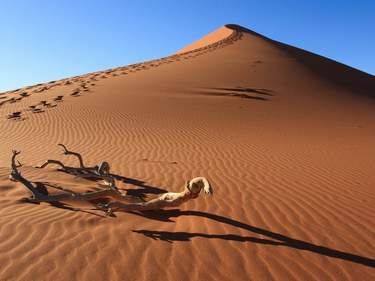
10 days / from 2600 USD
Ultimate Self Drive in Namibia
Explore Namibia on this epic, 10-day self drive trip. Highlights include the Namib, an ancient desert with towering dunes, dramatic mountains and colonial architecture at the waterfront. Additionally, you will visit the Himba people, discover Etosha National Park and more.

14 days / from 6494 USD
Epic Gondwana Adventure: Deserts, Ocean and Wilderness
Experience the best Namibia has to offer with a trip across the country, from the Kalahari to the Namib, the coast to Damaraland, ending off with an unforgettable time in the wildlife-mecca that is Etosha National Park.

8 days / from 16420 USD
Wilderness Safaris by Flight
Take convenient flights to explore the country's remote deserts, luxury lodges, safari camps, and iconic sights, from Sossusvlei's immense dunes to the rugged landscapes of Damaraland and the remote beauty of Kaokoveld.
Tailor-made trips for Namibia
When's the best time to visit Namibia
The peak tourist season in Namibia is in winter – June to September – which coincides with the dry season : there is virtually no rain and no clouds, so you’ll witness stunning night skies . It’s also easier to spot wildlife during these months as vegetation is sparse and animals are forced to congregate at established waterholes.
Days are sunny but average maximum daytime temperatures are more tolerable – 20–30 degrees, depending where you are – though they plummet at night: at the height of winter ( June–August ) they can drop to between 5 and 10 degrees, even dropping below zero in the desert and more mountainous areas.
The downside of visiting in the Namibian summer is that lodge prices and visitor numbers are often higher, although since the country is so vast, only Etosha , Swakopmund, and Sossusvlei get really crowded.

What's the best month to visit Namibia?
Namibia, a country known for its stunning landscapes and diverse wildlife, offers unique experiences throughout the year. However, choosing the best month to visit depends on what you want to see and do. Below, we take a look at seasonal changes, weather conditions, and different attractions to help you decide which time is right for you personally to travel to this breathtaking country in Southern Africa.
January in Namibia is characterized by a hot and humid climate, with temperatures typically ranging between 20°C and 35°C (68°F to 95°F). This time of year is characterized by high humidity and frequent afternoon thunderstorms, especially common in the northern regions. The landscape is lush and colorful, making this the best time to visit Namibia for birdwatching enthusiasts.
However, despite the attractive greenery, high temperatures and humidity can seem challenging, and rainfall can lead to mud and make some desert regions less accessible. Nevertheless, fewer tourists during this period can offer a more secluded vacation.
February continues the theme of the wet season, featuring heavy rainfall and maintaining the high temperatures seen in January, ranging from 20 to 35°C (68 to 95°F). Continued rainfall contributes to lush landscapes and an abundance of wildlife, especially birds, making this an ideal time for nature lovers.
However, the climate remains challenging: significant humidity and heat can make traveling uncomfortable. In addition, mud can limit access to some areas and activities.
As March arrives, rainfall begins to decrease, although temperatures remain relatively warm, ranging from 18 to 32°C (64 to 90°F). The decrease in rainfall makes traveling easier than in previous months: the scenery is still lush but less crowded, providing a quieter experience.
Although the weather is generally improving, heavy rains can still occur from time to time, which can affect the accessibility of some regions and outdoor activities.

Lion cubs in Etosha National Park, Namibia
April marks the beginning of the dry season, with cooler temperatures and less rainfall, ranging from 15°C to 30°C (59°F to 86°F). This month is particularly favorable for wildlife watching as animals begin to congregate near dwindling water sources, and the more temperate climate makes travel and exploration more comfortable.
However, you should be aware that evenings can become significantly cooler, requiring extra layers of clothing to keep you warm.
May in Namibia is characterized by dry weather, clear skies, and moderate temperatures, usually between 10 and 28°C (50 and 82°F). This period is among the best time to visit Namibia for wildlife watching and landscape photography due to good visibility and comfortable temperatures.
However, mornings and evenings can be quite cool, and as the tourist season begins, visitor numbers may increase in some areas.
June is characterized by cool temperatures, especially in the mornings and evenings, with daytime temperatures ranging from 7°C to 25°C (45°F to 77°F). The dry climate and clear skies create ideal conditions for outdoor activities and admire the rugged, beautiful desert scenery.
However, you should be prepared for very cold nights and realize that wildlife may be more scattered, as water is still relatively available outside of the central springs.

Waterberg Plateau, Namibia @ Shutterstock
In July , at the height of Namibia's winter, mornings and nights can be cold and daytime temperatures range between 5 and 22°C (41 and 72°F).
This is also the best time to visit Namibia as it offers some of the best game-watching opportunities, as animals are more likely to be found near waterholes and the number of tourists is lower than during the peak season. However, the very cold conditions in the early morning and late evening require warm clothing.
In August , temperatures begin to rise, marking the end of winter. Daytime temperatures typically range between 10 and 28°C (50 and 82°F). The rise in temperature means that wildlife begins to gather more frequently at water sources, providing excellent viewing opportunities.
However, it also coincides with the start of the high tourist season, leading to more crowds and potentially reducing the sense of solitude in the wilderness.
Namibia gets warmer in September , with temperatures typically ranging from 15 to 30°C (59 to 86°F), signifying the beginning of spring. This month is known for its peak conditions for wildlife watching and pleasant weather suitable for various outdoor activities.
However, it is also associated with a surge in the number of tourists, resulting in higher prices and potential crowding at popular tourist spots.

Trees and wooden boat reflected in water at sunset, Zambezi river, Namibia © EcoPrint/Shutterstock
In October , temperatures rise significantly from 20 to 35°C (68 to 95°F), marking the onset of the hot season. Wildlife can still be seen during this period, especially near bodies of water, as the heat causes animals to congregate in search of water.
However, the intense heat, especially in desert areas, can be challenging, so early morning and late evening are the best times for outdoor activities.
November brings hot weather and the start of the wet season, with temperatures ranging from 18 to 33°C (64 to 91°F). The change in climate revitalizes the scenery, with greener vistas and an increase in birdlife. However, the weather can be unpredictable and you may encounter both scorching heat and sudden downpours.
This month offers a unique perspective of Namibia as it transitions from dry to wet season, and is suitable for those looking for a combination of adventure and wildlife watching.
December in Namibia marks the full onset of the rainy season, bringing hot, humid conditions with temperatures ranging from 20 to 35°C (68 to 95°F). The rains transform the landscape, creating a lush, colorful environment and improving birdwatching conditions. However, increased humidity and the likelihood of heavy rainfall can affect travel and outdoor activity plans.
Despite these challenges, December offers less crowded vacations and the opportunity to see Namibia's rain-rejuvenated landscapes, appealing to those who prefer more secluded travel and enjoy the vibrancy of the wet season ecosystem.

Sunset in Etosha, Namibia © Lottie Gross
The best time to visit Namibia for a safari is during the dry season, from May to October, when wild animals congregate near water bodies, making them easier to spot. The weather during these months is mostly dry and cool, especially from June to August, providing comfortable conditions for game drives and outdoor activities.
Mornings and evenings can be cold, especially in desert areas, so warm clothing is recommended. The safari season peaks in September and October when temperatures begin to rise, but before the onset of the rainy season. This period offers excellent opportunities for game viewing, but it is also the time when the largest number of tourists are seen.
If you still want to avoid the crowds of tourists and also get good wildlife-watching opportunities, May and June are ideal, offering a balance between pleasant weather and animal visibility.
The peak tourist season in Namibia runs from July to October, coinciding with the dry winter months. During this period, the weather is mostly pleasant, with warm days and cool nights, making it ideal for wildlife watching and outdoor activities.
Tourist numbers peak, especially in popular destinations such as Etosha National Park and the Namib Desert, due to the excellent game-watching conditions and comfortable climate. Hotel accommodations and tours can be booked in advance, so if you are going to visit the country during these months, advance planning is recommended.

Oshanas, Namibia @ Shutterstock
Bank Windhoek Arts Festival
February–September. Windhoek . Annual festival of the visual and performing arts in venues across the capital, which climaxes in September. Includes the national Triennial Visual Arts competition, in which prize-winning works are exhibited.
Enjando Street Festival
March. Central Windhoek. Also known as Mbapira, this festival sees a two-day extravaganza of music, dance and colourful costumes, attracting groups from all over Namibia.
Sunday closest to Aug 23. Okahandja. Colourful Herero costumes, poetry and military parades remember those who died in the resistance against the German army.
Küste Karneval
August. Swakopmund. Annual German street carnival involving parades, food stalls and plenty of partying for adults and kids.
Lusata Festival
Last week of September. Chinchimani Village, 6km from Katima Mulilo. The annual traditional cultural celebration of the Mafwe people that takes place in the village of the tribal chief, Chinchimani Village, and attracts Mafwe from outside Namibia too.
Oruuano of Namibia Arts Festival
September & November. Soweto Market, Katutura. Organized by the Oruuano Namibian Artists’ Union, involving lots of dance and music.
Windhoek Show
First week of October. Windhoek. The country’s main agricultural and industrial trade fair, accompanied by funfair entertainment, live music and food stalls.
Oktoberfest
Last week of October. Windhoek. A German import, the Oktoberfest draws an international crowd, complete with beer-swilling, games, Lederhosen, Dimdl dresses and oompah bands.
The Rough Guides to Namibia and related travel guides
In-depth, easy-to-use travel guides filled with expert advice.
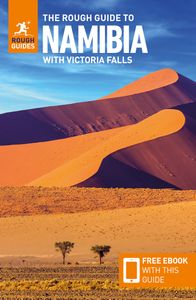
Travel advice for Namibia
From travel safety to visa requirements, discover the best tips for traveling to Namibia
- Eating and drinking in Namibia
- Getting around Namibia: Transportation Tips
- Going on safari
- Sports and Outdoor activities in Namibia
- How to get to Namibia
- Travel Health Namibia
- Travel Tips Namibia for planning and on the go
Find even more inspiration here

written by Rough Guides Editors
updated 29.02.2024
Ready to travel and discover Namibia?
Get support from our local experts for stress-free planning & worry-free travels.
- Where to stay
- Travel advice

The Cost of Travel in Namibia: My 2024 Budget Breakdown
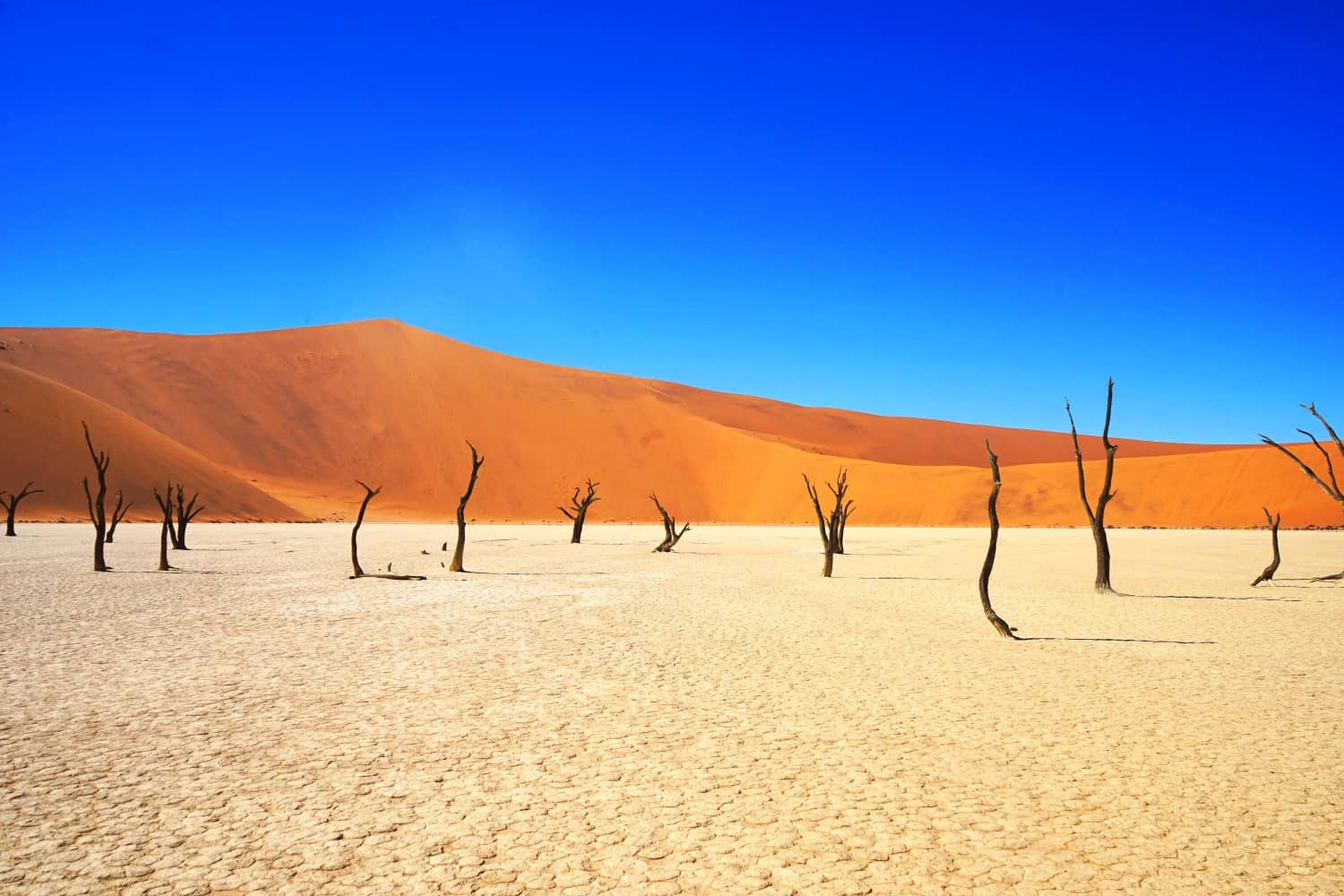
My road trip across Namibia was the best travel experience of my life.
But it was also one of the most expensive trips I’ve ever taken.
That doesn’t mean you shouldn’t go.
On the contrary, if you can afford it, you should make every effort you can to get there.
Watching the sunrise over the Namib Desert; lying in the sand dunes gazing up at the Milky Way; pulling over to the side of the road to look at a map, then sitting in awe as a dozen giraffes wander out from behind the trees to surround your car; devouring dozens of the best oysters on the planet; exploring abandoned shipwrecks on the Skeleton Coast; spending hours clambering over mini sand dunes inside houses in an abandoned ghost town; watching giraffes drink from a waterhole from your hotel’s infinity pool… I could continue for hours, because I experienced hundreds of magical moments in this country.
Needless to say, it’s totally worth the expense to travel there.
Here’s how much you can expect to be up for. As always, all prices are in US dollars with the local currency included in brackets afterwards.
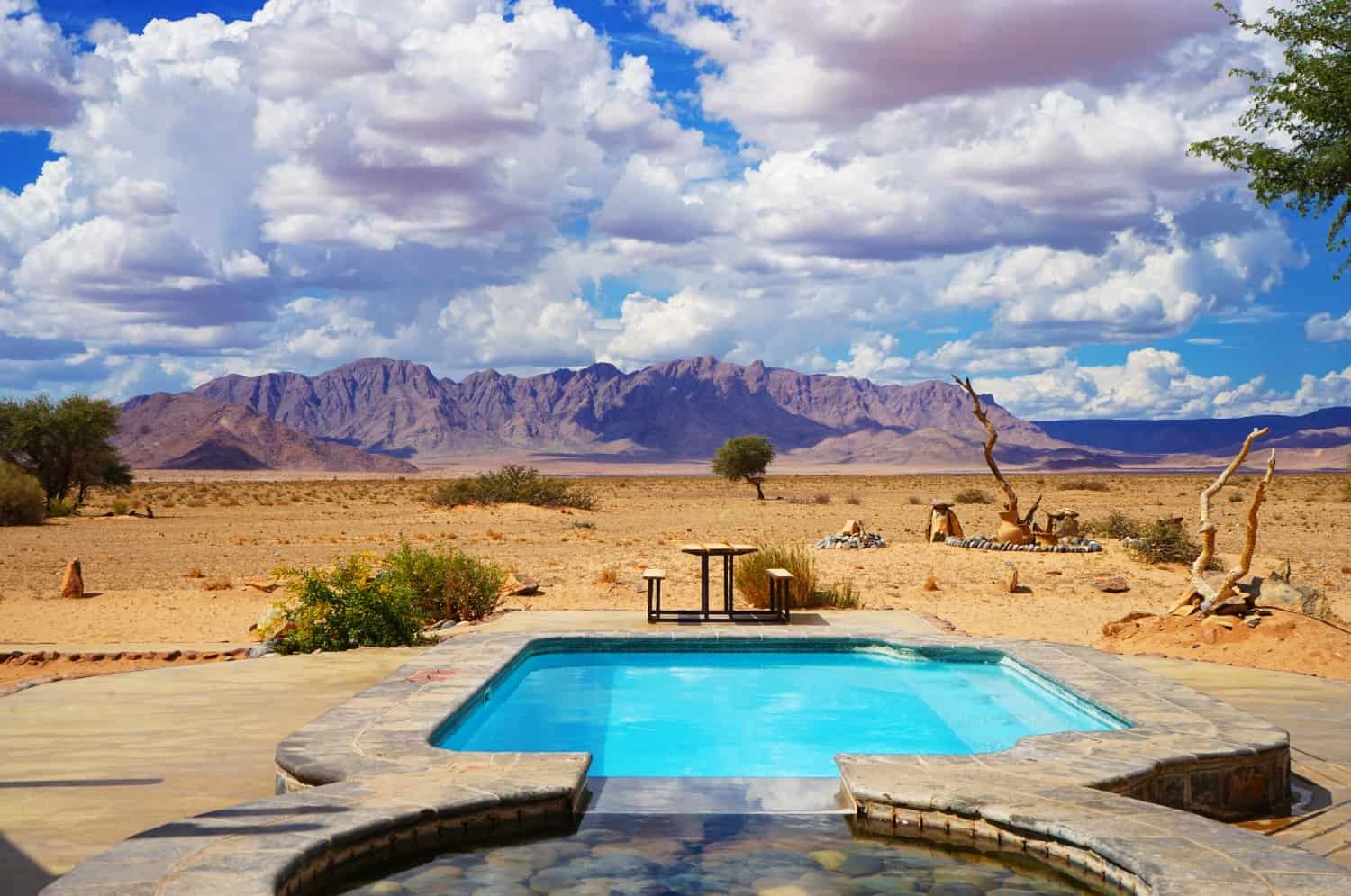
The Cost of Accommodation in Namibia
Accommodation is the most expensive part of Namibia travel because there are basically two options: camping or expensive. If you’re not down for carrying camping gear around with you, there are close to no budget options.
You can therefore expect to pay around $100 a night in low season (December – March), and up to double that when the tourists arrive (June – October). The one positive to spending a lot of money on accommodation is that you get what you’re paying for: I felt as though we were receiving wonderful value for money, even if it was over our typical budget — it wasn’t like we were paying $100 a night to stay in a rundown motel. Instead, I stayed in some of the most beautiful hotels of my life in Namibia, and the accommodation turned out to be just as much a highlight as the landscapes.
Here’s where we stayed, in order of when we visited, and for how long, in case you want to recreate my adventure (you should): The prices are for two people staying in a double or twin room in shoulder season.
Ovita Wildlife Restcamp : $92 (N$1730) per night. We stayed for one night.
We landed in Windhoek, but wanted to stay outside of the city, so Ovita Wildlife Restcamp was a logical place for us to stop. It provided the perfect welcome to Namibia: we were the only people staying the night at the lodge and were at least an hour’s drive from the nearest signs of civilisation. This lodge was so peaceful! We had sundowners on a raised terrace overlooking a lake filled with hippos and crocodiles, ate a delicious meal of warthog fillets that was one of the best dinners of our trip, and fell asleep to the sounds of hippos snorting outside our room. I loved it here and would recommend it as an ideal place to stay if you don’t want to spend a night in Windhoek.
Halali Camp : $135 (N$2540) per night. We stayed for two nights.
If you want to stay within Etosha National Park (and you should), your options are limited to five lodges spread out inside the park. Halali is in the centre and we stayed there first. The lodge was lovely, and I loved having a jacuzzi in our garden for hot tub times under the stars. The lodge’s waterhole attracted black rhinos at night, which was incredible to witness. If you’re traveling in low season, keep an eye out for specials — they sometimes discount rooms quite heavily at this time.
Okaukuejo Camp : $184 (N$3880) per night. We stayed for one night.
Okaukuejo is located west of Halali and made for a logical stop for our third night in the park. After spending time in small and quiet Halali, Okaukuejo was a noisy surprise. It was larger, louder, more expensive, and jam-packed full of tourists. Having said that, our room was nicer than in Halali, there was a swimming pool to cool off in, and there was a cheap burger place to grab lunch from, which was rare in Etosha. Breakfasts and dinners were standard buffet fare, and the staff were wonderful.
Vingerklip Lodge : $112 (N$2110) per night. We stayed for one night.
Vingerklip was my favourite lodge of the entire trip, and the perfect stopover between Etosha and Swakopmund. Set in Namibia’s version of Monument Valley, it feels as though you’re a thousand miles away from civilisation when you stay here. There were some incredible swimming pools overlooking a waterhole that attracted dozens of giraffes, but the restaurant was the highlight for me. You had to climb up some rickety scaffolding in order to reach the top of a nearby cliff, but eating dinner while overlooking an enormous canyon was a highlight of the entire trip.
At the Sea Boutique Guesthouse : $98 (N$1840) per night. We stayed for three nights.
At the Sea guesthouse was exactly what we needed for our three nights in Swakupmond. It was an easy walk to the beach and the town centre, so after thousands of kilometres of road tripping, it was nice to hardly need to start the car for a few days! The room was large and clean, Dave loved having a Nespresso machine in the room for his morning coffee, and we both really enjoyed the free breakfast that came with the room rate. The staff were super-friendly as well.
Sesriem Desert Camp : $143 (N$2700) per night. We stayed for one night.
If Vingerklip was my favourite lodge of the trip, Sesriem Desert Lodge comes in at a very, very close second. The photo at the top of this section is Sesriem Desert Camp and if that doesn’t meet the definition of oasis, I don’t know what does. We were staying in a luxury tent here, and while it was basic, the pool, bar, and views more than made up for it. The dinner buffet was surprisingly great for Namibia.
Betta Camp : $69.50 (N$1300) per night. We stayed for one night.
Considering we picked Betta Camp because it was the cheapest option between Sesriem and Luderitz, I was pleasantly surprised. This was the cleanest room we stayed in in Namibia, the space was surprisingly modern, and I highly recommend it. The owners were lovely, the desert views were badass, and the lodge had an amazing gift shop where I may have spent far too much money on an enormous guinea fowl statue. I seriously recommend staying here if you’re going to be passing through.
Kairos B&B : $58 (N$1100) per night. We stayed for one night.
If you want to visit the ghost town of Kolmanskop, you’ll most likely stay in nearby Luderitz. Kairos B&B was an affordable and decent hotel on a small peninsula with a nearby flamingo colony. There was A/C, parking spaces, a clean, modern room, and a gorgeous view over the ocean. It was great!
Maltahohe Hotel : $106 (N$1980) per night. We stayed for one night.
I’ll be honest with you: there’s absolutely nothing to do in Maltahohe, but it’s a logical stopping point between Luderitz and Windhoek, and we liked the Maltahohe Hotel a lot. There was a swimming pool, beer garden, and bar/restaurant on site, so we had everything we needed to recover from yet another long drive over gravel roads. No complaints here!
The total cost of accommodation in Namibia was: $1328.50
The total cost of my share of accommodation expenses in Namibia over two weeks was: $664.25.
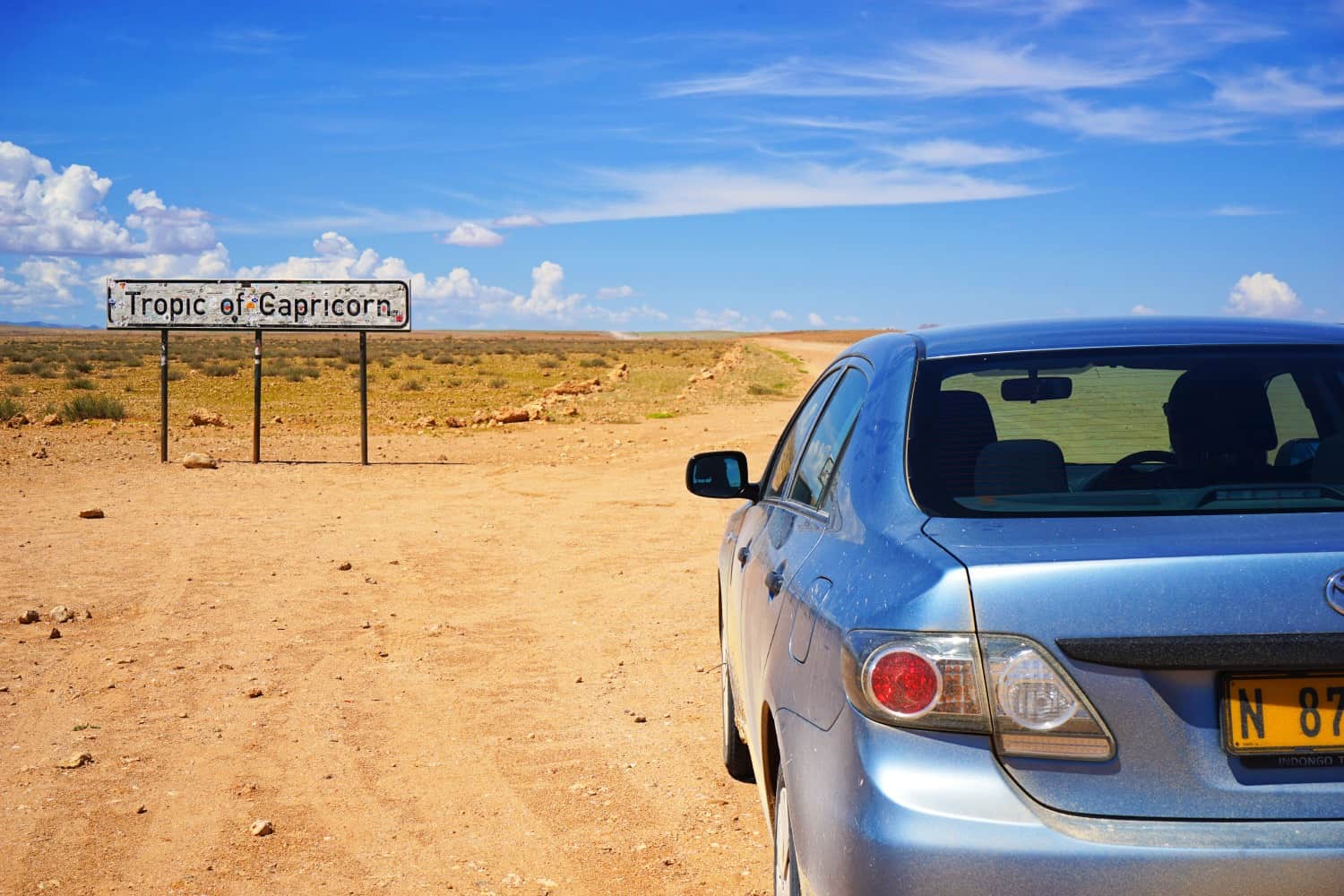
The Cost of Transportation in Namibia
There aren’t many ways you can cut down on transportation costs in Namibia. Buses don’t service many parts of the country, and the limited passenger trains that used to exist have been suspended indefinitely since the pandemic, so you’ll most likely be hiring a car in order to get around.
If that’s a complete impossibility for you (e.g., you can’t drive), you may need to limit where you plan to go, and/or take the shared minibuses that locals use to get between towns. Prices vary between about N$100-400 depending on distance, and they leave when full.
One of the few routes of interest to tourists that you can travel by some form of public transport is between Windhoek and Swakupmund/Walvis Bay on the coast. Private pre-booked shuttles cost around $16 (N$300) with companies like Carlo’s , and take 4-5 hours.
To see more of the country, especially the more remote parts (and there are plenty of those!), you’ll really need your own vehicle. While there are many guides online insisting you need to hire a 4×4, we opted for a Toyota Corolla and didn’t feel as though we needed much more.
Some more ground clearance would have potentially prevented part of our car’s undercarriage from falling off[!], but we definitely didn’t need any additional traction to what we had. You’ll save a lot of money by opting for a smaller car, so if you have experience on gravel roads, don’t sweat it and go for the cheaper option. With car insurance, of course!
Car insurance is totally an essential for Namibia, as the country has one of the highest rates of car accidents in the world. It’s likely you’ll get a flat tyre at some point, and the burnt out wrecks we spotted on the side of the road was a sobering reminder that accidents often happen. We just bought car insurance with the company we booked with and they fully refunded us for the tyre we needed to replace on our trip with no questions asked.
- Toyota Corolla hire for 12 days with Rentalcars.com $565 (N$10635)
- 12 days of full car insurance: $164 (N$3090)
- Cost of petrol for 12 days: $228 (N$4290)
- Cost of shuttle transfer at Sossusvlei to get to Deadvlei: $9 (N$170)
The total cost of my share of transportation expenses in Namibia over two weeks was: $487.50.
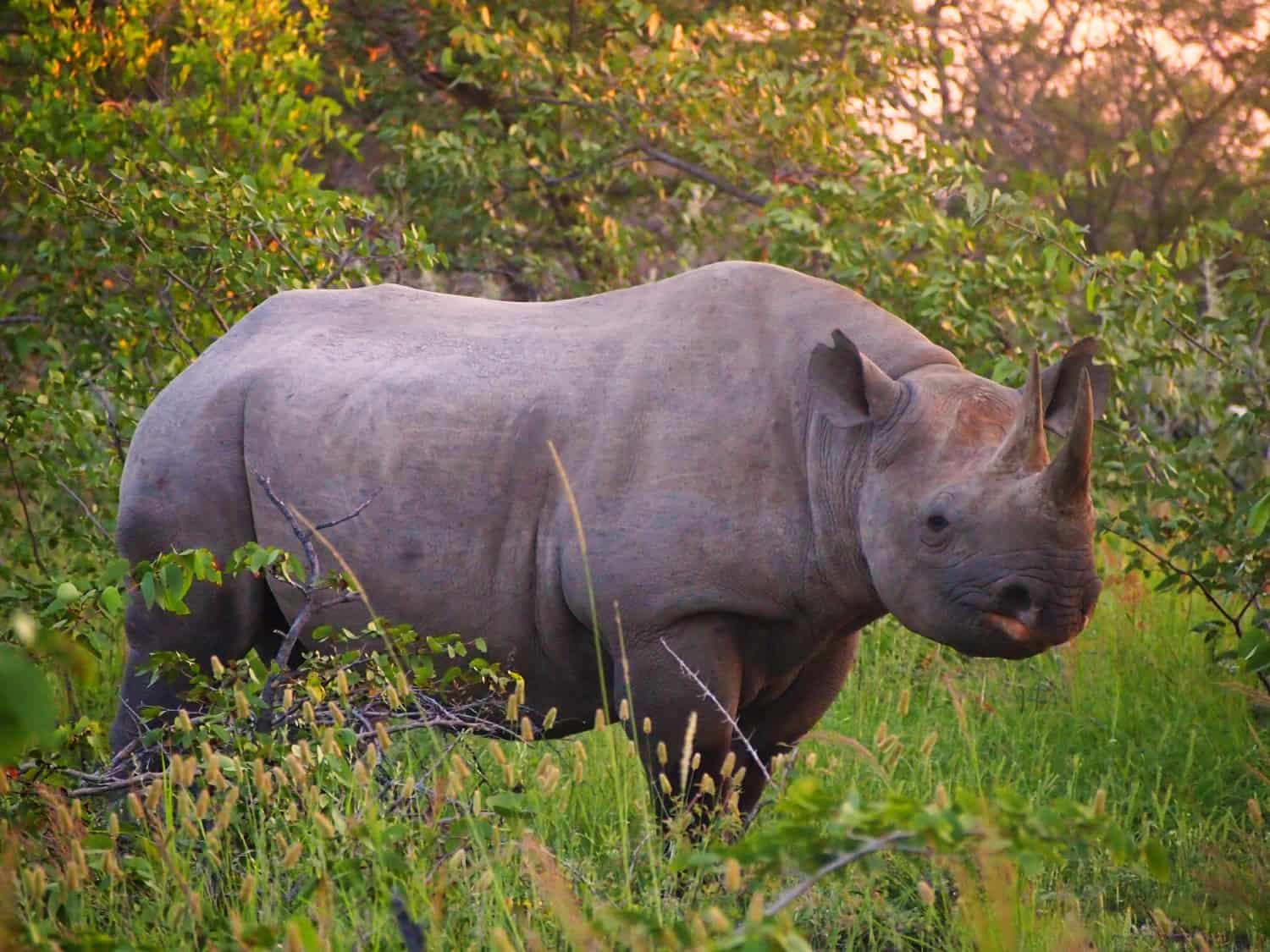
The Cost of Food in Namibia
The cost of eating in Namibia varied from place to place.
When we were staying in or driving through towns, we could grab a meal for $5-10, but when staying in the lodges, there were no alternative places to eat at unless we fancied a four-hour round trip (we did not), so we were at the mercy of their pricing. We never felt ripped off, but we didn’t exactly feel like we’d gotten a bargain either.
The most expensive meals from our time in Namibia was the ones we had at the lodges in Etosha National Park. There, they charged almost $20 for what was often a pretty average buffet dinner. In general, though, we paid around $7-10 for breakfast, $10 for lunch, and $15-20 for dinner.
One benefit of the buffets, at least, was the variety of different game meat on offer that meant I could try all sorts of things without having to take a chance on just one dish. I had kudu, oryx, zebra, and impala, which were all great, but my favourite was definitely the warthog!
We generally had our best meals on the coast; seafood for obvious reasons, but other things as well. That’s at least partially due to there just being a lot more options there: there’s not much pressure to make amazing food if the nearest competition is several hours away!
In Swakopmund, for example, we had a great breakfast at Village Cafe. Dave had a breakfast of bacon, sausage, egg, and toast for $4 ($N70) , with a big mug of coffee for another $1.30 ($N24) . I really enjoyed my smoked salmon roll with scrambled egg ($5.60/$N105) and orange juice ($1.40/$N26) . That night, we went for a very good meal at Bits ‘n Pizzas, where I had a delicious veggie supreme pizza ($10.50/$N190) .
Snacks are an essential part of road tripping in Namibia, as you’ll rarely be near to a restaurant when you want to eat. At all times we carried a bunch of potato chips, water, and fruit and replaced them every few days when we passed through a town. We’d often eat them while out exploring in Etosha, since it was too far to go back to a camp for lunch.
The total cost of my food in Namibia over two weeks was: $448.
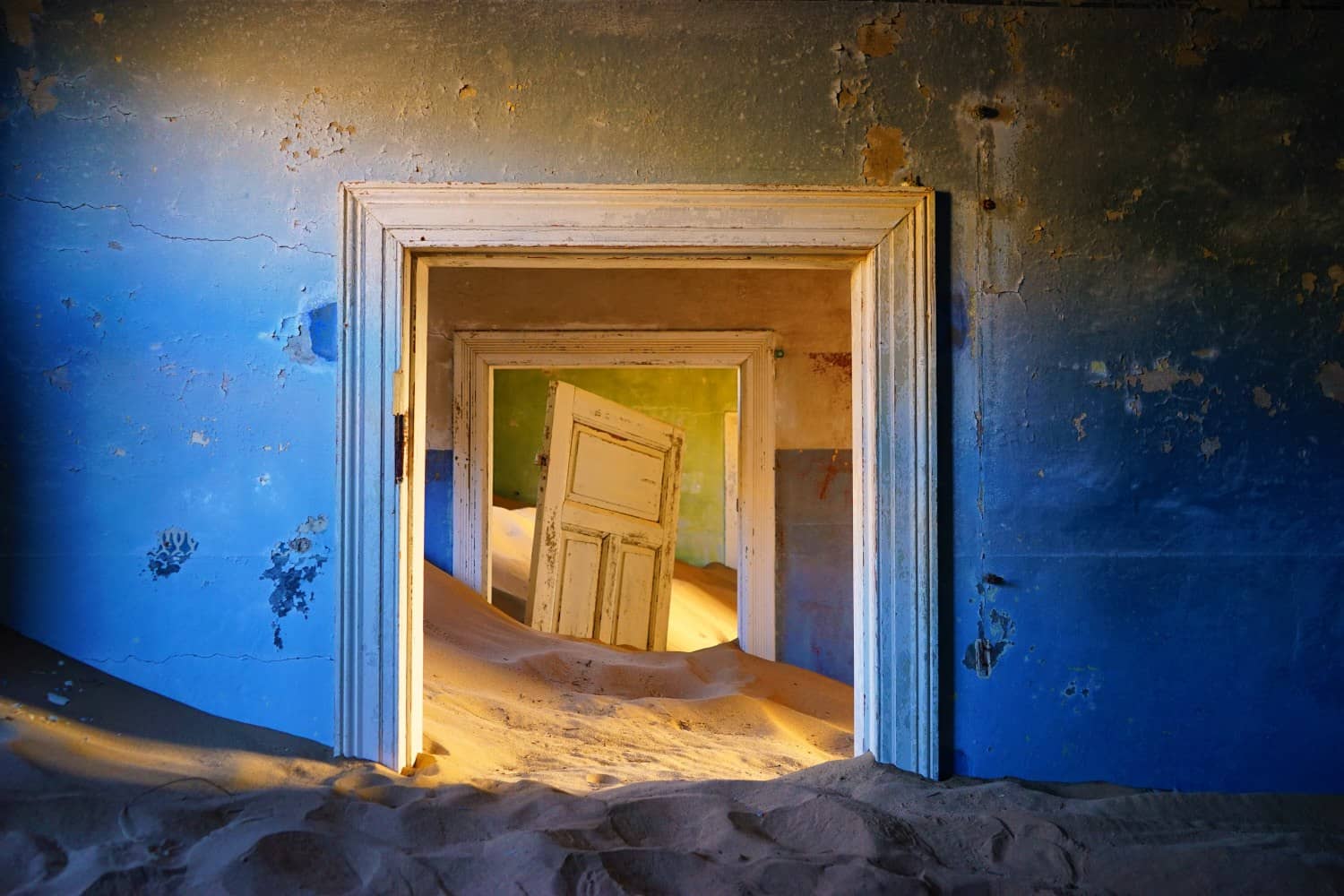
The Cost of Activities/Entrance Fees in Namibia
Activities and entrance fees were reasonable in Namibia and I didn’t feel as though anything we did was overpriced. The most expensive activity of our trip was the seal-watching tour we jumped on in Walvis Bay, which came in at $70. For that, we spent three hours on a catamaran, drinking champagne, eating some of the best oysters of our lives, and spotting seals along the coastline. We even spotted the super-rare and super-weird sunfish , which totally made the trip for me.
Aside from that, the biggest expenses we encountered were entrance fees, which didn’t feel extreme. You can read more about each activity we did in the links below, from visiting the amazing ghost town of Kolmanskop (in the photo above) to scaling the dunes at Soussusvlei, wildlife spotting in Etosha National Park, and plenty more!
- A seal-watching tour in Walvis Bay : $70 (N$1320)
- Entrance to Kolmanskop ghost town + photography permit: $19 (N$350)
- Entrance to Etosha National Park : $8 (N$150) per day
- Entrance to Sossusvlei : $8 (N$150)
The total cost of my activities and entrance fees in Namibia over two weeks was: $121.
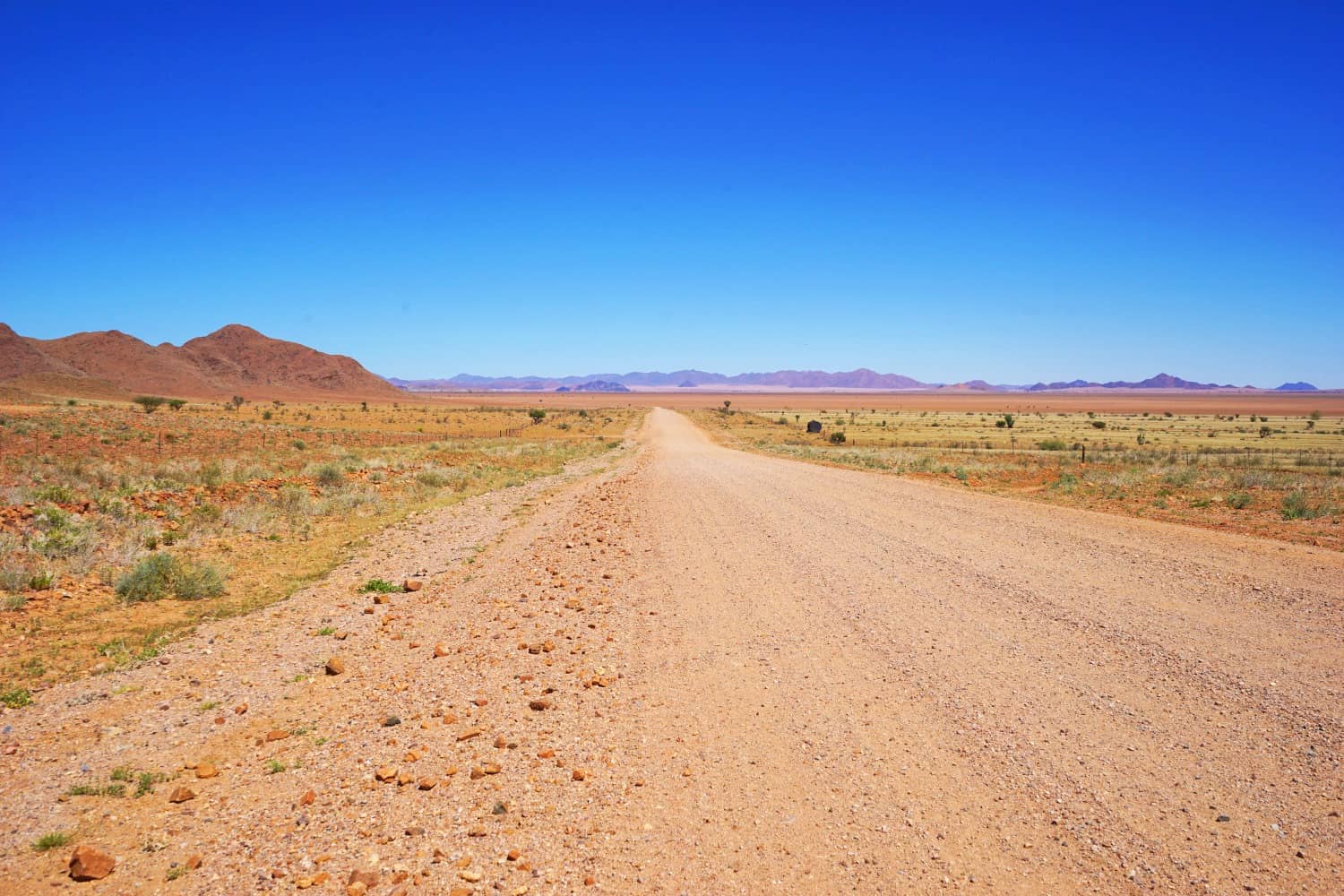
The Cost of Random Stuff in Namibia
Anti-malarial tablets: Anyone who thinks anti-malarials are worse than malaria has never had cerebral malaria. Namibia has malaria in the north of the country, so I took malarone for the four days I was in a high-risk area, followed by the next seven days, as required. I opted for generic malarone tablets from Nomad Travel Clinic on Bond Street, London, which are priced at $2.85 per tablet . Doxycycline is a much cheaper alternative at $0.32 per tablet , but requires you to also take the tablets daily for a month after you leave the country and is an antibiotic, which I try to avoid taking if at all possible.
Namibian SIM card: We picked up a SIM card at Windhoek Airport upon arrival and it was simple to do. The SIM card costs 50 US cents and 2 GB of data was a whopping $2.50 . We didn’t have much coverage in the country, but it was useful to have at times, and we definitely didn’t need more than 2GB over our two weeks.
Travel insurance: You know I’ll always yell at you if you’re dumb enough to skip out on travel insurance , but in Namibia, it’s an essential. Why? Because Namibia has the highest car-accident death rate in the world, with 45 people killed on the road for every 100,000 citizens. On top of that, malaria hangs out in the northern parts of the country, and there are several other awful-sounding tropical diseases that you definitely don’t want to contract.
Travel insurance will cover you if your flight is cancelled and you need to book a new one, if your luggage gets lost and you need to replace your belongings, if you suddenly get struck down by appendicitis and have to be hospitalised, or discover a family member has died and you need to get home immediately. If you fall seriously ill, your insurance will cover the costs to fly you home to receive medical treatment.
I use SafetyWing as my travel insurance provider, and recommend them for trips to Namibia. Firstly, they’re one of the few companies out there who will actually cover you if you contract COVID-19. On top of that, they provide worldwide coverage, don’t require you to have a return ticket, and even allow you to buy coverage after you’ve left home. If you’re on a long-term trip, you can pay monthly instead of up-front, and can cancel at any time. Finally, they’re more affordable than the competition, and have a clear, easy-to-understand pricing structure, which is always appreciated.
With SafetyWing, you’ll pay $1.50 a day for travel insurance.
Bradt Namibia Guidebook : $23. If you’re planning a trip to Namibia, you need this guidebook . Not only was it essential for planning our trip, but we used it on an hourly basis while we were in country. Of particular help was the route advice for which roads were best to take, restaurant recommendations for tiny towns, the super-helpful map and waterhole information for Etosha, and the animal identification section. I can’t recommend it enough — make sure you bring a copy with you.
What to Know About Money in Namibia
- The Namibian dollar is pegged to the South African Rand, and you can use both within the country. It was common to pay and receive change in a mixture of both currencies.
- ATMs can be found in most towns of a decent size. Neither Dave nor I had issues with withdrawing money with our (Australian/New Zealand/British/Portuguese) debit cards and they worked in every ATM. It was common for there to be security guards stationed beside the machines.
- It’s worth taking advantage of every opportunity to take money out of the ATM, especially if you know you’ll be heading out away from any major towns for a while. Paying by card was possible in most lodges and restaurants, but wasn’t an option everywhere. Make sure you keep cash on you for local restaurants, small lodges, gas stations, and for tipping.
My Total Expenses for Two Weeks in Namibia
Accommodation: $664.25 Transportation: $487.50 Food: $448 Activities/Entrance Fees: $121 Miscellaneous: $115
Total amount spent over two weeks: $1835
Average daily amount spent: $153 per day
And for anyone who’s interested, if I’d been travelling solo and not splitting accommodation and transport costs with my boyfriend, my total expenses would have been $2979 , and my average daily amount $248 . Yikes!
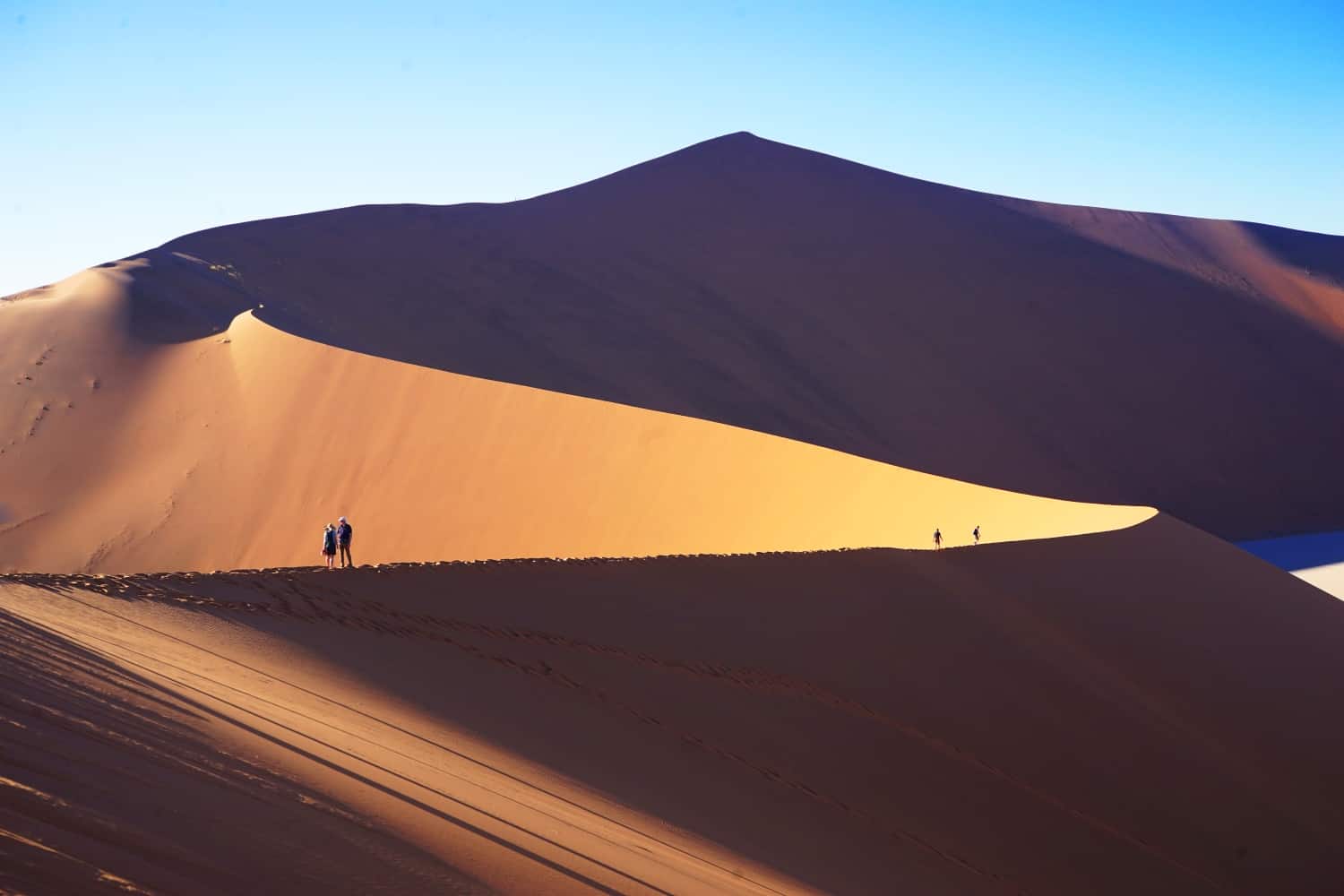
Namibia: Expensive but Totally Worth It!
I get it: Namibia is totally a hard sell when it’s so goddamn expensive, but guys, if you have the means to visit, it’s 100% worth the splurge. I promise you’ll have the absolute time of your life there.
And if you’re cool with camping, you’ll most likely end up spending half as much as I did within the country.
Where’s the most expensive country you’ve ever travelled to?
Related Articles on Namibia 🇳🇦 What’s it Like to Travel in Namibia? 🦛 The Perfect First Day in Namibia 🐘 Desperately Seeking Elephants in Etosha National Park 🏜 Finding Paradise in Vingerklip: Africa’s Monument Valley 🦭 Seals, Swakopmund, and the Skeleton Coast 🥾 Climbing Big Daddy: An African Travel Highlight 🏚 Exploring Kolmanskop: Namibia’s Ghost Town in the Desert
How useful was this post?
Click on a star to rate it!
Average rating 5 / 5. Vote count: 1
No votes so far! Be the first to rate this post.
Thanks so much!
You can follow along on my travels through my social media accounts below
Sorry you didn't find this article useful!
Help me improve it by leaving your comments below
All feedback is anonymous and emailed directly to me. If there's anything I can do to improve the quality of this article, please do let me know and I'll make the suggested changes within 24 hours
Lauren Juliff
Lauren Juliff is a published author and travel expert who founded Never Ending Footsteps in 2011. She has spent over 12 years travelling the world, sharing in-depth advice from more than 100 countries across six continents. Lauren's travel advice has been featured in publications like the BBC, Wall Street Journal, USA Today, and Cosmopolitan, and her work is read by 200,000 readers each month. Her travel memoir can be found in bookstores across the planet.
Related Posts

The Cost of Travel in Mauritius: My Detailed Budget Breakdown

The Cost of Travel in Thailand: My Detailed Budget Breakdown

2023: My Travels in Review

How to Spend One Week in Mauritius: An Itinerary for First-Time Visitors

The Cost of Travel in South Korea: My 2024 Budget Breakdown
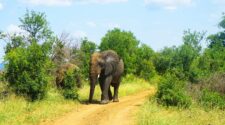
Why You Need to Take a Game Drive in Swaziland/eSwatini
66 comments.
Yikes – pretty high priced for a solo traveler, but nothing seemed all that bad when being split between a couple. In fact, it was roughly the price of an all-inclusive resort type of vacation, but what a vastly different and amazing experience!
The high car accident death rate is a little scary, though. However, I’d want to see why before making any judgement on that.
Also, I’m with you on spending extra on malaria pills to skip taking an antibiotic.
Yes! I guess that’s true — I’ve never done the all-inclusive thing, so it was pretty expensive compared to my normal budget of around $50 a day. But so worth it!
The car crashes are mostly due to people speeding on the gravel roads. In fact, our rental car was fitted with a speed sensor that would alert the hire company if we ever went over the speed limit, and then we wouldn’t have been covered by insurance. As long as you stay under the speed limit, you drastically reduce your risk of anything going wrong.
after reading your posts on Namibia, you absolutely convinced me to go there in November, although I am a bit concerned about the fact that it might be rainy..
Can you share you high level itinerary for your 2-weeks stay in the country?
Ovita: 1 night Halali: 2 nights Okaukuejo: 1 night Vingerklip: 1 night Swakopmund: 3 nights Sesriem: 2 nights Betta Camp: 1 night Kairos: 1 night Maltahohe: 1 night
And all the accommodation is linked in the post
It seems quite cheap to me.try to have the same holiday in Europe and you will spend three times the price. Also, I have never been in a trip where my most expensive meal was 20$ – this would rather be one the low side of dinner.
Yes, being European myself, and having travelled to every country in Europe, I’m aware of the costs of a holiday in Europe.
Keep in mind that prices for Namibia do double during high season, though — so a $120 a night guesthouse could easily grow to $260 a night in the most popular month to visit. And the main difference between Namibia expenses and European expenses is that the properties I included in this article are the cheapest ones in the entire country! In European cities, you can stay in hostels and cheap guesthouses for $20-50 a night; you can take public transport to save money, eat street food, etc — those options simply don’t exist in Namibia.
But perhaps I take a more global view to these articles. I have around 80 budget breakdowns on this site, for countries all around the world! It’s not unusual to pay $1-2 for dinner in the vast majority of the non-Western world, making $20 for dinner relatively expensive. If you hail from Europe, then yes, that seems cheap; if you live in India, it’ll seem wildly overpriced. Relative to every country on the planet, Namibia is one of the most expensive ones — and if you usually travel on a budget, you probably can’t justify those costs.
I’m surprised it was so expensive. The prices don’t look too bad though! I’m sure it was totally worth it anyway.
-Rachel @ Backcountry Petite
Yep, definitely worth it! Just a shame there aren’t any real budget options for backpackers in the country — some hostels or $30 a night guesthouses would make it a much more attainable destination for a lot of people.
This sounds like an amazing experience. I hope you share more photos on Instagram! The thing I’d be most afraid of is flooding my body with so many preventative pills. Did you experience any weird side effects?
Would you prefer to die from malaria? Because that’s the risk you take when avoiding taking the pills. That’s why it’s worth it for me. Never had any side effects from them and neither has Dave — Malarone is super safe and the doctor I saw at my travel clinic said she’s never heard of anyone having any side effects from taking it.
Malaria can be fatal. The pills are safe. This is a non-negotiable, as far as I’m concerned. I am a doctor.
I have taken Malarone (a proprietary combination medication) for maybe 4 trips. I have not had malaria. I got zero side effects. I gave it to my son when he was 8 years old. He got a couple of bloody noses that were very mild while taking Malarone. He did not get malaria.
Malaria is in the top-10 causes of death in the world. It is more preventable than it is treatable. Don’t be an idiot.
Perfect post, Laura! I went to Namibia in October last year and spent similar amounts to you two. It’s not cheap for backpackers but as you say, it’s worth it.
Absolutely :-)
Thanks a lot for the detailed budget split, we are planning to do a self drive around Namibia around next year and its a very nice intro how much its going to cost us, we need to start saving up from now onwards :)
Oh, perfect! Glad it could be of use for you guys :-)
Honestly, I`m not surprised it`s been expensive (these in-the-middle-of-nowhere lodges always are in Africa). What amazes me is that there`s actually a fare for visiting the ghost town (even an additional fare to take photos). How can they charge you for visiting an abandoned place?
Kolmanskop is in a restricted area of Namibia, so you have to pay for a permit in order to enter the area and see it.
I see. They`ve found a way to get some extra money from tourists ;)
Yup! Although the money does go towards renovating the town, which has positives and negatives. It stops it from falling apart, but also makes it look weirdly brand new in some buildings.
Yikes indeed! I know that Africa is general is an expensive country to travel in but this is more than I thought it would be. I have only traveled in Lesotho, Egypt and South Africa in Africa, and would love to travel to Tanzania, Mozambique and Madagascar but I think I will be putting it off until a point when I am earning more. Thanks for the cost break-down.
Yeah, you could definitely do it for cheaper if you were happy to camp, but other than that, it works out to be pretty expensive!
Love you budget breakdowns Lauren! Namibia sounds a bit too expensive for me right now (don’t want to camp either!) so I’ll save my visit for when I’m earning more money. Looks fabulous though!
Yeah, if you don’t want to camp, your options are pretty limited. You could take buses between the major cities and towns, but you’d be preventing yourself from seeing what makes Namibia so great: the desert lodges in the middle of nowhere. They were one of my biggest highlights from Namibia, so I wouldn’t recommend skipping over them to save some money.
Namibia is one place I’ve always wanted to visit. Thank you so much for the interesting budget breakdown. It’ll be helpful when I finally go to Namibia.
Glad you found it helpful, Shawna!
This is actually a really useful post. What are your thoughts on staying outside of Etosha National Park to save money on the expensive lodges within the park? I don’t want to lessen our experience there, but we can save a lot of money through doing that.
Good question! I have to say that I felt the lodges within Etosha offered the worst value for money on our trip. But at the same time, they weren’t terrible and there were a lot of advantages to staying inside the park. For starters, you get to start exploring at sunrise without having to queue up at the gates at the entrance, so you see more animals, which are more active in the morning. And on top of that, the lodges within the park have waterholes you can sit at all day for easier animal viewing.
So overall, it probably won’t be as kickass if you stay outside the park, but I’d imagine you’d still see plenty of animals and have an amazing experience if you did opt for that.
How much would it be likely to cost if you wanted to travel around on the tightest budget possible? So, camping or dorms, etc?
Transportation will be your highest cost, as we went for the cheapest option and it was $35 a day. Camping will be less, ranging from a few dollars a night to $35 a night in some places, and food can be done on the cheap if you grab snacks from the supermarket or eat only in the towns/cities, rather than the lodges. With that in mind, I’d estimate you’d spend around $50 per person a day if you were trying to do it as cheaply as possible.
Incredible guide, Lauren. I’m really enjoying your detailed budget breakdowns you’ve been posting lately.
Thank you so much!
Namibia is amazing and I hope this post doesn’t put people off. I traveled during low season with a tent and thus saved a ton of money by camping most of the time. But there ARE hostels and cheaper places to stay if you look for them – you won’t find all of them online. Element Riders in Ludderitz has dorm beds that were NAD100 when I was there (around $6 at the time); Amanzi Trails near the South African border had a chalet for $32; I stayed in $30-40/night hotels/B&Bs in Walvis Bay, Swakopmund, and Grootfontein and I think some campsites have simple rooms in the same price range. Some even give you access to a kitchen. The book Tracks4Africa is a good supplement to the Bradt guide for finding these options. For those with flexible schedules, the backpacker network on the ground is alive and well. In the few hostels that exist in Namibia and Botswana, people often hang around long enough to form a group to share car and camping gear hire costs then set off together.
Thanks for sharing, Marbree! I really appreciate it, and it’s great to hear it’s possible to visit for far cheaper than we did :-)
Yeah, sounds similar to how much we spent in Namibia. You can do it for cheaper if you camp or stay in the major towns and cities, but as you say, the best parts of Namibia are not those places! Great post.
Yeah, I definitely wouldn’t want to visit Namibia and just see the cities, as the small lodges in the middle of nowhere were a definite highlight for me.
$1583 was quite a good deal for a two weeks expedition in Namibia. I plan on visiting for a month before this year ends so found this very helpful. Thanks!
No problem! Hope you have a wonderful time there :-)
Great place and amazing ideas shared by you to visit Namibia.
Awesome read! Thanks for sharing.
Thanks for reading! :-)
This was so helpful. Going for exactly two weeks and seems like we travel in a similar style. THANK YOU!
Yay! Hope you have an amazing time, Erin! :-)
Hi Lauren, nice entry. I thought Namibia must be crazy expensive if you do not camp. We recently traveled in Namibia for 10 weeks our monthly budget was Total: NAD24013/US$1770 or average NAD400/US$30 per person per day. I am South African so we drove our own car and we camped the whole way making it a lot cheaper! Many travelers rent a 4×4 with rooftop tent starting from about $75 per day, this includes camping gear, but obviously not petrol. I do not want to post links on your blog, but we did write an Namibia Road Trip ebook, that could be helpful to anyone going that way.
Right. Most people aren’t going to have their own car, though, so it’s not super helpful for non-South Africans.
Perfect advice. Have seen a lot of articles on Namibia on a budget but most of these are by authors who are driving their own vehicle across the country. Doesn’t count! Appreciate your review with a traveler’s perspective.
Thanks so much, Ben! I agree — most visitors to Namibia are not going to have their own transport, and that’s really going to increase their costs.
What’s your take on hiring a car vs hiring a car with a driver/guide? I’ve been reading mixed reviews, with some people recommending avoiding self drive at all costs (driving on the left, long distances in sparsely populated areas, gravel roads, spotty reception), while others rave about it. We’re a couple planning on going next year for two weeks and the quotes I’ve been given for a tailor made tour are way to expensive for us.
I personally would have avoided taking a driver, but that’s because my boyfriend could tackle the roads without much of an issue. I guess it depends on how confident you feel about driving over gravel, and how much money you’ll save with that option. But I definitely wouldn’t say to avoid it at all costs — it was one of the best parts of being in Namibia, and I loved feeling as though my boyfriend and I were the only two people in the world.
In a country you were new in, how hard was it driving yourselves around. You ever missed your way?
I cover that in my Namibia travel guide! :-)
Was it safe to travel there? And what is the best time?
We are planning to go there in August.
Really, really safe! Outside of Windhoek you really don’t need to worry about anything. August is a great month! You’ll see a ton of animals at Etosha, but keep in mind it’ll likely be pretty chilly too.
Many thanks for the guidance Lauren, much appreciated.
My wife and I are booked on a month-long 4×4 adventure im Arch 2019 and are staying at or close to some of the locations you mention. Whilst we may have longer we know that there are so many places and things to see in Namibia. I do have a couple of questions:
1. What are the most memorable places any visitor should see in Namibia? 2. I’ve heard but not confirmed that US dollars are also useful currency, true?
Hi Lauren, Would you recommend traveling to Namibia with kids? My husband and I have been dreaming of visiting Namibia for years but wanted to wait until the kids were a bit older. They are 11 and 12. Did you see many traveling families on your journey? Thanks!
Oh, yeah, definitely! It’s such a safe country and I think they’d really enjoy seeing the animals. I saw lots of families.
Hi Lauren I’ve heard that you need to have cash and that credit cards aren’t accepted in most places. Did you find this the case? Are there ATM’s in most country towns?
I read someone here saying that Africa is an expensive country to travel to. Please, people, Africa is a continent with 54 countries and not a country! They have many different cultures in one continent, different places, different conditions, different prices.
Yes! It’s one of the most diverse continents on the planet. Namibia is nothing like Morocco is nothing like Mozambique is nothing like Ghana is nothing like Ethiopia.
Hi, thanks for sharing your experience! I`m planning to visit Namibia with my family and friends in February next year , but I`ve read that this isn`t the best time because of the rain and hot temperatures. I know South Africa`s summer (which is the best time to visit SA according to my experience). Is Namibia similar? We plan to land in Windhoek, then drive North to Etosha, West to Damaraland and South to Swakopmund and continue South to Sesriem. SO, basically, kind of following your path.. What do you think about the timing?
Hi Maryla! I went in March and personally didn’t find the temperatures to be too hot, and also only had one day of rain. Of course, this is just an anecdote rather than evidence that the same will be true for you. But I didn’t feel like I visited at a terrible time of year. I wouldn’t let it put you off. Oh, and the added bonus is that the prices of accommodation will be discounted by as much as 50% in February.
The only thing I would say is that Etosha is likely to be a disappointment. I wrote a blog post about visiting in the rainy season and shared that it was a struggle to see anything while we were there. The grasses are long, the animals avoid the waterholes, and you tend to end up spending hours just driving around seeing very little.
Hi Guys. This is kondja, born and bred in Namibia.
I love Lauren’s article so much, it reflects the truth about traveling in namibia. The trick you all dont know is that when you foreigners make bookings yourselves, the prices are most likely to be inflated. Also you guys rely mostly on booking online, which is mostly expensive, thirdly you guys use USD, again, inflated. You would save more money if you have a local friend to do bookings for you. Ofcoz its difficult to trust a stranger, but you can always get hold of someone working at the tour guide operators to assist you.
Try that and see how much you would save.
Im glad you guys love to visit our beautiful country. We are peace loving people. in Africa, Namibia is one of the safest countries, and also one of the cleanest.
Amazing breakdown on the travel details for Namibia.
I have been in liaison with several tour operators for travel fixing across the country or even just based in one location, i.e Etosha, but the charges are extortionate ! For a seven day quote with private vehicle and guide cost only, this comes up close to $US 4000 and excludes lodging and various misc fees.
We are a party of two on a twin sharing basis, but this quotations still seem rather absurd whichever way one looks as it. I’ve traveled through Sub Saharan Africa on multiple occasions before, but somehow these private quotes for Namibia are somewhat outrageous, even more so than Botswana which I understand to be the costliest of the lot of African countries for a safari venture.
We are apprehensive of a self drive method and ideally would like to be driven, what’s your take here ?
Thanks and Regards,
I’d definitely recommend going for a self-drive, as $4000 excluding accommodation is outrageously expensive! Yes, the roads are bad, but if you take things slow, you should be fine.
SO HELPFUL! Thank you! I can’t believe how expensive it is but I know it’s going to be worth it.
Hi Lauren, is it correct that you cost of travel for Namibia relates to 2917 and not as stated in the titel to 2023?! Asking as we are looking to travel this year and I guess the pandemic situation has raised prices immensly. Thx.
Nope, prices are for 2023. Which prices are you seeing as having increased? I had a quick look and everything seemed to be accurate. (Don’t forget that we visited during the low, wet season, so prices were cheaper).
Hi Lauren. Thanks for sharing this fantastic information. We are in the very early stages of planning for June 2024 and are torn between self-drive and going with a group. When I look at car hire, many of the general conditions mention that cars can’t be driven on gravel roads. Is this an issue in Namibia where most of the roads seem to be gravel or do the car companies not worry about this? Thanks
Leave a reply Cancel reply
Your email address will not be published. Required fields are marked *
Meet Lauren Juliff
Update April 12, 2024
Information for u.s. citizens in the middle east.
- Travel Advisories |
- Contact Us |
- MyTravelGov |
Find U.S. Embassies & Consulates
Travel.state.gov, congressional liaison, special issuance agency, u.s. passports, international travel, intercountry adoption, international parental child abduction, records and authentications, popular links, travel advisories, mytravelgov, stay connected, legal resources, legal information, info for u.s. law enforcement, replace or certify documents.
Share this page:
Namibia Travel Advisory
Travel advisory november 27, 2023, namibia - level 2: exercise increased caution.
Last Update: Reissued with updates to crime.
Exercise increased caution in Namibia due to crime .
Country Summary : Petty crime, such as pickpocketing, purse snatching, and "smash-and-grab" attacks on vehicles, is increasingly common, and these can violently escalate into robberies and muggings. There is a higher risk of crime in the central business districts of major cities after dark.
Read the country information page for additional information on travel to Namibia.
If you decide to travel to Namibia:
- Avoid walking alone, especially after dark.
- Do not display large amounts of cash or other valuables.
- Keep car doors locked and windows shut at all times.
- Be cautious of people appearing to request assistance by the side of the road.
- Use ATMs located in well-lit public places or inside a bank or other business and be cautious of anyone offering assistance in using the ATM.
- Always carry a copy of your U.S. passport and Namibian visa or entry stamp (if applicable). Keep original documents in a secure location.
- Enroll in the Smart Traveler Enrollment Program ( STEP ) to receive Alerts and make it easier to locate you in an emergency.
- Follow the Department of State on Facebook and X .
- Review the Country Security Report for Namibia.
- Prepare a contingency plan for emergency situations. Review the Traveler’s Checklist
- Visit the CDC page for the latest Travel Health Information related to your travel.
Travel Advisory Levels
Assistance for u.s. citizens, namibia map, search for travel advisories, external link.
You are about to leave travel.state.gov for an external website that is not maintained by the U.S. Department of State.
Links to external websites are provided as a convenience and should not be construed as an endorsement by the U.S. Department of State of the views or products contained therein. If you wish to remain on travel.state.gov, click the "cancel" message.
You are about to visit:
Normal 0 false false false EN-US X-NONE X-NONE /* Style Definitions */ table.MsoNormalTable {mso-style-name:"Table Normal"; mso-tstyle-rowband-size:0; mso-tstyle-colband-size:0; mso-style-noshow:yes; mso-style-priority:99; mso-style-parent:""; mso-padding-alt:0in 5.4pt 0in 5.4pt; mso-para-margin:0in; line-height:115%; mso-pagination:widow-orphan; font-size:11.0pt; font-family:"Arial",sans-serif; mso-ansi-language:EN;} Plug For Namibia: What You Need To Know
Normal 0 false false false false EN-US X-NONE X-NONE
What is the plug for Namibia? Before you travel, check the information below to make sure your electronic devices are compatible with the outlet type and voltage.
Electrical Summary
Namibia uses outlet types D, M at a voltage of 230V and a frequency of 50 Hz.
Plug Compatibility: Type D, Type M
Voltage: 230V
Frequency: 50 Hz

Can North Americans use Electronics in Namibia without an Adapter?
No! North Americans will need an adapter for the outlets and a transformer for the voltage when traveling to Namibia . North Americans device plugs will not work with the outlet types in Namibia . Also, the voltage in Namibia is different from North American voltages.
Can Europeans use Electronics in Namibia without an adapter?
No! Most Europeans will need a travel adapter when traveling to Namibia . Most device plugs will not work with the outlet types in Namibia . However, the voltage in Namibia is the same as in Europe.
What Outlet does Namibia Use?
Normal 0 false false false EN-US X-NONE X-NONE
Type D plug sockets have two round pins and a grounding pin. These plugs are typically used with devices that have a voltage of 230V.
Type M plug sockets have three round pins, similar to type D plug sockets. These plugs are typically used with devices that have a voltage of 230V.
Is it safe to drink water in Namibia?
To be on the safe side, you can use common precautions such as boiling tap water for at least one minute, using water purification tablets, or drinking bottled water. It’s also important to note that ice may be made from tap water and that foods may be washed or prepared with tap water.
We recommend always packing a filtered water bottle when traveling:
Travel Essentials
Be sure to check our list of travel essentials before your trip!
Recommended Travel Essentials
Should I get travel insurance when traveling to Namibia?
It is generally recommended to get travel insurance when traveling to a different country. Travel insurance can provide financial protection and peace of mind in case of unexpected events, such as medical emergencies, trip cancellations, lost or stolen baggage, or other travel-related mishaps.
Travel insurance can cover various expenses related to your trip, such as medical expenses, emergency medical transportation, trip cancellation or interruption, lost or stolen baggage or personal belongings, and other travel-related expenses.
Before purchasing travel insurance, it’s important to carefully review the policy details, including the coverage limits, exclusions, and any applicable deductibles or copays. You should also make sure that the policy covers any activities or destinations that you plan to participate in or visit during your trip.
Travel Summary
Namibia is a southwestern African country known for its vast landscapes, wildlife, and rich cultural heritage. It is home to some of Africa’s most breathtaking natural wonders, including the Namib Desert, Etosha National Park, and the Skeleton Coast.
Namibia’s diverse cultures and languages offer a unique experience for travelers seeking cultural immersion. Visitors can explore the Himba tribe’s lifestyle, visit the Herero people, and witness the San people’s traditions.
Wildlife enthusiasts can enjoy some of the most extraordinary wildlife experiences in the world. Etosha National Park is one of the top attractions, where visitors can observe lions, elephants, and rhinos in their natural habitat.
Namibia is also famous for its adventure tourism. Adventure seekers can embark on a range of activities, including sandboarding, dune-bashing, and hot air ballooning. The Fish River Canyon and Skeleton Coast offer a unique hiking and trekking experience.
The capital city of Windhoek offers visitors a vibrant urban experience with a mixture of old colonial architecture and modern buildings. The city is known for its nightlife, local cuisine, and arts and crafts markets.
Overall, Namibia is a country full of adventure, cultural immersion, and natural wonders that are sure to leave visitors with unforgettable memories.
Traveling to another country? Check out our Countries page for more info.
Puzzle solutions for Sunday, April 21, 2024
Note: Most subscribers have some, but not all, of the puzzles that correspond to the following set of solutions for their local newspaper.
USA TODAY crossword
Play the USA TODAY Crossword Puzzle .
Sunday Los Angeles Times crossword
Sunday new york times crossword, sunday premier crossword.
Play the USA TODAY Sudoku Game .
Answer: SPLINT QUENCH IDIOCY SHAKEN JUGGLE INWARD
For PBA Hall of Famer Earl Anthony, bowling left-handed was — RIGHT UP HIS ALLEY
(Distributed by Tribune Content Agency)
I RECKON IF A POOCH IS CHOMPING ON A FRANKFURTER, ONE MIGHT CONSIDER THAT A DOG-EAT-DOG SITUATION.
(Distributed by King Features)
OTHER PUZZLES
SPAIN BRAZIL CANADA LIBERIA ICELAND IRELAND PORTUGAL
FEVER, REFERENCES, SERIES, SEIZE, EDIFIED
(Distributed by Andrews McMeel)
Scrabblegrams
7 little words, find the words.
Sweet and savoury blast
(Distributed by Creators Syndicate)

COMMENTS
Namibia, December 2023. 513 34. Find the best posts and communities about Namibia (travel) on Reddit.
You can hit up the Namibian desert for sand dune climbing at sunrise. There are beaches and coastlines full of shipwrecks to explore. The darkest skies in the world are in Namibia, so the Milky Way is always shining brightly above your head at night. Oh, and there's a ghost town in the middle of the desert. Badass.
Namibia really is empty…. You don't have to try very hard to get way, way away from all evidence of humanity in Namibia. And this abundant absence of human influence, sound, light pollution, and cell phone reception soothes your soul. We even had Deadvlei, one of Namibia's top three tourist attractions, 100% to ourselves.
14 Days,72 Hours Driving,4,274 Kilometers,and Only 1 Big Complaint. This Namibia blog shares the highlights, lowlights, and honest insights of our two-week itinerary. See our Namibia Travel Tips, Cape Town to Namibia Guide, and Is Namibia Worth Visiting? for more trip-planning info.
In our opinion, the best and most cost effective to travel through Namibia is via a self-drive safari and camping. Not only do you have the freedom to do what you want, you can also stay at any of the thousands of aforementioned campsites. It's a far easier option, especially during the super busy peak season.
NAMIBIA TRAVEL TIPS | DRIVING IN NAMIBIA--#15 NAMIBIA IS THE PERFECT ROAD TRIP DESTINATION. Namibia is vast, which we're sure you're now aware of. Because of this, it's the perfect destination for an epic road trip. The beauty of road tripping through Namibia is having the freedom to travel at your own pace, and go wherever you want to go.
Since the first estimate took place for tourist numbers took place in 1989 (100,000), it increased tenfold by 2014, with 1,176,000 tourists to the country. We'll end with this fact: The Global Peace Index of 2019 ranks Namibia joint-60th in the world (out 163 countries measured), alongside France!
The land area of Namibia is slightly over 800.000 km2 (twice the size of Germany), making it a fairly large country to travel in. Most of the highlights of Namibia are spread out all over the country and in order to see the main attractions, you will have some pretty long driving distances.
The average site costs US$30 (or US$10 per person) and has shared bathrooms, hot showers and fire pits with grills at each spot. Some camps even have shops selling food, water and other basic provisions. 7. Mix it up by staying in budget lodges and self-catering apartments. Budget lodges are plentiful in Namibia.
keep reading | how to travel in southern africa. #7 EXPLORE CREEPY KOLMANSKOP | BEST PLACES TO VISIT IN NAMIBIA. Once a small yet extremely wealthy diamond mining community, today Kolmanskop is an eerie ghost townlong abandoned by time and slowly sinking back into the sand of the Namib desert.
1 week in Namibia itinerary - 7 days of stunning scenery. Updated: Feb 20, 2021. Ok, let me start off by saying straight away: 1 week is not nearly enough time spent in Namibia! This remarkable country is filled with once-in-a-lifetime experiences. From typically African exotic wildlife safaris to the world's second largest canyon.
The best time to visit Namibia is in the Dry season from June to October, although it can be visited throughout the year. Wildlife viewing in all parks, but especially in Etosha, is best in the Dry season. The climate is generally dry and pleasant. Between December and March, some days will be humid and rain may follow, often in localized ...
The Rough Guides to Namibia and related travel guides. In-depth, easy-to-use travel guides filled with expert advice. Buy US$25.99. Buy US$34.99. Buy US$34.99. Travel advice for Namibia. From travel safety to visa requirements, discover the best tips for traveling to Namibia.
A seal-watching tour in Walvis Bay : $70 (N$1320) Entrance to Kolmanskop ghost town + photography permit: $19 (N$350) Entrance to Etosha National Park: $8 (N$150) per day. Entrance to Sossusvlei: $8 (N$150) The total cost of my activities and entrance fees in Namibia over two weeks was: $121.
Then there is the stark, deserted Skeleton Coast—not a wildlife destination, but unique in the world. Kenya is a typical first safari destination and it was mine and I'm planning a 5th trip ...
Travel Advisory. November 27, 2023. Namibia - Level 2: Exercise Increased Caution. C. Last Update: Reissued with updates to crime. Exercise increased caution in Namibia due to crime. Country Summary: Petty crime, such as pickpocketing, purse snatching, and "smash-and-grab" attacks on vehicles, is increasingly common, and these can violently ...
What Outlet does Namibia Use? Type D. Type D plug sockets have two round pins and a grounding pin. These plugs are typically used with devices that have a voltage of 230V. Type M. Type M plug sockets have three round pins, similar to type D plug sockets. These plugs are typically used with devices that have a voltage of 230V.
Note: Most subscribers have some, but not all, of the puzzles that correspond to the following set of solutions for their local newspaper. CROSSWORDS